
Home » Travel Guides » Armenia » 15 Best Places to Visit in Armenia

15 Best Places to Visit in Armenia
Armenia is becoming an increasingly popular tourist attraction, with the small but charming nation boasting a rich history.
Armenia, which was the first country to declare Christianity as its national religion, boasts some of Europe’s most stunning views, with the peak of Mount Ararat dominating the country’s skyline. The mountain is Armenia’s national symbol despite its peak lying just over the Turkish border and Ararat is considered holy by locals due to its mention in The Bible – it is where Noah’s Ark landed.
Armenia is home to countless beautiful monasteries and they are often found in areas of truly outstanding natural beauty. Armenia’s capital, Yerevan, is one of the most rapidly developing cities in the whole of Europe as the nation continues to embrace tourism. Let’s have a look at the best places to visit in Armenia !

By far the largest city in Armenia, the capital Yerevan is a great place to start for anyone wishing to explore Armenia. The city is home to the grand Republic Square, while climbing the Cascade to see the city’s monument to Soviet victory in the Second World War is a must.
Yerevan is a deeply historic city and visiting the Armenian Genocide Memorial is a must to learn more about the nation’s troubled past. Vernissage market is worth visiting too – it is open at the weekend – while a walk through the Hrazdan gorge is also highly recommended.
Much of what Armenia has to offer can be explored during day trips from Yerevan, which is known as the City of Cafes.
Yerevan is also home to Blue Mosque, which is the only mosque in the whole of the country, as well as Levon’s Amazing Underground World, which is one of Europe’s most unusual attractions.
2. Shikahogh State Reserve

The second largest forest reserve in Armenia, Shikahogh State Reserve is so unspoiled that large parts of it remains unexplored to this day.
The forest is believed to be home to animals including leopards, bears, wild goats and vipers and it is also thought that Shikahogh State Reserve has about 1,100 species of plants, although its fauna has not yet been fully explored. The reserve was threatened by a planned highway in 2005, but environments successfully lobbied for the forest’s future to be protected.
The reserve also has a number of very beautiful waterfalls to enjoy.
3. Lake Sevan

Lake Sevan, found in the heart of Armenia, is the country’s largest lake and a beautiful place to visit during a break in the country. The lake is surrounded by some stunning monasteries – the most impressive of them being arguably the Sevanavank Monastery – providing a glorious scenic backdrop to a relaxing trip.
Windsurfing is among the recreation activities available at the lake, which also has a wide choice of excellent seafood restaurants along its shore.
Lake Sevan has a number of popular beaches and, as the country has no coastline, this is the best place in Armenia to sunbathe, with Sevan Bay and its surrounding mountains providing spectacular scenery.
4. Dilijan National Park

Armenia has four national parks and Dilijan national park may be the most beautiful of the lovely quartet. The park, which was only established in 2002, is famous for its medicinal mineral water springs, as well as its natural monuments.
Many of Armenia’s more important cultural locations can be found within the grounds of the park, such as Haghartsin Monastery, Goshavank Monastery and Jukhtak Vank, as well as Matosavank Monastery and the Akhnabat church.
The Aghestev and Getik river basins are also both within the boundaries of Dilijan national park.
5. Mount Aragats

Mount Aragats is one of Armenia’s most stunning natural sights, with the dormant volcano located in the north of the country. It is Armenia’s highest peak and there is a lot of rock art to be enjoyed around its base, with paintings of animals and human-like figures dating back hundreds of years.
Snow covers the peak almost all year-round but Mount Aragats can be climbed, with July, August and September the best times of the year to attempt the hike.
The southernmost of the four peaks is the easiest to climb, while the northern peak, at around 4,000 metres, is the most challenging.
6. Lake Arpi

While Lake Sevan can be extremely crowded during the peak tourist season, Lake Arpi has a much more relaxed feel.
Used for irrigation and hydropower production, Lake Arpi is also the source of the Akhurian River. In 2009 a new park was established around the lake to protect the natural environment, with around 100 species of birds known to live in the area. Lake Arpi also hosts rich flora and fauna and is a Ramsar Convention protected site.
Lake Arpi has one the largest colonies of Armenian Gull and its recreation activities include camping and walking tours.
7. Noravank
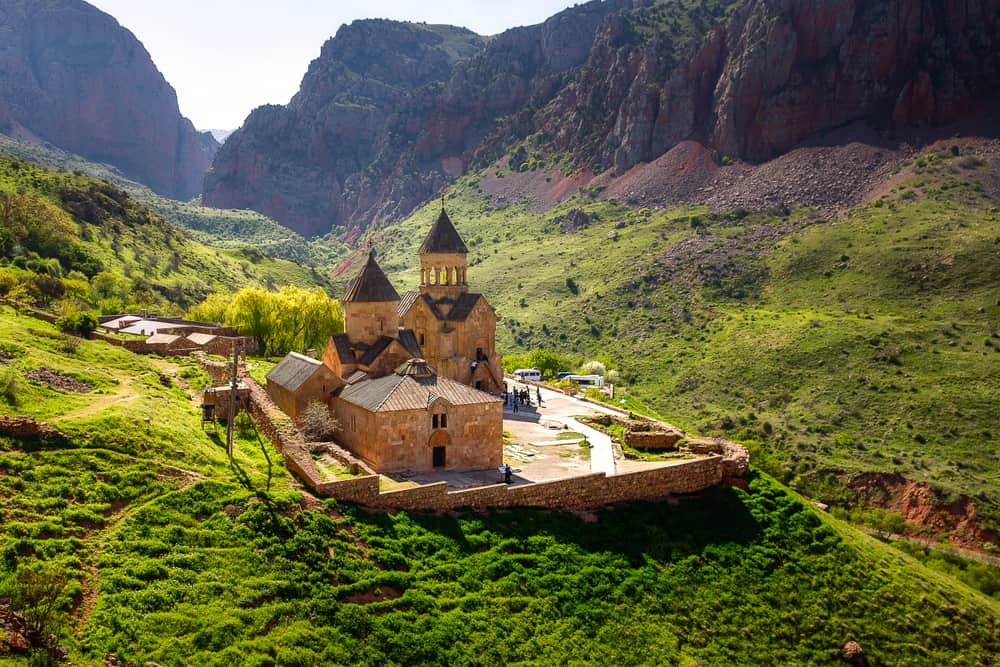
Monasteries are one of Armenia’s defining characteristics and the example at Noravank is one of the most beautiful in the whole country. Sheer brick-red cliffs shield the monastery, which was built in the 13th century.
Noravank is famous for its Astvatsatsin (Holy Mother of God) church, while the story goes that the monastery was saved by God himself when Armenia was conquered by the Mongols hundreds of years ago.
If you only choose to go to one monastery during a trip to Armenia, Noravank would be an extremely good selection – thousands of people visit every year.

The second largest city in Armenia, Gyumri is well worth a visit for anyone heading to the country for the first time. Perhaps the best place from which to enjoy the sights of Gyumri is from the Black Fortress on the hill that overlooks the city, while the massive Mother Armenia statue can also be found nearby.
Many of the most important cultural institutions of Armenia are in Gyumri, such as the Dzitoghtsyan Museum of Social Life and National Architecture of Gyumri, as well as the Aslamazyan Sisters House-Museum and the Sergey Merkurov House-Museum.
The Kumayri Historic District is Gyumri’s oldest area, with a thousand ancient buildings found here.
9. Vanadzor

Armenia’s third major city is Vanadzor, which is located in the north of the country. Vanadzor is an ideal base from which to explore the beautiful Lori region, which is certainly one of the best places to visit in Armenia.
The Vanadzor Botanical Garden is one of the finest tourist attractions in the city, while visitors should also consider checking out the Vanadzor fine art museum. The many mineral springs of the Lori region mean there are a wide range of terrific spas to enjoy in and around Vanadzor.
Although Vanadzor is primarily an industrial city, it also houses many theatres, such as the Bohem Chamber Theatre of Vanadzor and the Vanadzor Puppet Theatre.
10. Amberd Fortress

Dating back to the seventh century, Amberd Fortress is one of the most stunning places to visit in Armenia. Formerly among the Armenian Kingdom’s primary military-defensive points, the fortress can be reached in about an hour from the capital city Yerevan.
However, snowfall can make the fortress inaccessible during the winter months, with the weather usually improving by late May. The view from the top of the fortress is truly breathtaking, while the building itself is also stunning.
Amberd Fortress is a short trip from the village of Byurakan, home of the Byurakan Observatory.
11. Tsaghkadzor

Armenia’s mountainous scenery makes it ideal for winter sports and the country’s best ski resort can be found at Tsaghkadzor in the heart of the country. Ski lifts are paid for by the ride and are among the most affordable in Europe.
Tsaghkadzor boasts some of the finest hotels in the country, while the resort also has one of the nation’s biggest entertainment centers in the form of the Senator Royale casino complex.
Tsaghkadzor also has the Kecharis Monastery, which is one of Armenia’s most important religious complexes, dating back to the start of the 11th century.
12. Upper Azat Valley

The Upper Azat Valley is one of Armenia’s World Heritage Sites, partly due to the incredible Geghard Monastery for which the region is most famous. The main chapel was built 800 years ago but the history of the monastery goes all the way back to the fourth century, when it was founded by Gregory the Illuminator.
According to legend, the Geghard Monastery once housed one of the spears that was used to crucify Jesus Christ, brought to Armenia by Apostle Thaddeus, and as such it is one of Armenia’s most important religious sites.
The Upper Azat Valley is also home to the St Astvatsatsin (Holy Mother of God) chapel, which is partially carved out of the rock.
13. Karahunj Observatory

Often referred to internationally as Armenia’s version of Britain’s Stonehenge, Karahunj is one of the most fascinating places to visit during a break in Armenia.
Located close to the city of Sisian in the Syunik province, Karahunj is made up of well over 200 massive stone tombs, while the main area sees 40 stones standing in a circular formation, supposedly built in honour of the Armenian main God, Ari, named after the Sun.
A small museum in Sisian is dedicated to findings that have been made at Karahunj, which is claimed to be the oldest observatory of its kind in the world.
14. Khor Virap

Views of Mount Ararat can be enjoyed from all over Armenia, but perhaps the best scenery of the mountain can be found from the Khor Virap monastery, which is definitely also worth visiting in its own right.
This location is one of the most important historic sites in Armenia’s history as it was where Gregory the Illuminator was imprisoned for 14 years before he cured King Trdat III of his disease. The King then converted to Christianity, paving the way for Armenia’s religious future.
As such, Khor Virap is a popular spot for Armenian weddings today, while the underground chamber in which Gregory the Illuminator was held can be visited during a trip to Khor Virap, which is among Armenia’s most visited pilgrimage sites as a result.

Our final selection for the best places to visit in Armenia is Dvin, one of the country’s oldest cities – in fact, it was the capital of Armenia in medieval times. A sixth century BC fortress was also once situated in Dvin, according to Unesco, while incredible artefacts are regularly found in this part of Armenia.
More modern sights can also be enjoyed in the city, such as the St. Harutyun Church in Dvin, which was built in 2000.
Dvin once housed the Cathedral of St. Grigor, but all that remains of the building today is the stone foundations that have been uncovered by archeologists.
15 Best Places to Visit in Armenia:
- Shikahogh State Reserve
- Dilijan National Park
- Mount Aragats
- Amberd Fortress
- Tsaghkadzor
- Upper Azat Valley
- Karahunj Observatory
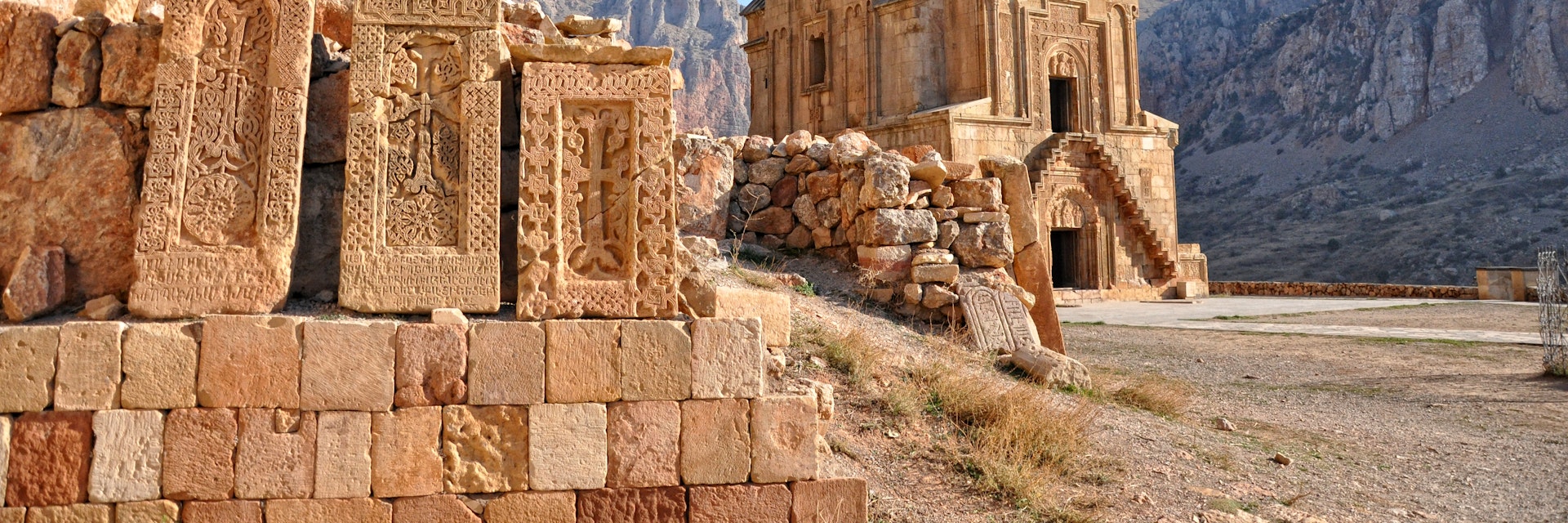
Few nations have histories as ancient, complex and laced with tragedy as Armenia (ՀԱՅԱՍՏԱՆ). And even fewer have a culture that is as rich and resilient. This is a destination where you will be intrigued by history, awed by monuments, amazed by the landscape and charmed by down-to-earth locals. It's not an easy place to explore – roads are rough, transport is often hard to navigate and those who don't speak Armenian or Russian may find communication difficult – but travelling here is as rewarding as it is revelatory.
Leave the planning to a local expert
Experience the real Armenia. Let a local expert handle the planning for you.
Attractions
Must-see attractions.
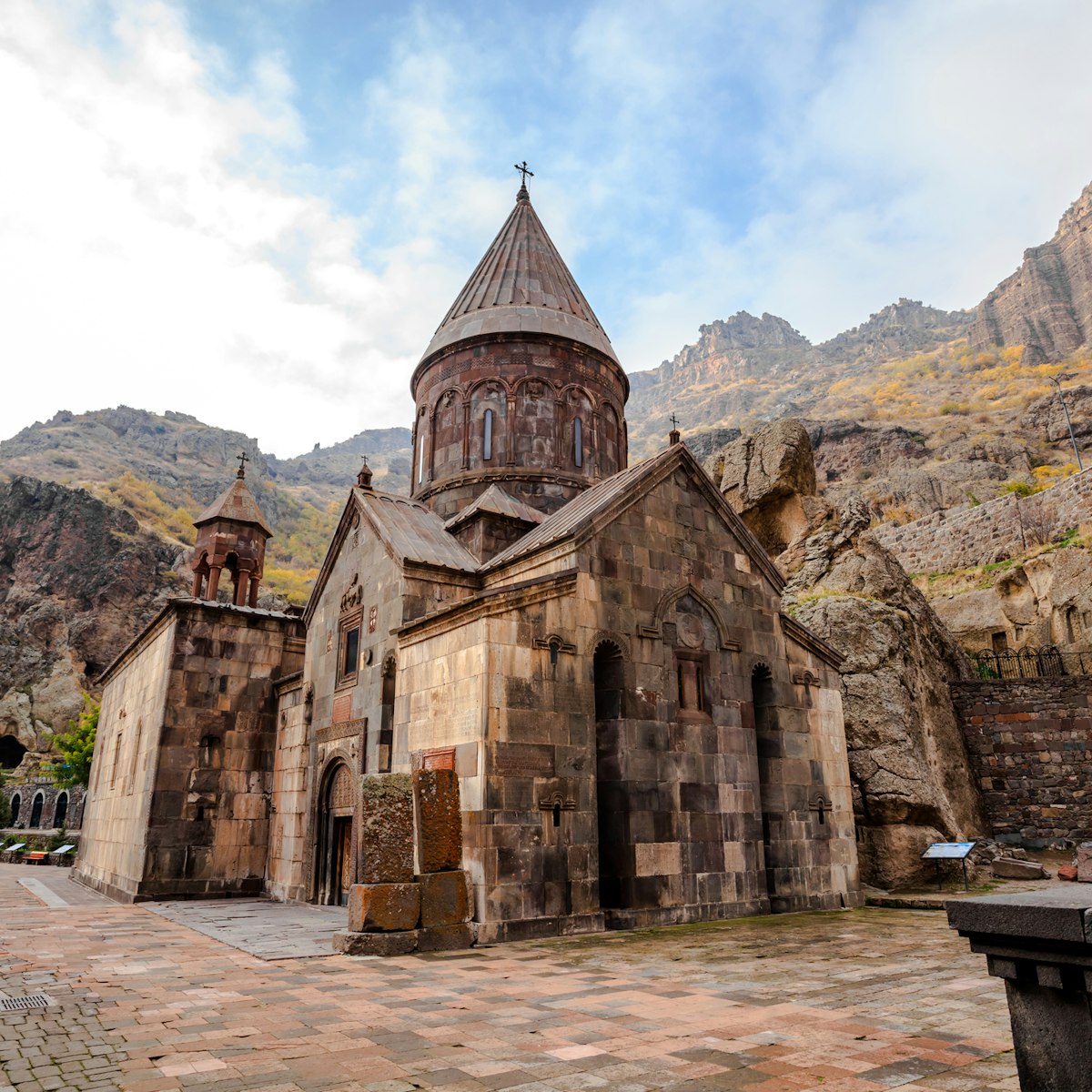
Geghard Monastery
Garni & Geghard
Named after the lance that pierced Christ’s side at the crucifixion (a shard is now on display at the museum in Etchmiadzin), this World Heritage–listed…

Armenian Genocide Memorial & Museum
Commemorating the massacre of Armenians in the Ottoman Empire from 1915 to 1922, this institution uses photographs, documents, reports and films to…
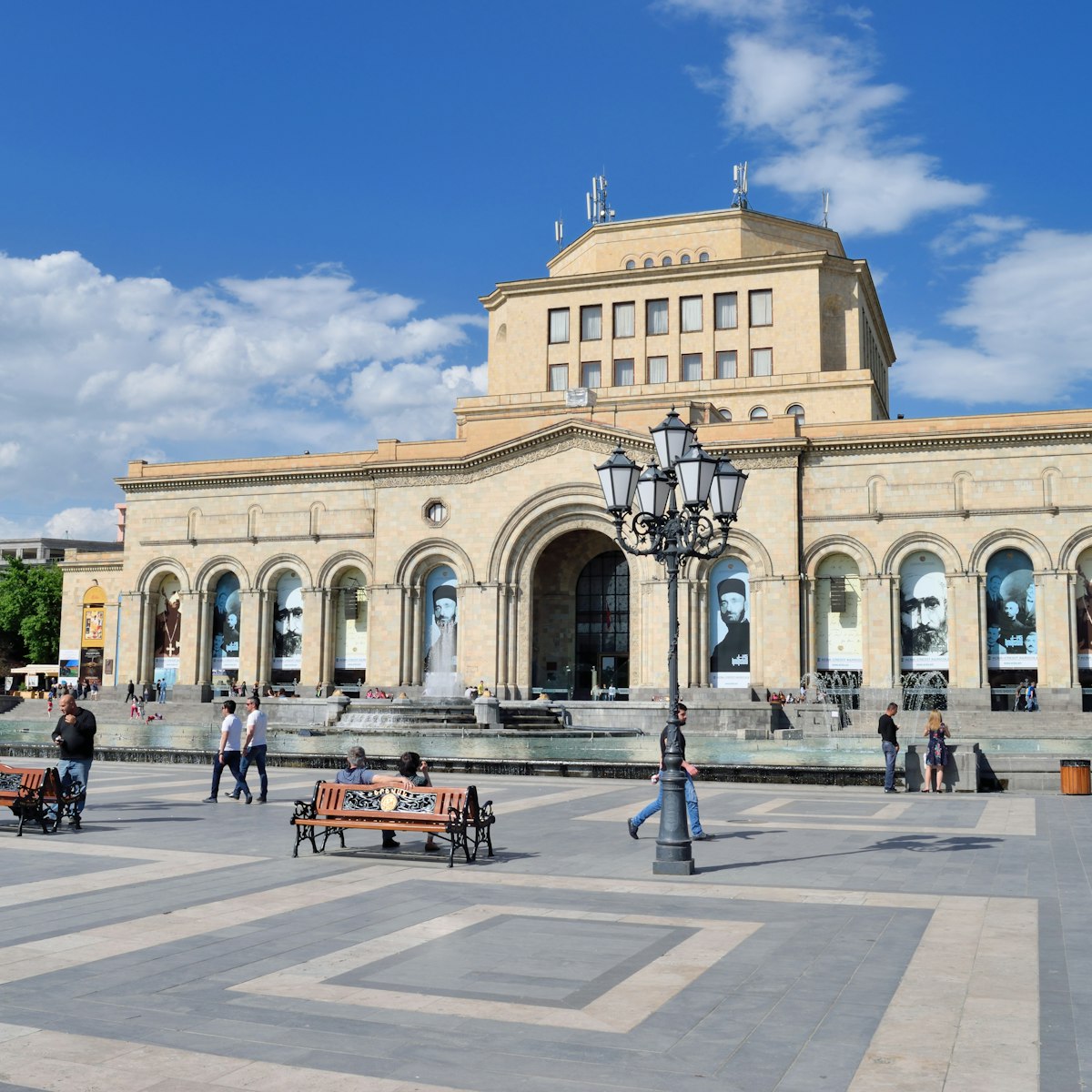
History Museum of Armenia
Its simply extraordinary collection of Bronze Age artefacts make this museum Armenia's pre-eminent cultural institution and an essential stop on every…

Founded by Bishop Hovhannes in 1205 and sensitively renovated in the 1990s, Noravank (New Monastery) is one of the most spectacular sites in Armenia and…

Garni Temple
Built by Armenia’s King Trdat I in the 1st century AD, this Hellenic-style temple set on the edge of a gorge overlooking the Azat River was dedicated to…

Old Khndzoresk
Dug into volcanic sandstone on the slopes of Khor Dzor (Deep Gorge), the village of Old Khndzoresk was inhabited as far back as the 13th century. By the…
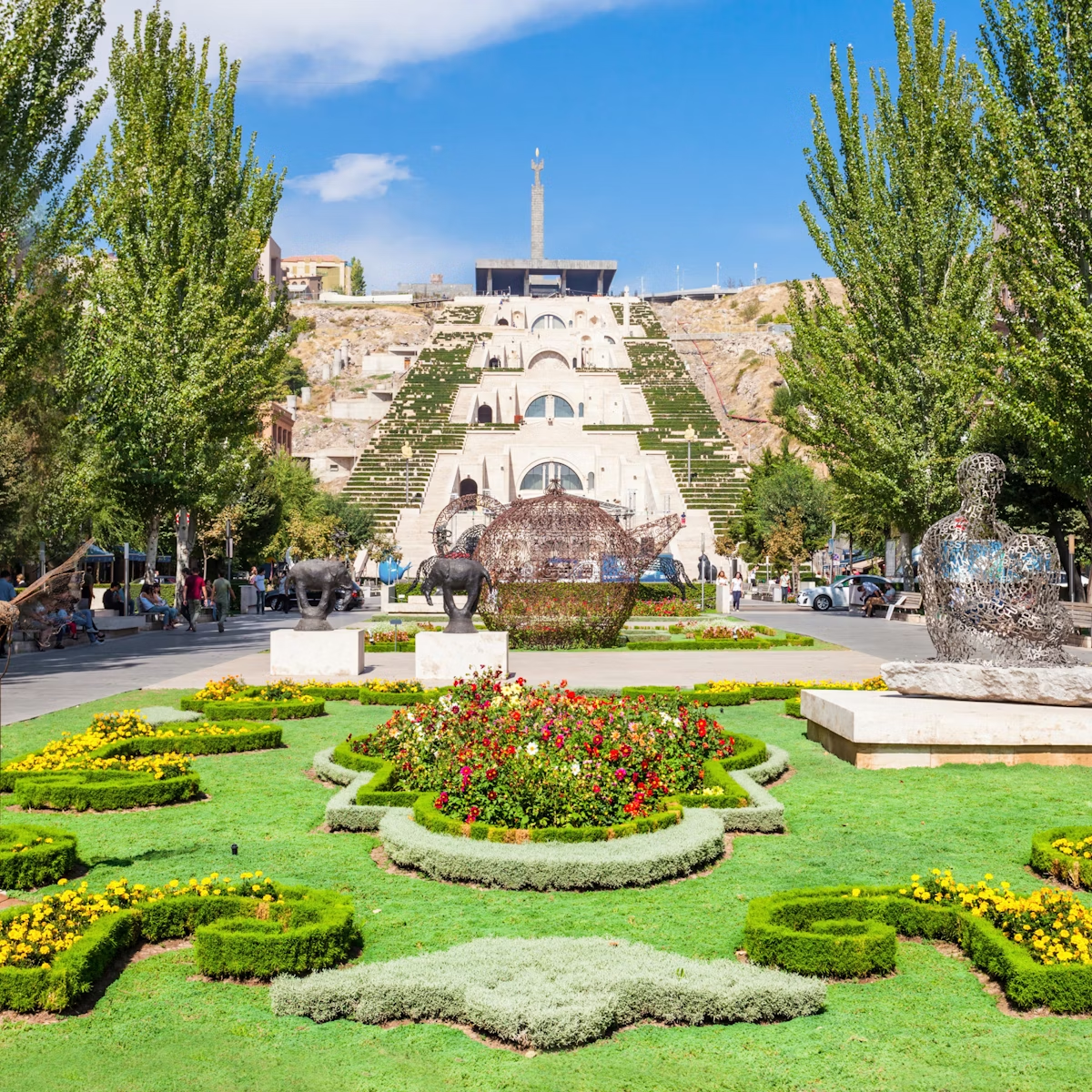
Cafesjian Center for the Arts
Housed in a vast flight of stone steps known as the Cascade, this arts centre is one of the city's major cultural attractions. Originally conceived in the…

Khor Virap Monastery
Located 32km south of Yerevan at the foot of Mt Ararat, Khor Virap has been repeatedly rebuilt since the 5th century. Legend says the pagan King Trdat III…
Plan with a local
Experience the real Armenia
Let a local expert craft your dream trip.
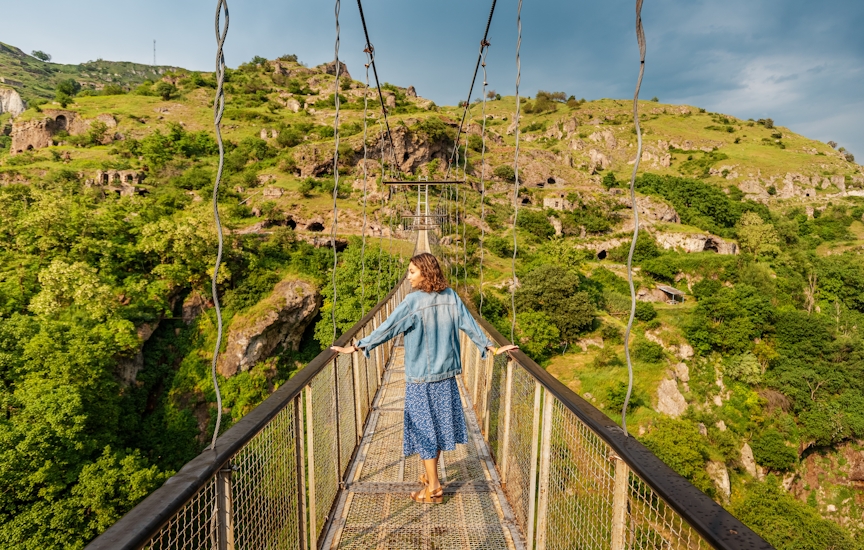
Latest stories from Armenia
Filter by interest:
- All Interests
- Adventure Travel
- Art & Culture
- Beaches, Coasts & Islands
- Food & Drink
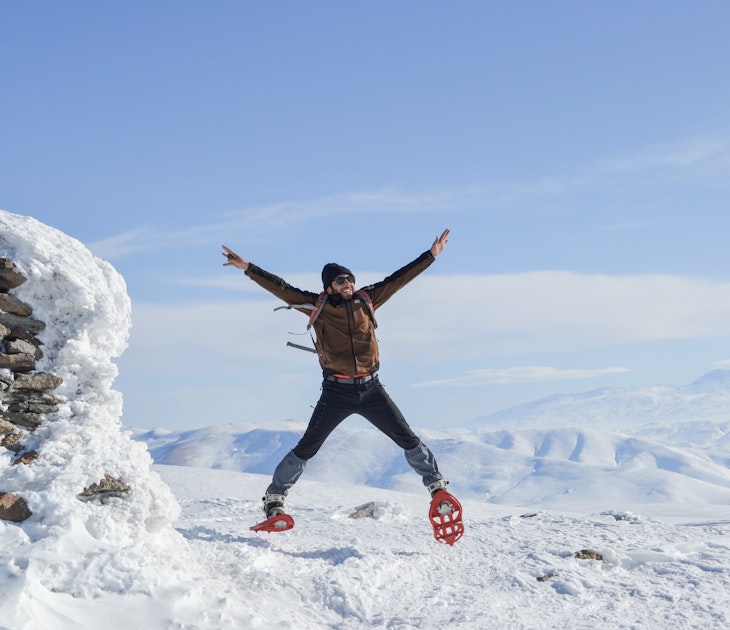
Jan 9, 2024 • 4 min read
Get help from a local expert to plan an unforgettable trip to Armenia.
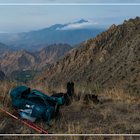
Apr 1, 2023 • 7 min read
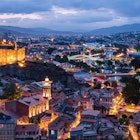
Nov 8, 2019 • 2 min read
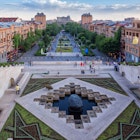
Oct 4, 2017 • 6 min read
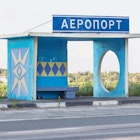
Apr 4, 2017 • 2 min read
in partnership with getyourguide
Book popular activities in Armenia
Purchase our award-winning guidebooks.
Get to the heart of Armenia with one of our in-depth, award-winning guidebooks, covering maps, itineraries, and expert guidance.
Armenia and beyond
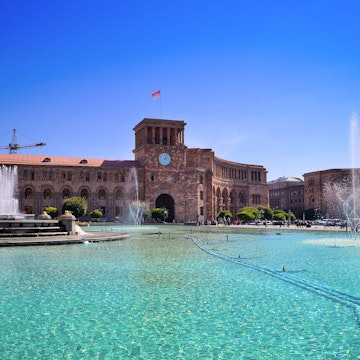
Nomadic Matt's Travel Site
Travel Better, Cheaper, Longer
Armenia Travel Guide
Last Updated: May 4, 2023
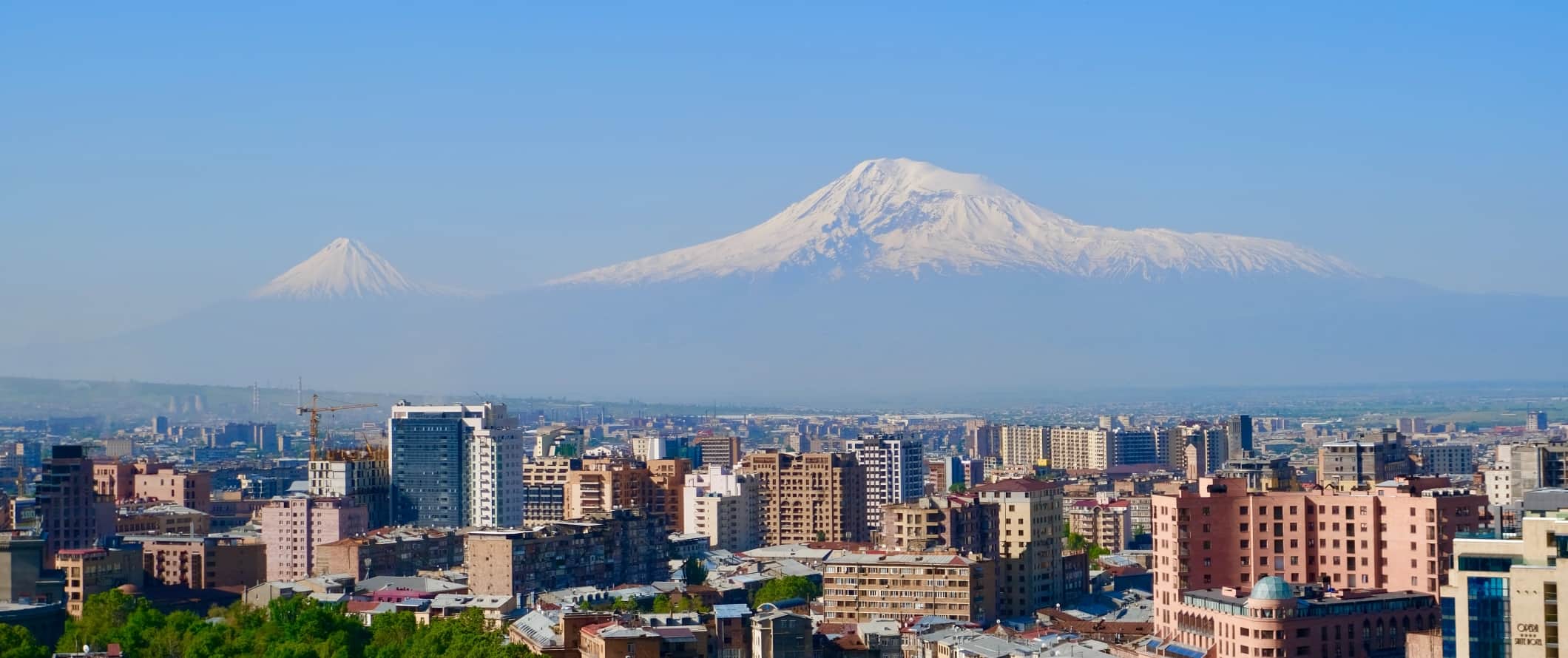
Straddling the divide between Asia and Europe , Armenia might be one of the final travel frontiers left on the planet for adventurous backpackers. Visiting Armenia isn’t often on a traveler’s to-do list, despite its beautiful snowy mountain peaks and many perfectly preserved medieval monasteries.
But their loss is your gain as the country is virtually untouched by mass tourism.
Armenia’s history is complicated and often tragic, marked with countless years of warfare and the infamous Armenian Genocide in which the Ottoman government murdered 1.5 million Armenians in the early 1900s.
Learn more about the country’s past by visiting the many historical monuments and religious structures scattered around the country, including the 4th-century Etchmiadzin Cathedral and the Greco-Roman Temple of Garni.
Armenia’s dramatic landscape of jagged mountains and deep, rugged valleys — especially in the Geghama mountain range — is perfect for trekking, biking, and off-roading.
Moreover, Armenians love chatting with visitors. You don’t have to try hard to meet the locals here as they’re going to want to know why you are visiting since so few people do!
This travel guide to Armenia will help you plan your trip, save money, and make the most of your time in this underrated gem!
Table of Contents
- Things to See and Do
- Typical Costs
- Suggested Budget
- Money-Saving Tips
- Where to Stay
- How to Get Around
- How to Stay Safe
- Best Places to Book Your Trip
- Related Blogs on Armenia
Top 5 Things to See and Do in Armenia
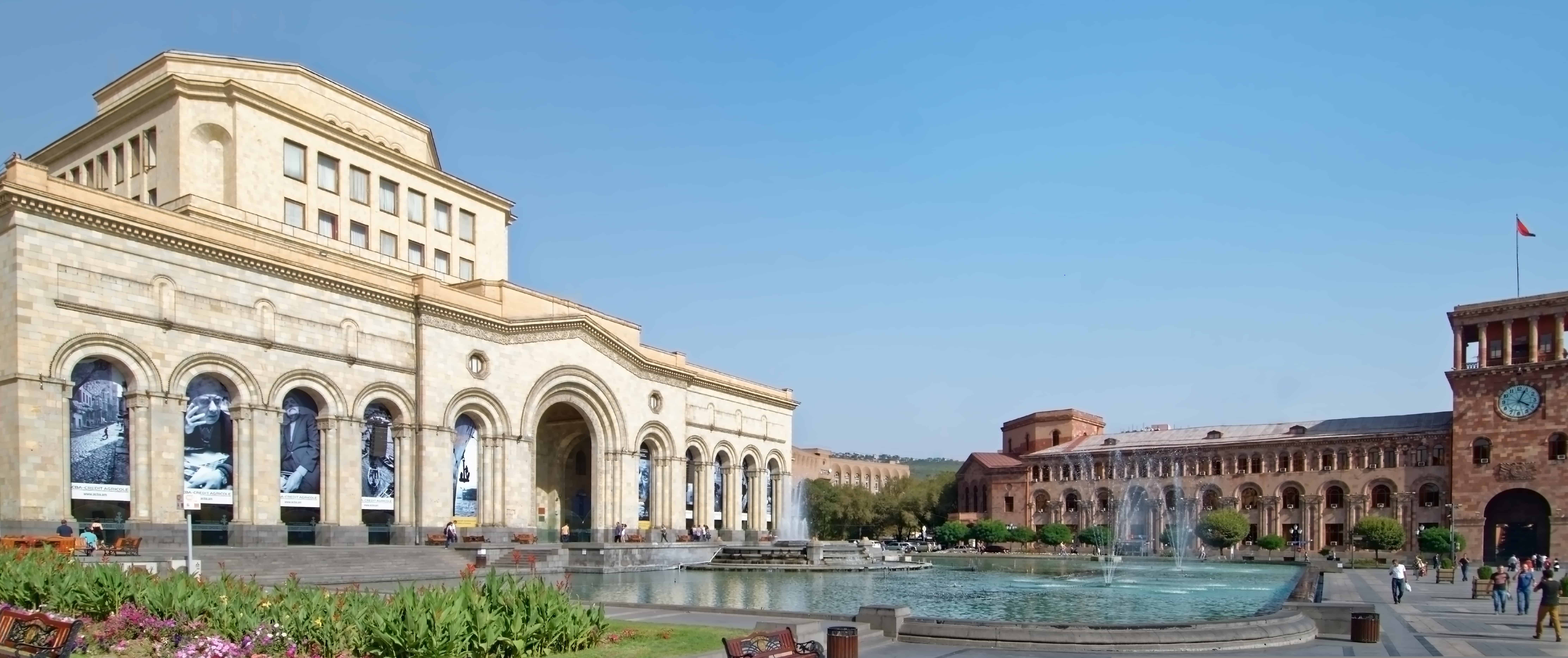
1. See Mount Ararat
This dormant volcano is technically a part of Turkish territory and is believed to be the final resting spot of Noah’s Ark. While you can’t hike the mountain from Armenia, you can certainly admire it up close from the Khor Virap monastery, located just 50 kilometers (31 miles) from Yerevan!
2. Visit Yerevan
Known as Armenia’s “Pink City” for the rose-colored volcanic material used for much of the city’s buildings, Yerevan is home to wide tree-lined boulevards, busy town squares, and a thriving cafe culture. Try the city’s famous dark coffee; it’s rich, sweet, and packed with caffeine.
3. Go Skiing in Tsaghkadzor
Thanks to its mountainous terrain, Armenia has become a hit with extreme sports lovers. During the winter, Armenia is transformed into a ski and snowboarding haven. Tsaghkadzor ski resort in the Marmarik river valley is the most popular place to go. A day ticket costs 12,000 AMD.
4. Visit Dilijan National Park
Dilijan National Park is easily one of the most scenic destinations to visit in Armenia, boasting wide swatches of forested hills and green meadows home to thousands of plant species. Hike the well-marked trails to springs and monasteries or spend some time at scenic Parz Lake.
5. Visit the Genocide Museum
The Armenian Genocide Memorial & Museum stands as a powerful reminder of the genocide that took place in Armenia between 1915-1922 at the hands of the Ottoman Empire. Inside is a collection of photographs, documents, newspaper reports, and films curated to tell the story of this tragic event in Armenian history. Admission is free but donations are welcomed.
Other Things to See and Do in Armenia
1. take the cable car to tatev monastery.
This medieval monastery was built between the 9th-13th centuries and is unique thanks to its position on the edge of a deep gorge. The inside is covered in 10th-century frescoes and vaulted stone ceilings, while the exterior has many pointed domes and is surrounded by tall stone fortress walls that drop off immediately into the gorge below. There are stunning views and photography spots all around the complex as well. The only way to visit the monastery is by taking the cable car across a 5,752-meter cableway (the longest in the world) suspended 320 meters (1,049 feet) above the River Vorotan. The cable car ride takes around 15 minutes, and a round-trip ticket is 5,000 AMD. Tatev is about 3.5 hours from Yerevan.
2. Visit Shikahogh State Reserve
Shikahogh State Reserve is the second largest forest in Armenia and is home to some diverse wildlife including leopards, bears, wild goats, and vipers. There are lush mountain hiking trails (although they are not always well maintained) that lead you to Iron Age tombs, medieval churches and monasteries, waterfalls, crystal-clear springs, and even abandoned towns. The 11-kilometer (7-mile) route from Mount Khustup to Shishkert village is tough but incredibly scenic.
3. Swim in Lake Sevan
Also known as the “Armenian Sea,” Lake Sevan is a massive lake (it covers 5% of the country) located high in the Caucasus mountains. Known for its incredible biodiversity and stunningly stark landscapes, Lake Sevan is a popular destination for domestic and foreign travelers alike. Come here to relax in one of the lakeside villages, visit medieval monasteries, and swim in the lake (if it’s warm enough or you’re brave enough!). The lake is so high in altitude (1,900 meters above sea level) that if you sit on the riverbank, it almost looks like the river is running into the sky. You can wild camp here for free as well. Lake Sevan is around 65 kilometers (40 miles) from Yerevan. The most common way to get here is by marshrutka (minibus), which takes around an hour.
4. See Geghard Monastery
Geghard Monastery is a World Heritage-listed complex named from the lance that pierced Christ’s side at the crucifixion. The buildings are partially carved out of the mountains and surrounded by cliffs along the Azat River Gorge. Inside the 13th-century Avazan Chapel is a sacred spring that runs through the monastery, and the original reason for the founding of the area as a religious site back in the 4th century. Today, visitors fill up bottles to take the holy water home. Admission is free.
5. Visit the Echmiadzin Cathedral
Located only 20 kilometers (12 miles) from Yerevan, no visit to Armenia would be complete without seeing the Echmiadzin Cathedral. The cathedral was built following the country’s adoption of Christianity in 301 CE, making it the first country in the world to do so. The cathedral is the oldest in Armenia and is often cited as the oldest cathedral in the world. The cathedral’s museum has some fascinating artifacts, including a supposed piece of the cross on which Jesus was crucified, the spear that pierced Jesus’ side, and a piece of Noah’s Ark. Admission to the museum is 1,500 AMD.
6. Explore Gyumri
The city of Gyumri is one of Armenia’s most ancient settlements, dating back nearly 3,000 years. Starting from the busy Vardanants Square at the center of town, walk to the Kumayri Historic District, a sort of open-air museum filled with historic buildings like the Sev Ghul fortress and the Paris Hotel (used as a maternity hospital during Soviet times). Be sure to visit the Dzitoghtsyan Museum of Social Life (1,000 AMD entry), which showcases life in the area from the 19th century to the 1920s, or the Aslamazyan Sisters House-Museum (300 AMD entry), with works from two sisters who helped bring equality to Armenian women through their art.
7. Experience the healing waters of Jermuk
With over 40 natural thermal springs, Jermuk is the most popular spa town in Armenia, with a variety of resort hotels and spas (rooms start at 15,000 AMD). Get a free sample of healing mineral water from the Gallery of Water, where natural mineral water flows into 5 different stone urns, each with different healing properties and temperatures (be careful as some are very hot). While you’re there, make sure you venture to the Jermuk waterfall, which, at 70 meters tall (230 feet), is Armenia’s second-largest waterfall. Jermuk is about 3 hours from Yerevan.
8. Visit the Army of Stones
Karahunj, otherwise known as Zorats Karer (or Army of Stones in English), is Armenia’s oldest and most popular megalithic site. Located at an altitude of 1,770 meters (5,800 feet) on a rocky plateau, no one knows how these 200 stones got here. Even stranger is the fact that each stone has 5-centimeter holes in it. There are many different theories on how and why the stones are here, but the most popular theory is that the site was constructed in the 6th century BCE for stargazing.
9. Take a wine tasting tour
With over 500 unique and native varieties almost unknown to the world outside Armenia, taking a wine tour is a must for any wine lover. In fact, the oldest wine cave in the world (it’s 6,000 years old!) is near Areni. Sadly, during Soviet rule, many of the wineries were shut down. It is only in the last decade that Armenia has begun to reconnect with its winemaking roots. Wine tours from Yerevan start from 37,000 AMD for a tour of one winery and go up to around 75,000 AMD for a full-day tour.
10. Go to the Erebuni Historical & Archaeological Museum-Reserve
This archaeological site encapsulates the ancient Erebuni Fortress, which dates to 782 BCE, a whole three decades before Rome was even established, and after which the city of Yerevan was named. The entire complex is now an outdoor museum, with an indoor component as well. The museum contains more than 12,000 artifacts offering insights into Armenia’s ancient history and the establishment of the city of Yerevan. You’ll also learn about what daily life was like in the palace of Argishti I, one of the greatest kings of ancient Urartu. Admission is 1,000 AMD or 2,500 AMD with a guide.
11. See Noravank
Built in the 13th century, legend has it that when the Mongols conquered Armenia hundreds of years ago, it was God himself that saved the Noravank monastery. Delicately carved stonework and religious reliefs (including depictions of God) decorate the three churches here. Unlike the many other Armenian monasteries that are located on top of mountains and gorges, Noravank is set on the floor of a deep valley, with towering red cliffs rising up on either side of the complex. Visiting the site is free, though the museum is 500 AMD. The monastery is around 122 kilometers (76 miles) from Yerevan.
Armenia Travel Costs
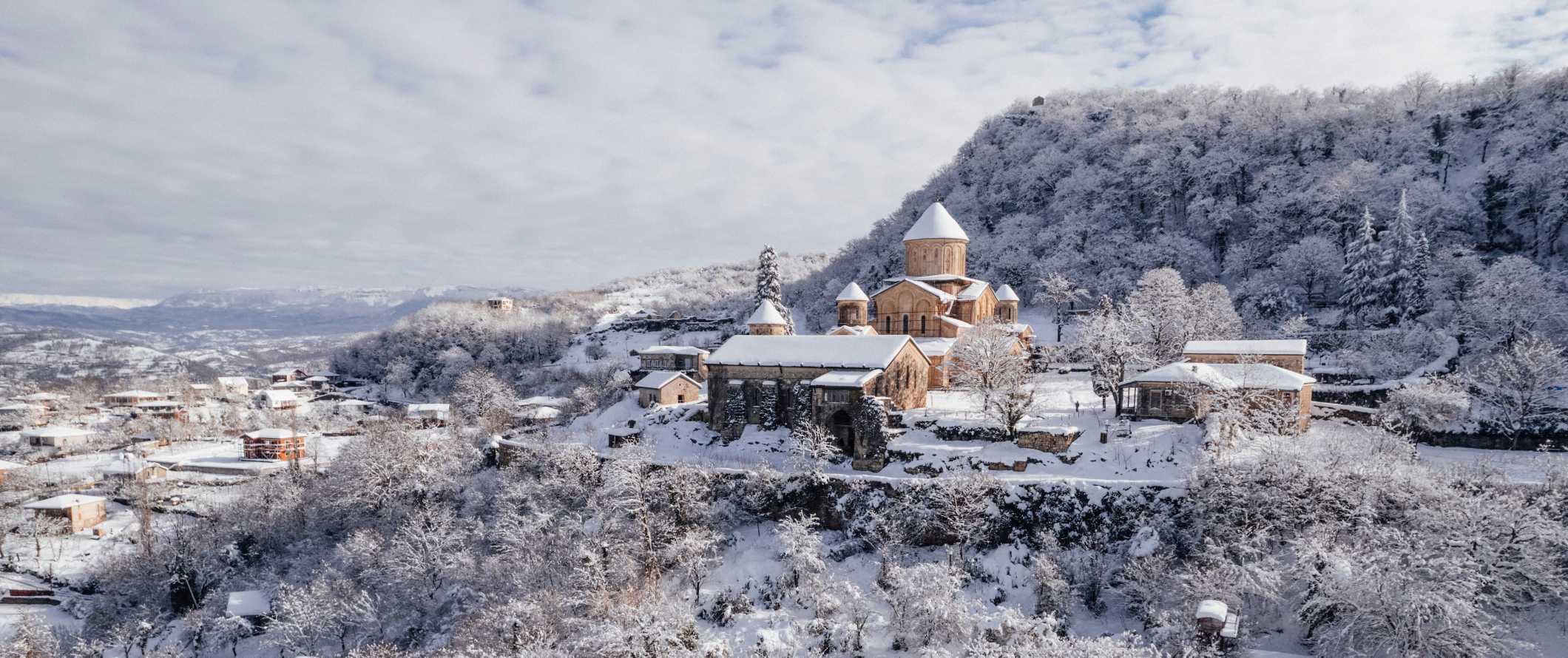
Accommodation – There are a limited number of hostels in Armenia and most of them are in the capital, Yerevan. A bed in a 4-6-bed dorm costs 5,000-7,500 AMD, while a bed in an 8-bed-dorm costs 3,000-4,000 AMD. A private double room in a hostel is around 10,000-15,000 AMD with a shared bathroom. Standard amenities include Wi-Fi and bedding. Free breakfast and shared kitchens are common as well (though not all hostels have them).
Camping is available around the country. For those not traveling with a tent, you can often rent them at the Tourist Information Centers. Wild camping is free, but if you prefer camping on a campsite, prices start at around 4,000 AMD per night for two people and a tent.
Budget hotels average around 8,000-9,850 AMD per night. Free Wi-Fi is standard and free breakfast is usually included.
Airbnb is available though the options are limited. Private rooms start around 10,000 AMD per night while entire homes/apartments average closer to 25,000 AMD.
Food – Armenia is a landlocked country with a long history of trade, meaning that Mediterranean, Middle Eastern, and Eastern European countries have all left their mark on the country’s cuisine.
Fresh and dried herbs create flavorful dishes, and common spices include black pepper, sumac, cumin, mint, and cinnamon. Staple vegetables include eggplant, cucumber, bell pepper, tomato, and onion. Legumes, especially chickpeas and lentils, are also used as central ingredients in many dishes. Pork, lamb, and beef are the most common meats. Though meat is predominant in the cuisine, because of the fasting periods in the Armenian Apostolic religion, there are many traditional dishes that are entirely plant-based as well.
Common dishes include a variety of cold salads, yogurt soups, boereg (filled pastry pies), bozbash (lamb stew), khorovats (grilled meat skewers), tolma (stuffed grape leaves), kyufta (a type of meatball), and harissa (a porridge that’s considered Armenia’s national dish). Traditional lavash bread, a flatbread made from wheat and baked in a clay oven, is integral to Armenian cuisine and is served with most meals.
Street food like shawarma or lahmajun (Armenian pizza) costs less than 1,000 AMD, and a glass of tan (a salty yogurt drink) shouldn’t be more than 300 AMD.
For an inexpensive meal at an Armenian restaurant, expect to pay around 1,250-2,750 AMD for traditional food like spa (an extra creamy soup), kyufta (meatballs), or Armenian cheese with basturma (dried meat with spices) wrapped in a piece of Armenian pita bread.
Higher-end or Western restaurants cost about 6,000-8,500 AMD per meal. Even Chinese takeout restaurants, normally a mainstay of the budget traveler, are more expensive than Armenian meals, costing at least 3,800 AMD for a dish.
In terms of drinks, expect to pay 600 AMD for a beer, 700 AMD for a glass of Armenian wine, 1,000-1,500 AMD for a cocktail, 800 AMD for a cup of Armenian coffee, and 1,200 AMD for a cappuccino.
If you plan on cooking your own meals, a week’s worth of groceries should cost around 12,000-16,000 AMD but, with food prices being so low, it’s better to eat street food and enjoy the food the country has to offer!
Backpacking Armenia Suggested Budgets
On a backpacking budget of about 17,500 AMD per day, you can stay in a hostel dorm (or camp), eat street food or at inexpensive restaurants, cook some of your meals, use local transportation (including some intercity buses), limit your drinking, and stick to mostly free or cheap activities like hiking and museum visits.
On a mid-range budget of about 43,000 AMD, you can stay in a private hostel or Airbnb, eat any budget restaurant meal you want, enjoy a few drinks, take some taxis to get around, take intercity trains, and do more paid activities like ride the cable car to Tatev Monastery and do a winery tour.
On a “luxury” budget of about 77,000 AMD per day, you can stay in a hotel, eat anywhere you want, drink more, rent a car to get around, and do whatever tours and activities you want. This is just the ground floor for luxury though. The sky is the limit!
Use the chart below to get an idea of how much you need to budget daily, depending on your travel style. Keep in mind these are daily averages – some days you’ll spend more, some days you’ll spend less (you might pay less every day). We want to give you a general idea of how to make your budget. Prices are in AMD.
Armenia Travel Guide: Money-Saving Tips
Armenia isn’t going to break your bank. There are so many free activities here, especially if you’re enjoying the outdoors, that it’s hard to spend a lot. Throw in cheap food, beer, and accommodation, and you can really stretch your budget here. However, if you’re looking to lower your expenses even more, here are some ways to save money in Armenia:
- Take a free walking tour – Yerevan Free Walking Tour is a great way to get familiar with the city and the culture. Just be sure to tip your guide at the end!
- Hitchhike and wild camp – If you really want to save money in Armenia, it is one of the easiest countries in the world to hitchhike. You will likely never wait long. Wild camping is also legal, and it is very common for friendly Armenians to invite you to their home for food so bring a tent when you visit.
- Cook your own meals – Some hostels here don’t include kitchen facilities, so if you want to save money, make sure you book accommodation that does so you can buy cheap groceries and cook some meals.
- Stay with a local – If you plan ahead, you can usually find a Couchsurfing host that can provide free accommodation and share their insider tips with you. It’s the best way to save money and meet locals.
- Enjoy the free spaces – There are plenty of free parks as well as many free hiking trails around the country. Save your budget and enjoy the outdoors!
- Pack a water bottle – The tap water here isn’t really safe to drink so bring a reusable water bottle with a filter to save money and reduce your reliance on plastic bottles. My preferred bottle is LifeStraw because it has a built-in filter to ensure your water is always clean and safe.
Where to Stay in Armenia
There are very few hostels in Armenia, and the few they have are in Yerevan and Tsaghkadzor. My suggested places to stay are:
- Envoy Hostel (Yerevan)
- MGA Hostel and Tours (Yerevan)
- Kantar Hostel (Yerevan)
- Hostel Tsaghkadzor (Tsaghkadzor)
How to Get Around Armenia

Public transportation – Public transportation isn’t the best in Armenia. The public transport websites aren’t translated into English, so it is much better to ask at your hostels for guidance to help you use the local and intercity buses. In the cities, it is easy to walk from place to place.
Yerevan has five trolley bus routes with a ride costing around 50 AMD. There’s also a subway with one line and ten stations, and public buses. A one-way fare on the bus and subway is around 100 AMD.
If you’re flying into Zvartnots International Airport, you can reach the center of Yerevan by bus or taxi. Aerotaxi is the official airport taxi but be aware drivers often won’t turn on the meter, so you need to negotiate a price, which should be around 3,000 AMD. A bus is around 300 AMD.
Bus – Intercity transport in Armenia is best done by bus and minibus (marshrutka). Intercity buses are relatively inexpensive but navigating the bus stations can be tricky as English isn’t widely spoken. Ask in your hostel the day before for someone to help you work out which bus you need and then you will just have to look for that bus when you arrive at the station.
Bus fares average about 716 AMD per hour of travel, but even a short route can end up taking quite a while with lots of stops.
Trains – There are daily trains connecting Yerevan to Gyumri (3 hours), Yeraskh (1.5 hours), Araks (1 hour), Ararat (1 hour), and Hrazdan (1.5 hours). In the summer months, the Hrazdan line gets extended to Lake Sevan. One-way tickets cost between 3,500-12,500 AMD.
Train tickets to nearby cities outside of Armenia, such as Tbilisi, cost around 9,800-12,000 AMD for a one-way ticket. You can purchase tickets online at the official railway website, Railway.am .
The trains that run most regularly are slow trains that are Soviet-era relics, meaning they are uncomfortable and lack the usual amenities you might expect from trains. The express trains, however, are modern and air-conditioned. Unfortunately, these cost more and run less frequently.
Flying – There are only two international airports in Armenia so although air travel is possible, it is far from cost-effective. Often you don’t save much time due to layovers. A flight from Gyumri to Yerevan starts at 95,000 AMD. Only fly if you are short on time and flush with cash.
Car Rental – Driving is definitely the most convenient way to get around Armenia. Car rentals can sometimes be as low as 12,000 AMD per day, and the more days you book, the better the price. If you’re driving, make sure to get an International Driving Permit (IDP) in advance as you’ll need one for any vehicle rental.
When to Go to Armenia
The best time to visit Armenia is at the beginning or end of summer (May-June or September-October). During these months, the weather is mild, making it perfect for outdoor explorations. The temperature hovers around 20°C (68°F) but be aware that it can be very rainy throughout May and thunderstorms are common.
Summers are hot, with temperatures soaring as high as 35°C (95°F). Things tend to cool down in the evenings, however, with a gentle mountain breeze providing some welcomed relief after a long, hot day.
If you are visiting for skiing, December is the best winter month for hitting the slopes. Temperatures drop below freezing, and the northern regions receive a lot of snowfall. Cities like Yerevan get a lot quieter during these months as everyone hides from the cold.
You don’t have to worry about inflated prices or crowds even during the summer peak season. Armenia isn’t a very touristy destination, and you often have whole sites all to yourself.
How to Stay Safe in Armenia
Armenia is a very safe country to travel around — even if you’re traveling solo, and even as a solo female traveler. Violent crime here is rare.
There aren’t any specific scams to look out for either, though sometimes taxi drivers will try to overcharge you. You can avoid this by agreeing on a price before entering the taxi (ask your hotel/hostel staff for a price estimate if you’re not sure what to pay).
If you’re worried about getting ripped off you can read about common travel scams to avoid here .
Petty theft and pickpocketing are rare but can occur so always keep your valuables (specifically your wallet and phone) secure and out of reach. This is especially important in crowds or on busy public transportation.
Solo female travelers should feel safe here, though the standard precautions apply (never accept drinks from strangers, don’t leave your drink unattended at the bar, don’t walk around intoxicated at night, etc.).
If you rent a vehicle, don’t leave any valuables in it overnight. Break-ins are rare, but it’s always better to be safe than sorry.
There’s often political turmoil with neighbors so keep an eye out on that and avoid protests or demonstrations while in Armenia. Avoid the Nagorno-Karabakh region on the border with Azerbaijan due to armed conflict.
If you do experience an emergency, dial 112 for assistance.
Always trust your gut instinct. Make copies of your personal documents, including your passport and ID. Forward your itinerary along to loved ones so they’ll know where you are.
The most important piece of advice I can offer is to purchase good travel insurance. Travel insurance will protect you against illness, injury, theft, and cancellations. It’s comprehensive protection in case anything goes wrong. I never go on a trip without it as I’ve had to use it many times in the past. You can use the widget below to find the policy right for you:
Armenia Travel Guide: The Best Booking Resources
These are my favorite companies to use when I travel. They consistently have the best deals, offer world-class customer service and great value, and overall, are better than their competitors. They are the companies I use the most and are always the starting point in my search for travel deals.
- Skyscanner – Skyscanner is my favorite flight search engine. They search small websites and budget airlines that larger search sites tend to miss. They are hands down the number one place to start.
- Hostelworld – This is the best hostel accommodation site out there with the largest inventory, best search interface, and widest availability.
- Booking.com – The best all around booking site that constantly provides the cheapest and lowest rates. They have the widest selection of budget accommodation. In all my tests, they’ve always had the cheapest rates out of all the booking websites.
- HostelPass – This new card gives you up to 20% off hostels throughout Europe. It’s a great way to save money. They’re constantly adding new hostels too. I’ve always wanted something like this and glad it finallt exists.
- Get Your Guide – Get Your Guide is a huge online marketplace for tours and excursions. They have tons of tour options available in cities all around the world, including everything from cooking classes, walking tours, street art lessons, and more!
- The Man in Seat 61 – This website is the ultimate guide to train travel anywhere in the world. They have the most comprehensive information on routes, times, prices, and train conditions. If you are planning a long train journey or some epic train trip, consult this site.
- Rome2Rio – This website allows you to see how to get from point A to point B the best and cheapest way possible. It will give you all the bus, train, plane, or boat routes that can get you there as well as how much they cost.
- FlixBus – Flixbus has routes between 20 European countries with prices starting as low 5 EUR! Their buses include WiFi, electrical outlets, a free checked bag.
- SafetyWing – Safety Wing offers convenient and affordable plans tailored to digital nomads and long-term travelers. They have cheap monthly plans, great customer service, and an easy-to-use claims process that makes it perfect for those on the road.
- LifeStraw – My go-to company for reusable water bottles with built-in filters so you can ensure your drinking water is always clean and safe.
- Unbound Merino – They make lightweight, durable, easy-to-clean travel clothing.
- Top Travel Credit Cards – Points are the best way to cut down travel expenses. Here’s my favorite point earning credit cards so you can get free travel!
Armenia Travel Guide: Related Articles
Want more info? Check out all the articles I’ve written on backpacking/traveling Armenia and continue planning your trip:
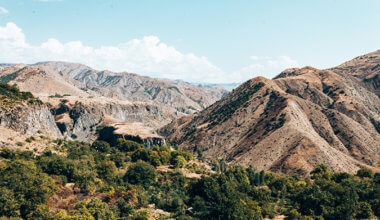
19 Easy Ways to Save Money in Armenia
Get my best stuff sent straight to you, pin it on pinterest.
- Where To Stay
- Transportation
- Booking Resources
- Related Blogs

- Partner with Us
- Made in Armenia
- Gegharkunik
- Vayots Dzor
- Cultural Heritage
- Food & Drink
- Itineraries & Road Trips
- Nature Activities
- Practical Information
- Soviet Armenia
- Things To Do
- What to Pack
- Where to Stay
Best of Armenia , Itineraries & Road Trips
2 incredible armenia itinerary options for first-time visitors.
This guide is all about planning the perfect Armenia itinerary for your trip! We offer two options for how to best spend 3, 6, or 7 days in Armenia regardless of what your travel style is!
Below are some of the top tours, hotels, and more!
Top Experiences and Tours In Armenia:
- Day trip to Khor Virap, Areni Winery and Noravank Monastery (from $34)
- Armenia: Private Tour to Khor Virap Monastery (from $37)
- Private Tour: Lake Sevan, Dilijan, Goshavank and Haghartsin (from $90)
- From Yerevan: 4.5-Hour Garni-Geghard Tour (from $39)
Top Hotels in Yerevan:
- The Alexander (a luxury in Yerevan)
- Daniel’s Boutique Hotel (mid-range in Yerevan)
- 14th Floor (mid-range in Yerevan)
- Grand Hostel (budget in Yerevan)
Looking for the best way to get around Armenia? Click here to check rental car rates for Armenia!
Let us know if you have any questions at the end or have any tips for how to create an optimal itinerary for Armenia!
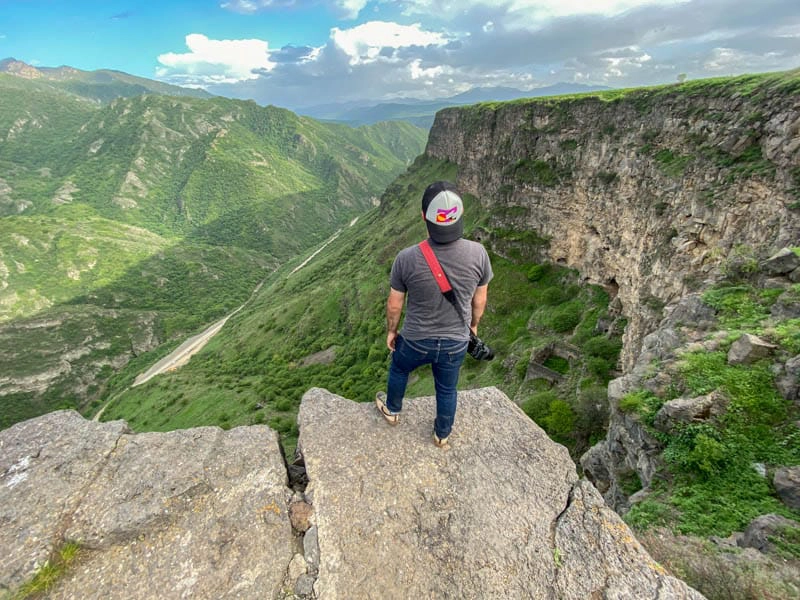
Armenia is a small, beautiful country, but it’s not necessarily easy to navigate because of its mountainous landscape and poorly developed infrastructure.
Though it’s getting better each year, it’s still not quite perfect.
We have traveled the country extensively and on every trip, we discover new and amazing places to visit in Armenia , but we also understand that for first-time visitors it can be quite difficult to figure out where to go and what to see in Armenia.
For now, we have created two types of itineraries, where we have tried to include sights for history and culture lovers as well as nature lovers as there is so much to see in Armenia.
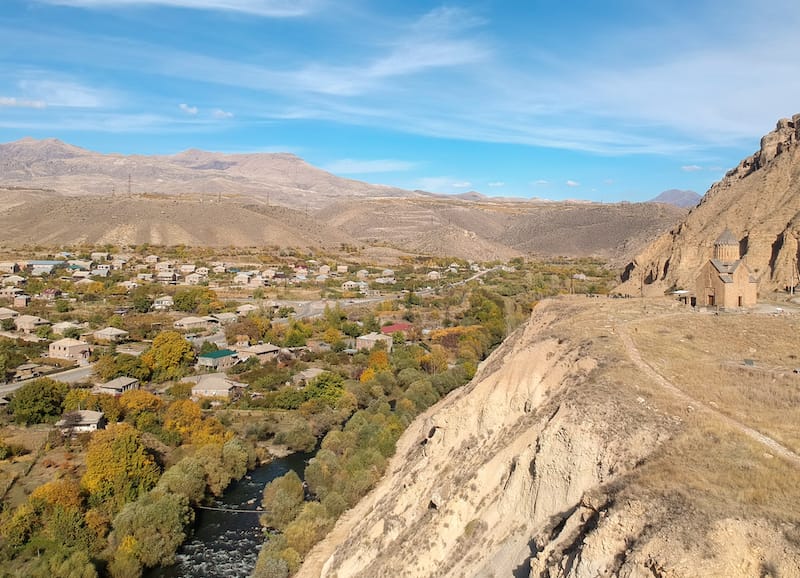
The best thing about these itineraries is that you can easily change sights, dates, and locations to make them suitable to your needs and interests, especially if you have a rental car or are booking a tour.
Each version of the itinerary will have accommodation options in the particular region where you can stay as well as tours that you can take to see multiple sights in a short period of time.
Armenia Itinerary Suggestions Overview
Here is a quick glimpse at our two itinerary suggestions for Armenia:
Cultural Heritage Itinerary
- Day 1: Khor Virap, Areni-1 Cave, Noravank Monastery, Tatev Monastery
- Day 2: Temple of Garni, Geghard Monastery
- Day 3: Yerevan
Day 4: Etchmiadzin, Zvartnots Cathedral, Voskevaz Winery
- Day 5: Lake Sevan, Dilijan National Park, Haghartsin Monastery
Day 6: Odzun, Horomayri Monastery, Ardvi, Lori Berd
- Day 7: Sanahin Monastery, Haghpat Monastery
Nature and Adventure Itinerary
- Day 1: Dilijan National Park, Parz Lake, Gosh Lake
- Day 2: Rafting in Armenia, Lori Berd, Stepanavan Dendropark
- Day 3: Yerevan, Hrazdan Gorge, Yerevan Zipline
Day 4: Temple of Garni, Azat Gorge, Symphony of Stones
- Day 5: Areni-1 Cave, Noravank Monastery, Tatev Monastery
Day 6: Hell’s Canyon
- Day 7: Yerevan
Armenia Itinerary #1: Cultural Heritage
To add this map to your Google Maps account, click the ‘Star’ icon next to the map name. You can then view it on your cell phone or computer by heading to your Google Maps account, click the menu and add it to ‘Your Places’.
Day 1: Khor Virap, Areni-1 Cave, Noravank, Tatev
Four amazing and must-visit places in Armenia are Khor Virap Monastery , Noravank Monastery, Tatev Monastery, and Areni-1 cave.
They are all relatively close together, so it’s a great opportunity to see all four of them in one day.
Each of these sites has a unique history and value to the Armenian story and we definitely recommend visiting all of them, as many people have never seen such places in their life.
Approximate driving time: 4-5 hours
Khor Virap Monastery
One of the biggest symbols of Christianity in Armenia is Khor Virap Monastery , but it’s known for more than just being the biggest heritage of the first Christian nation in the world.
Khor Virap is located in a gorgeous location in the Ararat valley with a view of the iconic mountain Ararat. Getting to Khor Virap from Yerevan is quite easy, too.

Though man-made, this facility is in harmony with nature. When the sky is not cloudy, you can see an unbelievably beautiful view of Mt. Ararat and the valley and discover Khor Virap and its history.
Khor Virap means “deep dungeon” because, under the church, there is a hole where Gregory the Illuminator was dropped to die.
He survived and later brought Christianity to Armenia in 301, which made Armenia the first Christian nation.
Khor Virap is located in Ararat province .
Areni-1 Cave Complex
Your next stop will be the wine village of Areni, where the world’s oldest winery in Areni-1 Cave was discovered nearby.
The impressive and ancient winery was discovered in 2008 and is estimated to be 6100 years old, dating to the Early Bronze Age.
You will witness the world’s oldest winery inside of the cave where many clay pots are buried in the soil that still have remains of grapes and wine.
Areni is in general known to be the wine center of Armenia. Each year in Areni village, there is a wine festival where thousands of people taste and enjoy hundreds of wines.
Also in the caves, the world’s oldest leather shoe was discovered, dated to be 5,500 years old. Right now, it is on display at the History Museum of Armenia.
Noravank Monastery
Approximately 20 minutes past Areni village is Noravank Monastery which is situated among the red-colored mountains.
Noravank Monastery is the perfect combination for travelers who want to see stunning nature and historical sites.
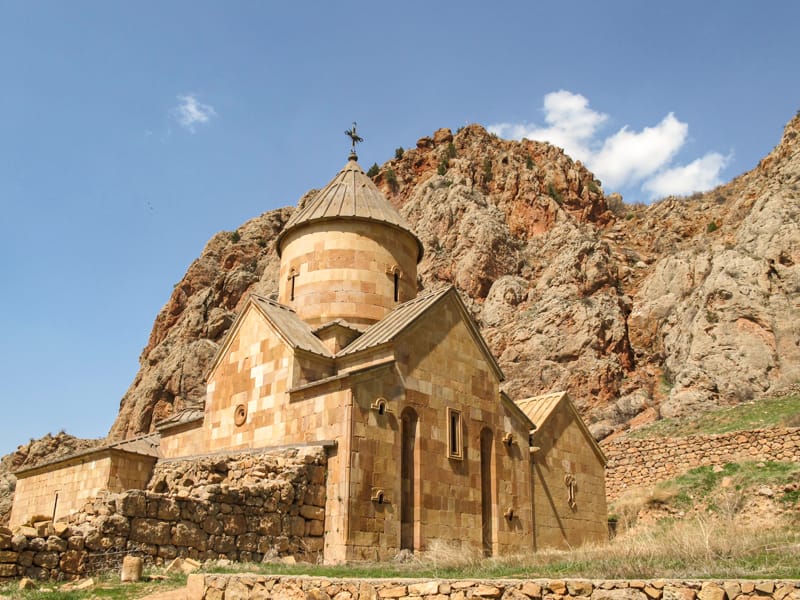
The monastery was founded in the 12th-century in a very significant location because to reach the monastery, you need to drive through a narrow canyon surrounded by high rocks.
Tatev Monastery
If you head even further south down into Syunik, you will end up at Tatev Monastery , another significant sight in Armenia.
Tatev Monastery is not far from the town of Goris (we give accommodation options for there below) and is renowned for its remote location that is best reached by taking the Wings of Tatev cable car.
Day 1 Tour Option
- Khor Virap, Noravank, & Areni Winery Day Trip
Day 1 Hotel Options
- Budget: Tatev Traditional Guesthouse
- Mid-range: Hotel Mira
- Luxury: Hotel Mirhav
Day 2: Temple of Garni and Geghard Monastery
Temple of garni.
The Temple of Garni and Geghard Monastery are very close to Yerevan, making it a very popular day trip for travelers. Both sites are stunning and have centuries of history from Pagan Armenia to Christian Armenia.
Garni Temple is a rare Pagan temple that still exists in the region. It is a must-visit place for ancient history lovers.
Located only 40 minutes away from Yerevan in the Kotayk region among mountains and gorges, Garni village has a rich history with many things to do and to see.

Garni Hellenistic Temple was built in the 1st century AD. It used to be a kind summer residence dedicated to Mihr, the Armenian Pagan God of light and sun.
The temple facility has other historical artifacts to explore, like antique baths and stone arts. The view of the gorge is also something that no one should miss out on seeing.
Geghard Monastery
Geghard Monastery is another must-see important historical and religious monument located deep in the mountains.
On the UNESCO World Heritage Sites list, this monastery has a very unique architecture and location because a large part of the monastery is actually built into the huge rock face. The monastery was founded in the 4th-century.
This is a place where the human minds and creativity meet nature, as you can see from the harmonious collaboration between nature and architecture.
Geghard in Armenian means “spear” because for centuries the spear that Jesus Christ was wounded with was brought to Armenia and kept at Geghard Monastery until it was later moved to the Holy Etchmiadzin.
Day 2 Tour Option
- Half-day tour to Garni and Geghard from Yerevan
Day 2 Hotel Options
- Budget: Guest House Garni Resthouse
- Mid-range: Chez Yvette
- Luxury: Hotel Garni 7 Qar
Day 3: Discover Yerevan
Take a day and explore Yerevan – the beautiful and charming capital built from pink volcanic tuff, which gives the city a unique and beautiful look.
Yerevan is more than 2,800 years old and considered one of the oldest capitals in the world, being even 29 years older than Rome!
There are many sites in the city to see like the Cascades Complex, the Opera House, Republic Square, and many others.

Yerevan has a great cafe culture throughout the city, but especially around the Cascades and Saryan wine street .
You can discover small charming vineyards and cafes where you can enjoy fantastic local wine and food.
Day 3 Tour Option
- Yerevan: City Tour with Brandy Tasting and Carpet Weaving
Day 3 Hotel Options
- Budget: Grand Hostel
- Mid-Range: Daniel Boutique Hotel
- Luxury: The Alexander
Other very close day trip locations from Yerevan are the Holy City of Etchmiadzin, Zvartnots Cathedral ruins, and Voskevaz winery.
All of the locations are close to each other and located in one region, Armavir. Armavir is known for its green valleys and being home to some of the oldest churches in the world.
Etchmiadzin
Known also as the Holy City of Etchmiadzin , it is the center of Christianity of Armenia because it has one of the oldest churches in both Armenia and the world.
The small city of Etchmiadzin is located only 20 km away from Yerevan and has more than 2,000 years of history.
It has more than one UNESCO World Heritage Site, like Etchmiadzin Cathedral, Saint Gayane Church, and Zvartnots Cathedral ruins.
Etchmiadzin is a charming city where you can visit nice museums and enjoy food in local restaurants .
Zvartnots Cathedral
Right before entering Etchmiadzin city, on the right side of the highway, you will find beautiful gates decorated with stone statues and ornaments.
This is the main entrance to the ancient Zvartnots Cathedral ruins.
You can take a walk down a long path lined with apricot and cherry trees, or enter the parking lot by car.
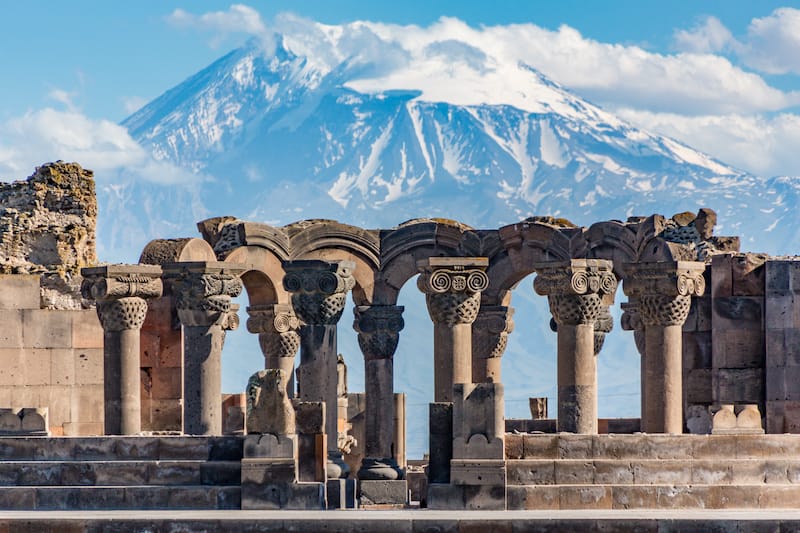
This UNESCO World Heritage Site was erected in the 7th-century AD, a rare architectural style for that time.
It was destroyed by a strong earthquake in the 10th-century AD. There are still some preserved ruins showcasing the beauty and complicated architecture of the facility.
The backdrop of Zvartnots Cathedral is the beautiful Ararat mountain. Close to the ruins, there is a museum where you can learn more about the construction and the sight’s history.
- Working hours: 10:00-17:00 Monday closed
- Fee: 700 AMD + 100 AMD for parking
Etchmiadzin Cathedral
One of the oldest Christian churches in the world, the Etchmiadzin Cathedral complex is located in the center of the city. It is also known as the Armenian Vatican.
As the first Christian nation, Armenia has many old churches, but Etchmiadzin Cathedral is the oldest. It was built in 301 AD, the year Armenia adopted Christianity as its state religion.
The area around the Cathedral has a beautiful garden with flowers and trees, an ancient graveyard, and one of the oldest restaurants in the Caucasus.
Voskevaz Winery
Take your time and drive to Voskevaz Winery , which resembles a fairytale castle and is located only 30 minutes away from Echmiadzin in the Aragatsotn region .
It is a great place to finish up a day of exploration with a glass of wine and a tour to see where and how it is made.
The factory was founded in 1932 and located a couple of kilometers from Kasakh Gorge.
It is near where the ruins of Badals Church are and where clay amphoras for winemaking were discovered buried in the soil. Click here for more.
Day 4 Tour Option
- Khor Virap, Etchmiadzin, and Zvartnots tour from Yerevan
Day 5: Lake Sevan, Dilijan, Haghartsin Monastery
After returning to Yerevan on the 5th day, you should head to the Blue Pearl of Armenia- Lake Sevan .
It is known for its island monastery, beaches, and lakeside restaurant, as well as the green heart of Armenia- Dilijan and Haghartsin Monastery , located nearby.
All these locations are located approximately 1-2 hours away from Yerevan and are easily accessible and the perfect day trips from Yerevan .
One of the most beautiful places in Armenia is definitely Lake Sevan , known as the Blue Pearl of Armenia. Sevan is the biggest lake in the Caucasus. Located in the Gegharkunik region, it is only an hour away from Yerevan.
From the highway, you can turn right and drive to Sevan Island, which is now a peninsula after the water level went down over the last 100 years.
There are two beautiful churches on the peninsula, located at the top of the island and accessible by a staircase
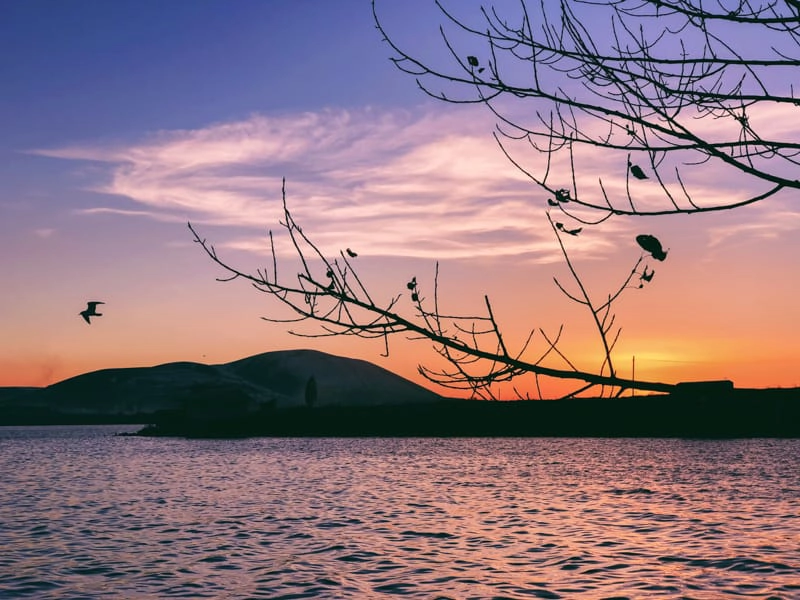
At the top, you will get a mesmerizing view of the lake and mountains. You can also visit the Sevanavank Monastery complex, founded in 874 AD.
Click here to read more about getting to Lake Sevan from Yerevan .
Day 5 Tour Option
- Private Tour: Lake Sevan, Dilijan, Goshavank and Haghartsin
Day 5 Hotel Options
- Budget: Kavkazski Dvor
- Mid-Range: Hover Boutique
- Luxury: Four Seasons Guest House Dilijan
Lori region is rich with history and heritage and many sights are located in the most obscure and mind-blowing locations.
We recommend you visit one of the country’s northernmost regions, Lori, and discover Odzun village surrounded by mountains.
You will also have a chance to see the mysterious Horomayri Monastery located in the dramatic Debed Gorge, Ardvi village, and the ancient Lori Fortress (Lori Berd).
Odzun is the largest village in Lori. It has a rich heritage and is located almost on the edge of Debed Gorge.
The jewel of the village is the Odzun Church, one of the earliest Christian churches in Armenia after Etchmiadzin Cathedral.
Horomayri Church
The fascinating 12th-century Horomayri Monastery ruins are located in Debed Gorge.
You will need to hike to visit this spot, but you also can observe it at a distance from the edge of the gorge.

Horomayri Monastery is located approximately 1 km away from Odzun village and the viewpoint of the gorge and the church is located behind the three small churches right on the edge of Debed gorge.
Ardvi , a little village with a charming church and beautiful views, is located 15 minutes away from Odzun village.
Ardvi has a beautiful little church located at the end of the village surrounded by huge rocks, next to an ancient graveyard with khachkars.
The village has a unique legend: a giant snake attacked the village, but later St. Hovhannes Odznetsi turned it into a stone.
From his body, which is visible in the big rock, healing water comes out. It’s called “Odzi port,’’ in reference to the water appearing to come from the snake’s belly button.
Lori Fortress (Lori Berd)
Another must-see of the Lori region is Lori Berd , also known as Lori Fortress .
It is an 11th-century fortress built on the edge of the crossroads of the Urut and Dzoraget Gorges, at an elevation of 1379m. It once was the capital of the Tashir-Dzoraget kingdom.
The ticket price is 1400 AMD.
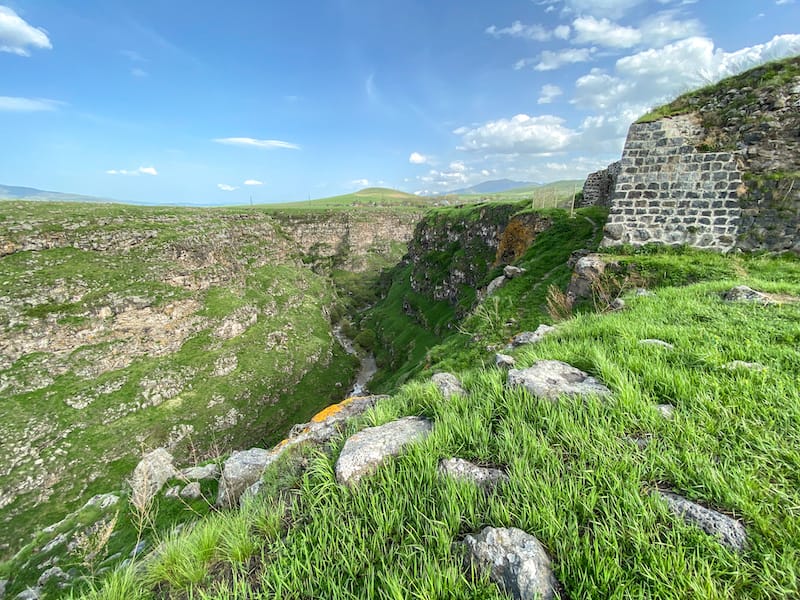
Day 6 Tour Option
- Odzun, Akhtala and UNESCO Heritage Sites Tour
Day 6 Hotel Options
- Budget: Odzun RG
- Mid-range: Olya Guesthouse
Day 7: Sanahin and Haghpat Monasteries
On your final day before returning to Yerevan, we suggest visiting two unbelievably unique monasteries which are both UNESCO World Heritage Sites.
Sanahin Monastery and Haghpat Monastery are not only points of interest in the Lori region but also in all of Armenia because of its architectural and spiritual values and heritage.
Both sites are located on plateaus and are about 15km from each other.
Sanahin and Haghpat Monasteries
Both monasteries are a mix of Byzantine ecclesiastical architecture and Caucasian traditional architecture from around the 10th-13th centuries.
Sanahin means ‘’this one is older than that one’’ because Sanahin Monastery (10th century) is a little bit older than the Haghpat Monastery (also from the 10th century).

Both monasteries are fascinating places that are designated UNESCO World Heritage Sites.
After visiting Sanahin Monastery Complex and Haghpat Monastery you can return to Yerevan as your final day.
If you are planning to spend more days in Armenia, there are many other places you can visit.
Day 7 Tour Option
- Armenia: Private Tour to Haghpat and Sanahin Monasteries
Armenia Itinerary #2: Nature and Activities
To add this map to your Google Maps account, click the ‘Star’ icon next to the map name.
You can then view it on your cell phone or computer by heading to your Google Maps account, click the menu and add it to ‘Your Places’.
Day 1: Dilijan, Parz Lake, Gosh Lake
Your first day can start from Dilijan, located in the Tavush region with lush green forests, mountain lakes, and many hiking trails.
If you have time, Dilijan can definitely occupy you for more than one day. It’s a great location to start discovering Armenia .
You can camp next to Gosh Lake located in the mountains, discover Dilijan with its old districts, and hike in the Dilijan National Park and the surrounding areas.
Dilijan National Park
Dilijan will surprise you with its lush, forested mountains, hiking trails, and delicious local Armenian cuisine .
If you decide to make Dilijan your base in Armenia, you will have easy access to beautiful nature.
You will be able to visit places like Parz and Gosh Lakes, which are located only 15 minutes away from the city center by car.
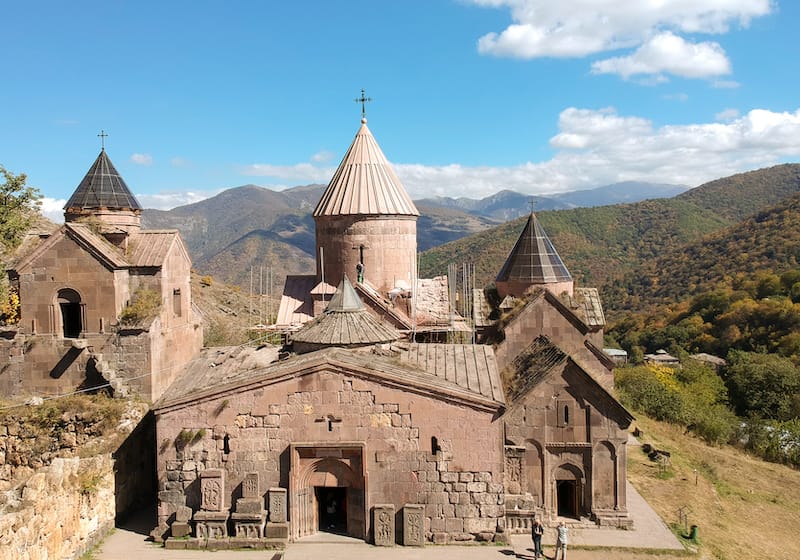
Gosh Lake’s road is more for 4WD/SUVs or hikers, while Parz Lake is much more accessible and can be driven to.
For thrill-seekers, there is an opportunity to participate in adventure activities at VereV Rope Park in Dilijan.
Dilijan National Park is a large forest with many rare trees, plants, and wild animals such as foxes, brown bears, red deer, and more.
There are plenty of things to discover in Dilijan if you wish to stay more than one day.
Day 2: Rafting, Lori Berd, Stepanavan Dendropark
On your second day, you’ll find a mixture of activities, starting with rafting on the powerful Debed River in Lori.
Then visit one of the beautiful fortresses in Lori, located on the edge of the gorge. Next, get lost in the lush green Stepanavan Dendropark, and finally, you will head back to Yerevan to get ready for other upcoming adventures.
Rafting in Armenia
If you love extreme sports and are not afraid to get wet, then rafting in the Debed River is one heck of a fun way to start your day.
The experienced guides will explain how to raft, so this is an activity for all skill levels.
The river goes for many kilometers and is surrounded by mountains and large rocks nestled in dense greenery.
It is a wild time and you’re sure to meet some new people! Click here to learn more!
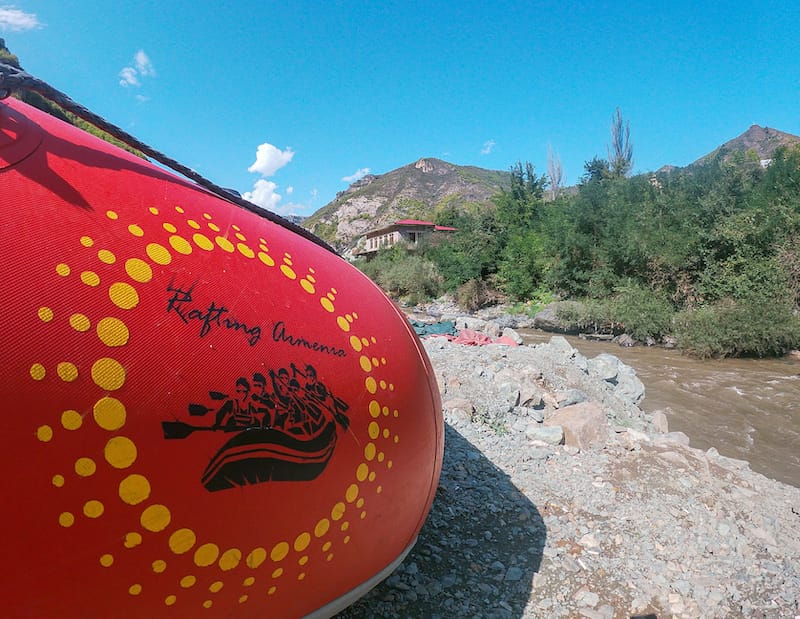
Lori Berd (Lori Fortress)
The road to Lori Fortress is no less impressive; the fortress itself passes through Stepanavan town crossing the impressive huge bridge where the view to the gorge is amazing and the scenery gorgeous.
As you get closer, you will be able to see the ancient fortress on the edge of the massive gorge.
Stepanavan Dendropark
The last place to visit before going back to Yerevan is the large green space that is the Stepanavan Dendropark.
Stepanavan Dendropark was established in 1931 by Edmund Leonowicz who was a Polish engineer.
The space is 35 hectares with 500 species of plants and trees from all around the world.
Stroll up and down the forested paths to the flower gardens, greenhouses, and river. Relax and feel the atmosphere of nature preserved for almost a hundred years.
Don’t forget to say hi to and pet the adorable blind guide dog, Mike!
- 1-day Horseback Riding in the Lush Region of Lori
Day 3: Yerevan, Hrazdan Gorge, Zipline
On the third day, you can fully enjoy Yerevan.
Walk around and discover both its hidden and famous sights, learn the history of the ancient city, and of course, enjoy the Yerevan evening in hip cafes and bars.

Also, during the day, don’t miss out on the opportunity to fly over the Hrazdan Gorge with Yerevan Zipline, the longest zipline in Armenia that goes under a massive bridge.
Yerevan Cafes and Bars
Yerevan has a burgeoning scene of new, hip cafes and bars, which mixes well with the existing sidewalk cafe lifestyle.
You can also find some amazing coffee in Yerevan these days.
Visit places like Kong, Epicure, Mamba, In Vino, and Mirzoyan Library and enjoy Yerevan’s colorful cafes and bar life where you can meet new and interesting people.
Yerevan Zipline
The Yerevan Zipline is fun and full of adrenaline all in one place that will allow you to fly over the beautiful Hrazdan Gorge and cross under the Davtashen bridge.
The zipline has two lines, which means you will be able to fly twice. The longest line is 870 meters long.
The professional staff will guide you until the end of your flight and will teach you the basic knowledge of how to zip 150km/h down to the gorge.
- Working hours: All week 10:30 – 19:30
- Ticket fee: 14,000 AMD

- The Magic and Secrets of Yerevan Walking Tour
On day four, you will go to the Kotayk region, which is next to Yerevan, and visit Garni village, the Azat Gorge, and the Symphony of Stones, all amazing natural wonders.
Symphony of Stones
The Symphony of Stones is a hexagonal and pentagonal stone column natural monument, which is over 70m tall.
The basalt columns are visible from all parts of the gorge and resemble organ pipes.
After visiting Garni Temple, you can hike down to Azar Gorge directly from the left side of the entrance of the temple and observe the Symphony of Stones yourself.
If you have extra time, check out Azat Reservoir nearby!
- From Yerevan: 2-Day Garni, Geghard & Azhdahak Hiking Tour
Day 4 Hotel Options
- Budget: Guest House Garni
Day 5: Areni-1 Cave, Noravank and Tatev Monasteries
The next day, you will have a bit of a road trip to the southern wonders of Armenia in the Vayots Dzor and Syunik regions.
The first stop is the Areni-1 Cave where, according to archeological discoveries, wine was first made.
After visiting the cave, visit the nearby Noravank Monastery which will occupy you for another couple of hours.
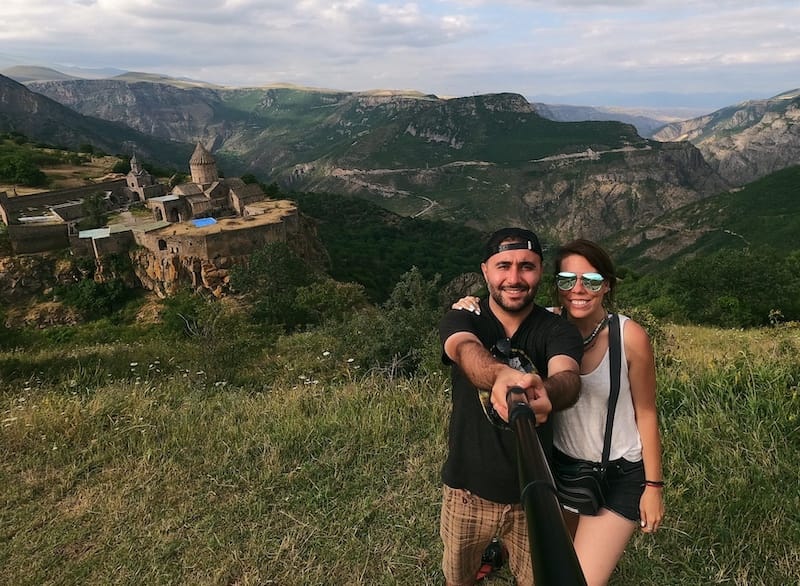
Your final adventure for Day 5 should definitely be the cable tramway called the “Wings of Tatev,” which takes you to the iconic Tatev Monastery.
This is the longest reversible aerial tramway i n the world at almost 6 km in length. Getting to Tatev from Yerevan is easy if you’d like to start that leg first.
- Private Tour: Tatev, Ropeway, Khndzoresk, & Areni Winary
- Budget: Tatev Traditional guesthouse
We recommend that Day 6 be a day where you do something very adventurous, like canyoning in a place called Hell’s Canyon.
It will take all day to do this activity so be ready to give it one full day.
The tour company you can go with will take you to the canyon and then bring you back to Yerevan at the end of the day.
Day 7: Back to Yerevan
On the last day, start making your way back to Yerevan.
You can make some worthwhile stops at places like beautiful Shaki Waterfall , Areni-1 Cave (again), Khor Virap, and Karahunj along the way.
We hope that you enjoyed these Armenia itinerary options and please let us know if you have any questions or additional recommendations! Thanks!
Pin this Itinerary for Armenia
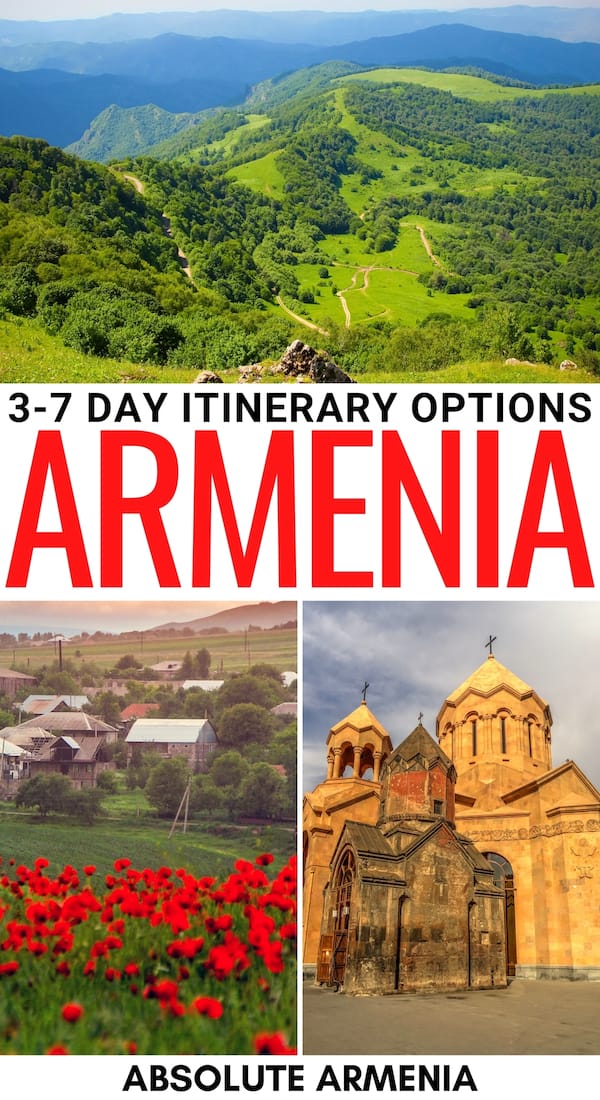
1 thoughts on “ 2 Incredible Armenia Itinerary Options for First-Time Visitors ”
Only in the planning stages of doing a trip though Georgia, Artsakh, Abkhazia, Armenia, Azerbaijan, and Iran. If one was to spend 3 weeks or more in Armenia, what route would you suggest? We would have 4 to 6 months in total. Any suggestions for time frame for the other countries?
Leave a Reply Cancel reply
Your email address will not be published. Required fields are marked *

The Ultimate Armenia Itinerary: 5 to 7 Days (or More!)
Last Updated on February 16, 2024
by Maggie Turansky
Disclaimer: This article contains affiliate links. That means if you click a link and make a purchase, we may make a small commission. As an Amazon Associate we earn from qualifying purchases. For more information, see our privacy policy.
As one of the least-visited countries in Europe, Armenia can be viewed as an exotic destination that only the most intrepid of travellers would choose to visit. Because of this, there isn’t a lot of information about this South Caucasus nation available online and it can make planning the perfect Armenia itinerary a difficult task.
Because so many of those who do visit Armenia do it by organised tour, it can be very tricky to find the right information for those who want to visit this underrated country independently. Planning a trip to Armenia is one of the best decisions you could make, especially if you’re combining it with a trip through the other Caucasus countries of Georgia and Azerbaijan.

Table of Contents
Best Time to Visit Armenia
Despite its relatively southern geographic location, Armenia very much experiences four proper seasons and, therefore, there are some times of year to visit this Caucasian nation that are better than others.
Winters in Armenia can be very cold, with high temperatures between the months of December-February barely clocking in above freezing. Luckily, however, the cold weather doesn’t tend to last too long as it will usually begin to warm up in the month of March and temperatures will fall into the low 20s Celcius (70s Fahrenheit) by April.
Because of this, travelling in the springtime is one of the best times of year to plan a trip to Armenia. Besides the tendency for a bit more rain, the temperatures will be mild and pleasant with it rarely getting too hot or too cold.
The Autumn seasons between September-November also see similar temperatures to Spring albeit with less rain, making that the absolute optimal time to visit Armenia.
Summers in Armenia are sunny and hot, with daily high temperatures often clocking in over 40 degrees Celcius (102 degrees Fahrenheit). Though many hotels, guesthouses, and restaurants will be air-conditioned, this becomes less likely the further from big cities or tourist hotspots you venture.
It is also worth noting that public transport (like buses and marshrutkas) rarely are air-conditioned so it can get unbearably hot to travel from point A to B in the summer.
All in all, the best times to visit Armenia would likely be in the shoulder seasons of March-May and September-November.

How Many Days in Armenia?
If you’re wondering how many days in Armenia is sufficient to get a good feel for the country but you’re strapped for time, we would recommend spending five days in this southern Caucasian nation. This will give you time to explore the lively capital of Yerevan, take a day trip into the surrounding area, and spend a couple of nights in a smaller city as well.
Spending 5 days in Armenia will allow you to get beyond the capital and experience the culture of this underrated travel destination without being too exhausting or taking too much time.
If you have longer, spending one week in Armenia is ideal to get a really good grasp of the country and a more well-rounded view of the culture and history of this beautiful nation.
With 7 days, you have time not only to explore the capital city, but you can head quite off the beaten path and take in the city of Gyumri and enjoy some of the beautiful nature that Armenia has to offer.

Getting Around Armenia
Armenia isn’t that highly-visited of a country and those who do venture to this underappreciated nation tend to do so on an organised tour, which means that figuring out how to get around independently can be a confusing and albeit daunting task for tourists.
Luckily, locals in Armenia tend to be extremely helpful and eager to lend a hand to confused visitors, so it is likely that you wouldn’t be stranded for too long if you couldn’t figure something out.
If you only plan to visit Yerevan while you explore Armenia, getting around the city is incredibly easy and manageable as the majority of the city’s main sites can be reached on foot and the city centre is compact and easy to navigate. Anything else that is not within walking distance is easy to get to with either the metro or an affordable taxi ride.
Taxi rides are accessible for most travellers in Yerevan and it can actually be the easiest way to get to some more out-of-the-way attractions within the city. It is worth knowing, however, that taxis throughout Armenia (and the Caucasus in general) don’t tend to have meters, so it is essential to negotiate a price before you get in.
Finding a cab through the Yandex taxi app or the Bolt app is a great option. This operates much in the same way as Uber and will quote you the exact price of the journey before you get in the cab, leaving out any need for stressful negotiations.
If you’re travelling outside of the capital — for example, from Yerevan to Dilijan , Gyumri, or Goris — there are a few options available for independent travellers. The easiest and most common option for inter-city travel in Armenia is by marshrutka, or minibus.

Depending on the popularity of your destination, marshrutkas have a vague schedule and generally depart when full or mostly full.
The destination of the bus will be posted in the front window and it will generally be in the Latin or Cyrillic alphabet if they are popular routes amongst tourists. If you can’t already, it can be helpful to learn the Cyrillic alphabet or learn what your destinations look like printed both in Cyrillic and in the Armenian alphabet.
You can find the most up-to-date bus timetables from tourist information centres or from your guesthouse, hostel, or hotel staff. Often, you might need to book a spot on the bus if there are only a finite number that leave per day. The tourist info centre or your accommodation can call and book these for you as well.
Generally speaking, you pay the driver for the ride, however, there are some routes where you buy a ticket at a counter instead. Don’t worry, they will let you know for your specific route.
Train travel does exist in Armenia, however, it isn’t all that well-developed and not every route is available. While the trains are not the most comfortable mode of transportation in Armenia, they tend to be more comfortable than a marshrutka and can be preferable if there an option for your route. Ticket prices vary, but they are quite affordable.
Another easy way to get around Armenia, especially if you’re on a tight schedule and not travelling on a tight budget, is to rent a car. Though the road quality may not be the best in some areas of the country, having your own car makes it easy to travel independently and to see some out-of-the-way attractions without having to rely on organised tours or being beholden to erratic bus schedules.
If you want to find great prices on car hire, you can rent private cars directly from locals through Local Rent .

5 to 7-Day Armenia Itinerary
Day 1 – yerevan.
Armenia’s dynamic capital city has been continuously inhabited for more than 2,800 years, however, it retains a modern and hip edge that cements itself firmly in the 21st century. With an easy-to-navigate city centre and a streetside cafe culture to rival Paris, Yerevan is one of the most logical places to begin your itinerary for Armenia.
Because it doesn’t have as much information written about as neighbouring capitals like Tbilisi or Baku , many people will ask themselves “is Yerevan worth visiting?” And the answer to this is a resounding “yes,” especially if you are planning a larger Caucasus itinerary and want to see how all three capitals differ.
If you trying to figure out how many days in Yerevan is best to get to know the city, then we would say three. Spend your first day in Yerevan in the city centre, enjoying the main sites and getting the lay of the land.
The current centre of Yerevan was designed in the 1920s by Armenian architect Alexander Tamanian and, as a planned city, it is much easier to navigate than the other two Caucasus capitals, with wide avenues and a logical setup to the streets.

Begin your morning at the impressive Cascade complex , a series of steps spanning seven floors where, from the top on a clear day, you can see spectacular views of Yerevan and Mount Ararat in the distance.
If the 572 steps of the complex seem daunting to you, there are a series of escalators inside that you can take to the top instead. These are free to use and are open every day. There are also some interesting art exhibitions inside to enjoy while you’re riding up. No doubt that visiting the Cascade complex is one of the best things to do in Armenia.
After enjoying the Cascade, walk a few hundred metres to see the imposing Armenian Opera building, also designed by Alexander Tamanian. While the building isn’t as impressive as the one you might find in Tbilisi, it is still a great example of Armenian neoclassical architecture.
The building consists of two concert halls: the Alexander Spendiaryan Opera and Ballet National Theatre and the Aram Khachaturian concert hall which is home to the Armenian Philharmonic.
You can purchase tickets to the opera, ballet, and symphony from ticket offices nearby for very affordable prices and it is a great way to support the arts and culture of Yerevan. Michael and I were able to get very good seats for the ballet for 6000 AMD (about $14 USD) per person.

Armenia is an incredibly Christian nation and it is an important part of the country’s identity, however, one of the most beautiful sites to see is the Blue Mosque , which isn’t a far walk from the Opera building. This Shia mosque is the only functioning mosque in the city and the courtyard and colourful dome are very much worth seeing.
After admiring the mosque, head to Republic Square , the main square in Yerevan. There is a beautiful fountain situated in front of the Armenian History Museum that, during summer evenings, is lit in different colours. The square is also surrounded by beautiful examples of Armenian neoclassical buildings in Yerevan’s iconic rose-hued stone, making it obvious as to why it is known as the “pink city.”
Now wander over to the Vernissage Market , a large open-air souvenir market that is the perfect place to find something unique to bring home to your friends and family.
Contrary to what you might find in tacky souvenir shops full of mass-produced magnets and pomegranate tchotchkes, here you can get local handicrafts like beautiful chess and backgammon boards, intricate silver jewellery, and much more. You will also be supporting local artisans by keeping traditional practices alive.
Your last stop for your first day in Yerevan should be at the St Gregory the Illuminator Cathedral . Opened in 2001 to mark the 1700th anniversary of Christianity in Armenia (which is believed to be the first nation to adopt Christianity as a state religion), this is the largest Armenian Apostolic church in the world and is truly spectacular to see.

Round out your sightseeing at Yerevan’s GUM Market , the central market hall of the Armenian capital. Though it isn’t as lively and chaotic as, say, the Green Bazaar in Kutaisi, Georgia , it is still a great way to see what locals eat and to sample some regionally sourced and produced treats while staying away from multinational supermarket chains.
End your first day in one of the great restaurants, cafes, or wine bars on Saryan Street. In Vino is a good choice if you want to choose from an extensive list of both local and international vintages paired with local meats and cheeses.
If you want something a bit more substantial, Tapastan is a great Armenian fusion restaurant. Alternatively, head over to the Cascade and enjoy some surprisingly delicious Thai food from Wine Republic , which was one of our favourite haunts in Yerevan.
If you want to explore more of the capital’s food scene, consider this food tour of Yerevan .

Where to Stay in Yerevan
Skyline Hotel Yerevan – If you’re looking for a well-located hotel to stay at in Yerevan, then this is a good option for you. This locally-run hotel has a range of clean and comfortable rooms available, is located within walking distance of most of Yerevan’s top attractions, and there is an option to add breakfast to your nightly rate.
Avenue ApartHotel – This aparthotel is an excellent option if you want your own place to stay in Yerevan while still having all of the nice amenities of a hotel. They have a range of both suites and rooms on offer along with plenty of perks to make your stay a great one.
Envoy Hostel – This hostel is one of the best places to stay in Yerevan for backpackers, budget and solo travellers alike. They have a range of dorm beds and private rooms available, helpful staff, clean facilities, and good common areas. They also provide day tours to other areas in Armenia at a discounted rate to their hostel guests.
Not quite what you’re looking for? Click here to browse other options in Yerevan!
Day 2 – Yerevan
Your second day in Yerevan may be a bit more sombre and not quite as busy as the first, but will still give you a great insight into the history of the city and Armenia as a whole.
Begin your day by hopping in a taxi to the Armenian Genocide Memorial and Museum, which is located a bit outside of the city centre. It will take about 10-15 minutes to get there.

The memorial and museum are free to enter and it is extremely well-curated and an incredibly powerful place to visit. When visiting Armenia, it is important to learn about the darkest part of its history where up to 1.5 million people were murdered.
There is also a garden in front of the museum with a tree planted for each foreign official who has officially recognised the atrocities carried out by the Ottomans in 1915-1923 as a genocide. There is also a plaque honouring the countries and the European Union that have officially recognised the Armenian Genocide.
After visiting the memorial and museum, it is likely you will need a drink and it isn’t an easy place to spend time in. Therefore, take a taxi to Dargett Brewpub , a microbrewery which serves up some fantastic craft beers along with some fantastic western-style bar food.
If you can’t decide which kind of beer to order, we recommend ordering a tasting flight. Our favourites included the American Pale Ale, the Vertigo IPA, and the Belgian Tripel.
Those who aren’t beer drinkers may, instead, be interested in a tour and tasting of Ararat Brandy . This is Armenia’s answer to cognac and it is very delicious.

After a beer and some lunch, head to the History Museum of Armenia at Republic Square. Though, as of May 2019, parts of this museum are under construction, it is still a great place to stop by to learn more about the history of Armenia beyond that genocide.
The museum is famous for being home to the world’s oldest shoe, which was found in a cave in the south of the country called Areni-2, or the “bird’s cave.”
After the history museum, if you’re keen to learn more about Yerevan from a local’s perspective, we recommend going on the Yerevan Free Walking Tour , which meets every day at 4 PM in front of the museum.
The tour is about 3 hours long and advance booking is required, however, it is an excellent way to learn about Yerevan’s history and culture from a friendly and knowledgeable local. There is also this paid walking tour if this schedule suits you better.
Finish your day with dinner at one of the restaurants recommended on Day 1.

Day 3 – Yerevan
On your third day, it is time to get out of Yerevan and see some of the surrounding area. There are a number of day trip options from Yerevan that are all fairly easy to organise, whether independently or via organised tour.
Two of the most popular day trips from Yerevan include heading to the nearby town of Garni , home to the ancient Garni Temple – the only surviving pagan temple in the country that’s datesw ot pre-Christian times.
You can also view the bizarre rock formations known as the Symphony of Stones and the beautiful Geghard Monastery – a UNESCO World Heritage Site. Nature lovers will also love seeing the Garni Gorge.
It takes about 30 minutes to get there via marshrutka. You can also visit these places on this day tour or this day tour .
The city of Etchmiadzin (Vagharshapat) is also an easy-to-do independent day trip from Yerevan. This town is known as the “Vatican of Armenia” and is the home of the Armenian Apostolic Church, which is a separate church from the Catholic, Orthodox, or Anglican churches.
It is also home to the Etchmiadzin Cathedral, which is believed to be the oldest cathedral not just in Armenia, but in the entire world. You can also view the ruins of the Zvartnots Cathedral here.
Bus 203 from the Central Bus Station will get you there and back with limited expense and hassle. Those who would rather visit with a guide will like this guided day tour .
If you’re keen to explore more of Armenia beyond just the areas near to Yerevan, then the easiest way to do this is by organised tour. Some popular places to visit in Armenia as day trips from Yerevan include the Khor Virap Monastery , the Noravank Monastery , the Hin Areni Winery , or even Tatev Monastery .
We were altogether happy with our full-day tour to Khor Virap, Noravank, Areni, and the Bird’s Cave. Different tours depart on different days, so make sure to shop around and see what suits your schedule and what you want to see in Armenia if you’re keen to take a tour.

Day 4 – Dilijan
After spending a busy three days in Yerevan, it’s time to head to the next destination on your Armenia itinerary: Dilijan.
Known as the “Switzerland of Armenia,” Dilijan is located just a 90-minute marshrutka ride from Yerevan, however, it feels like a different world. Dilijan is a great escape from the city and a fantastic place to spend a couple of days enjoying the laid-back mountain atmosphere, going for a few hikes, or taking a trip to some nearby monasteries.
While there aren’t a lot of traditional sites to see or things to do in Dilijan, it is still a great place to visit to see a different side to Armenia and to enjoy the pastoral side of the country. The town itself is delightful, with a lovely lake and plenty of great restaurants and cafes to enjoy.
Plan to spend an hour or two exploring the town itself and then take the rest of your day to go for a hike in Dilijan National Park. The tourist information centre in the town outlines several hiking trails of varying difficulties where you can really get out and enjoy the pristine nature of Armenia regardless of your general fitness level.
If you’d rather stay in Yerevan but still experience the highlights of the next two days of this itinerary, then this day tour and this guided tour will take you from the capital to both Dilijan and Lake Sevan.
Where to Stay in Dilijan
Green Dilijan B&B – This family-run guesthouse is an excellent choice for budget travellers. They have a few rooms available, a cosy common area for guests, and a lovely balcony with views of the mountains. It is kept very clean and the extremely friendly and helpful owners also offer an excellent breakfast for an additional charge.
Chalet Dilijan Hotel – This hotel is a great option if your budget accounts for a bit more than a family-run guesthouse. They have a number of clean and comfortable rooms available for all types of travellers and breakfast is also included in the nightly rate.
Not quite what you’re looking for? Click here to browse other places in Dilijan!

Day 5 – Lake Sevan
Using Dilijan as a base, use the fifth day of your time in Armenia to head to beautiful Lake Sevan. As one of the largest alpine lakes in the entirety of the Eurasian continent and certainly the largest in the region, Lake Sevan is a gorgeous place to visit that is steeped in history.
It’s only a little bit over 30 minutes to reach Sevan town from Dilijan – if you don’t have your own car, you can organise an affordable taxi to reach the area. Your accommodation can often arrange this for you.
One of the highlights of visiting this area is the beautiful Sevanavank Monastery, located on a small peninsula just north of the town. Sevan is also a popular resort area for Armenians to holiday in and there are several beaches along the shore of the lake where you can take a dip in the water.
Another thing you must do is try the famed Sevan trout – an Armenian delicacy. There is a lot of trout fished from the lake and lots of restaurants feature the fish prominently on their menus.
If you’re only spending five days exploring Armenia, then you can easily end your time by heading back to Yerevan and flying out or continuing onward to Tbilisi if you’re interested in exploring neighbouring Georgia.

Day 6 – Dilijan to Gyumri
Your sixth day exploring Armenia is going to be a bit of a travel day as you make your way from Dilijan to Armenia’s second-largest city of Gyumri.
There are no direct bus connections between these two towns so you have a couple of options. From Dilijan, hop on a marshurtka to the town of Vanadzor or Spitak and catch a connecting mini bus to Gyumri. Alternatively, you can travel south back to Yerevan and then either grab a marshrutka or, our preference, a train to Gyumri.
The train from Yerevan to Gyumri is especially fun for fans of old Soviet transport as they haven’t been updated in decades and can offer quite an insight into the past. The scenery you will pass is also simply delightful as you travel through the Armenian countryside.
Once you arrive in Gyumri, no matter how you’ve arrived, spend your evening simply getting your bearings and exploring a bit of the city centre before finding a great place for dinner.

Where to Stay in Gyumri
Lind Hostel & Guesthouse – This family-run guesthouse is one of the best places to stay in Gyumri if you’re travelling on a budget. They have a range of comfortable rooms available, a fully equipped kitchen for guests to use, and impeccably clean facilities. It is located an easy walk from the city centre and breakfast is available and an affordable additional cost. The owners are also incredibly friendly and ready to help.
Tomu’s Hotel – If you’re looking for a more traditional hotel rather than a guesthouse, then this is an excellent option for you. Centrally located, this hotel has a range of rooms available, helpful staff with 24-hour reception, and a restaurant and bar on site.
Not quite what you’re looking for? Click here to browse other options in Gyumri!
Day 7 – Gyumri
In the past, Gyumri has been known as both Alexandropol (when it was part of the Russian Empire) and Leninakan (during Soviet times) and was once the largest city in Armenia — at its peak being home to over 500,000 people. However, the city was absolutely devastated by the Spitak Earthquake in 1988, which killed at least 25,000 people.
More than 30 years later, Gyumri is still recovering and rebuilding from the devastation and can seem a bit “rough around the edges,” meaning it isn’t the most popular tourist attraction in Armenia. However, if you want to see how people live in Armenia and venture where few tourists tend to go, Gyumri is an excellent addition to your Armenia itinerary.
Though it is lacking in traditional tourist sites, it is still worth strolling to the Black Fortress , through the Central Park , and enjoying one of the wonderful cafes on Pushkin Street (we recommend Herbs & Honey ).
Depending on if you’re only visiting Armenia or if you’re travelling onwards, you may want to return to Yerevan to fly out of the country. Alternatively, there is a marshrutka that can take you from Gyumri to Tbilisi if you’re heading to Georga or elsewhere in the Caucasus.
Alternatively, if you weren’t able to see some of the sites in the Armenian countryside, you could take this transfer tour from Yerevan to Tbilisi which includes several great stops along the way.

Have More Time?
If you have more than five or seven days in Armenia, there are numerous places that you could add to your itinerary. For one, if you’re keen to spend maybe 10 days in Armenia, it is logical to add the town of Goris and Tatev Monastery to your itinerary.
At Tatev, you can embark on one of the world’s longest cable car journeys and take in some truly gorgeous natural scenery.
You could also opt to spend longer in Yerevan, explore more of the city or go on a couple more day trips or tours from there. If you want to do more hiking in Armenia, then spending longer will allow you to do that as well without sacrificing any of the cultural and historical sites on this itinerary as well.
As an independent traveller, planning a trip to Armenia doesn’t have to be a difficult task. With enough prior research and planning, you are sure to piece together the optimal itinerary for your own travel style!
Are you spending some time in Armenia? Have any questions about this itinerary? Let us know in the comments!

Related Posts:

How to Get From Yerevan to Dilijan & Things To Do In Dilijan

The Perfect Georgia-Armenia-Azerbaijan Itinerary

Georgia vs Armenia vs Azerbaijan: Which Country to Visit?

About Maggie Turansky
Maggie is a co-founder and writer for The World Was Here First. Originally from the US, she has lived in five different countries and has travelled to dozens more, both solo and with her partner, Michael. She particularly loves exploring Spain and spending time in the Caucasus and the Baltics. Read more about Maggie
Excellent and explained in simple language. Thanks
hi, thank you for this informative piece, im also planning on visiting Georgia, would u happen to have any knowledge of Georgia too tia
Hi Daniel! Yes, we’ve spent quite a bit of time in Georgia and have a lot of information written. You can find everything here: https://www.theworldwasherefirst.com/georgia-travel-guide/
brilliant thank you very much indeed
Hi Maggie, Nice article written on Armenia… I am on my vacation with my family to Georgia in May. Planning 7 days in Georgia and and 5 days in Armrnia.. Is it possible to cover the nb best of Armenia
Thanks for your comment! Yes, you can definitely see some highlights in Armenia in just 5 days 🙂
Hello Maggie, thanks for this post. I am heading to Armenia and Georgia late September/early October. I already have a plan for Georgia, but for Armenia not so much. In particular, there are 4 free days after spending the weekend in Yerevan that I am not sure how best to plan for. I would like to visit Tatev, so really that limits me to the south. What would you recommend? I’m probably going to stick with public transport, renting a car is a possibility but I’m a bit nervous about that when I’m traveling on my own.
Hey David, thanks for your comment! If you want to visit Tatev and you have 4 days to play around with, then I think it could be worth it to head down to Goris. It isn’t necessary to hire a car as Goris is accessible by public transit, it can just be tricky to find up-to-date information online. I would recommend heading to a tourist info centre or asking your accommodation about transit options if you don’t want to self-drive, often they can call and book you a seat as well. Hope this helps and you have a great trip!
Thanks Maggie for the swift reply. I was wondering what else you would recommend between Goris and Yerevan , in that 4 day timeframe? What would be realistic, if only using public transport? At the end of the 4th day I’d need to be back in Yerevan, for a tour that takes me through to Georgia that starts the following day (with Envoy Hostel).
Realistically, if you’re relying on only public transport, I would recommend staying one extra day in Yerevan and doing a day tour to some attractions in Southern Armenia (Khor Virap, Noravank, Areni, etc) and then taking three days for your Goris/Tatev leg. It can be really hard to visit those attractions independently if you don’t have your own vehicle and it’s also not very easy to break up the journey between Yerevan and Goris.
Leave a Comment Cancel reply
Update April 12, 2024
Information for u.s. citizens in the middle east.
- Travel Advisories |
- Contact Us |
- MyTravelGov |
Find U.S. Embassies & Consulates
Travel.state.gov, congressional liaison, special issuance agency, u.s. passports, international travel, intercountry adoption, international parental child abduction, records and authentications, popular links, travel advisories, mytravelgov, stay connected, legal resources, legal information, info for u.s. law enforcement, replace or certify documents.
Before You Go
Learn About Your Destination
While Abroad
Emergencies
Share this page:
Travel Advisory April 9, 2024
Armenia - level 2: exercise increased caution.
Updated to reflect changes in the Do Not Travel section.
Exercise increased caution in Armenia due to areas of armed conflict. Some areas have increased risk. Read the entire Travel Advisory.
Do Not Travel To:
- The border region with Azerbaijan.
U.S. Embassy Employees and their families remain prohibited from any non-essential travel to the following areas:
- Gegharkunik region east of Vardenis.
- Syunik region east of Goris;
- Syunik region south of Kapan;
- Travel through Yeraskh village in Ararat region is allowed, stopping is not.
Country Summary: U.S. citizens should exercise increased caution in Armenia. Further military activity could occur in the region.
Read the country information page for additional information on travel to Armenia.
If you decide to travel to Armenia:
- Enroll in the Smart Traveler Enrollment Program ( STEP ) to receive Alerts and make it easier to locate you in an emergency.
- Follow the Department of State on Facebook and Twitter .
- Review the Country Security Report for Armenia.
- Prepare a contingency plan for emergency situations. Review the Traveler’s Checklist .
Border with Azerbaijan – Level 4: Do Not Travel
There is the potential for armed conflict near the Armenia-Azerbaijan border. U.S. citizens should avoid the area. Exercise caution on roads near Armenia’s border with Azerbaijan. Be aware that some portions of the road may cross international boundaries without notice. Roads may be controlled by checkpoints or closed to travelers without notice. The U.S. embassy has prohibited embassy employees and their families from non-essential travel to the border region, as well as other areas of Armenia listed above.
Visit our website for Travel to High-Risk Areas .
Embassy Messages
View Alerts and Messages Archive
Quick Facts
Must be valid at time of entry and departure
No requirement
None for U.S. Citizens staying for less than 180 days per year
$10,000 USD
Embassies and Consulates
U.s. embassy yerevan.
1 American Avenue Yerevan 0082, Republic of Armenia Telephone: +(374) 10-464-700 Emergency After-Hours Telephone: +(374) 10-494-444 Fax: +(374) 10-464-742 Email: [email protected]

Destination Description
Learn about the U.S. relationship to countries around the world.
Entry, Exit and Visa Requirements
You need a valid passport to enter Armenia . U.S. citizens are allowed visa-free entry to Armenia for up to 180 days per year. For visits of longer than 180 days, you must apply for a residency permit through the Armenian Ministry of Foreign Affairs. Visit their website for the most current visa information.
- Armenian law requires that Armenian citizens, including dual nationals, enter and depart Armenia on Armenian passports . Even if you naturalized in the United States, the Government of Armenia may still consider you an Armenian citizen . Children born in the United States to two Armenian citizens may also be considered Armenian citizens. Please read the information about Armenian citizenship at the website of the Embassy of Armenia and also review the Dual Nationality information in the “Local Laws and Special Circumstances” section below.
- If you possess an Armenian “special passport” (a residency permit), you still need a valid U.S. passport to enter Armenia. Border guards have refused to admit U.S. citizens carrying “special passports.” Please visit the Embassy of Armenia website for further details.
Border with Azerbaijan: The border with Azerbaijan remains closed and the U.S. embassy has prohibited embassy employees and their families from non-essential travel to certain border regions due to the ongoing Armenia-Azerbaijani conflict, see the current Armenia Travel Advisory for details.
Border with Turkey : The land border with Turkey remains closed and is patrolled by Russian Border Guards.
Border with Iran: See the Iran travel advisory. The Department of State continues to warn U.S. citizens against all travel to Iran due to arbitrary arrest and detention of U.S. citizens. The Department of State maintains its “Do Not Travel” advisory, noting the “very high risk of arrest and detention of U.S. citizens in Iran, particularly U.S.-Iranian dual nationals.”
Russian Arrest Warrants: Armenia routinely shares information about foreign visitors with Russian law enforcement and security services. U.S. citizens may be detained by Armenian authorities upon entry or exit based on Russia law enforcement or security service information. Former and current U.S. government and military personnel with prior travel to Russia may face increased scrutiny.
Traveling Through Europe: While Armenia is not located in the Schengen area, many flights to Armenia originate in that area of Europe. If you are planning to visit or travel through European countries, you should be familiar with the requirements of the Schengen Agreement.
- Your passport should be valid for at least three months beyond the period of stay .
- If you plan on transiting a Schengen country review, our U.S. Travelers in Europe page ..
- You will need sufficient proof of funds and a return plane ticket .
- For additional information about visas for the Schengen area, see the Schengen Visa page.
HIV/AIDS Entry Restrictions : The U.S. Department of State is unaware of any HIV/AIDS entry restrictions for visitors to or foreign residents of Armenia.
Find information on dual nationality , prevention of international child abduction and customs regulations on our websites.
Safety and Security
Terrorism: Terrorist groups and those inspired by such organizations are intent on attacking U.S. citizens abroad. Terrorists are increasingly using less sophisticated methods of attack – including knives, firearms, and vehicles – to more effectively target crowds. Frequently, their aim is unprotected or vulnerable targets, such as:
- High-profile public events (sporting contests, political rallies, demonstrations, holiday events, celebratory gatherings, etc.)
- Hotels, clubs, and restaurants frequented by tourists
- Places of worship
- Shopping malls and markets
- Public transportation systems (including subways, buses, trains, and scheduled commercial flights)
For more information, see our Terrorism page.
Natural Disasters : Armenia is prone to earthquakes and landslides. For more information read our page on Crises and disasters abroad .
Crime: Crime is relatively low, and violent crime is infrequent. When police are called, they routinely show up; however, they generally do not speak English. Vehicle break-ins and theft are rare but are the most common crimes. Police indicate that there is a criminal group in Yerevan that targets foreigners and burglarizes rented apartments when the victims are away.
- Matters involving commercial and investment disputes can take months or years to resolve as they work their way through the civil courts. The U.S.-Armenia Bilateral Investment Treaty (BIT) provides that in the event of a dispute between a U.S. investor and the Republic of Armenia, the investor may take the case to international arbitration.
- Credit card fraud and ATM card skimming occurs .
Demonstrations occur frequently. They may take place in response to political or economic issues, on politically significant holidays, and during international events.
- Even demonstrations intended to be peaceful can turn confrontational and possibly become violent.
- Avoid areas around protests and demonstrations.
- Check local media for updates and traffic advisories.
Victims of Crime : U.S. citizen victims of sexual assault should first contact the police and then the U.S. Embassy at (+374) 10-494-585 during business hours and (+ 374) 10-494-444 after hours.
Report crimes and requests for emergency services to local authorities by dialing 911 . English speaking operators are available. Also contact the U.S. Embassy to report your situation.
Remember that local authorities are responsible for investigating and prosecuting the crime .
See our webpage on help for U.S. victims of crime overseas .
- Help you find appropriate medical care
- Assist you in reporting a crime to the police
- Contact relatives or friends with your written consent
- Provide general information regarding the victim’s role during the local investigation and following its conclusion
- Provide a list of local attorneys
- Provide our information on victim’s compensation programs in the United States
- Connect you to assistance for victims of domestic violence
- Provide an emergency loan for repatriation to the United States and/or limited medical support in cases of destitution
- Help you find accommodation and arrange flights home
- Replace a stolen or lost passport
International Financial Scams: See the Department of State and the FBI pages for information.
Internet romance and financial scams are prevalent in Armenia. Scams are often initiated through Internet postings/profiles or by unsolicited emails and letters. Most scammers pose as U.S. citizens who have no one else to turn to for help.
Tips to avoid scammers:
- Look for red flags like their location is far away, their profile was recently created or seems to be too good to be true, the pace of the relationship is moving too quickly, or they ask for money.
- Set up a phone call/video chat in the initial stages.
- Do a reverse image search on the profile picture.
- If you believe you have been scammed, report the incident to local law enforcement right away and stop all communications with the scammer. If they ask for help, you should refer to them to the closest U.S. Embassy or Consulate so we can work with local authorities to assist.
Common scams include:
- Romance/Online dating
- Money transfers
- Lucrative sales
- Gold purchase
- Contracts with promises of large commissions
- Grandparent/Relative targeting (kidnapping, arrested, medical emergency)
- Free Trip/Luggage
- Inheritance notices
- Work permits/job offers
- Bank overpayments
Technology Usage Abroad: Mobile devices are vulnerable to compromise, theft, and physical damage anywhere in the world. Best practices prior to traveling abroad are keeping all software (operating system and apps) updated and use virtual private network and encrypted voice over IP (VoIP) applications if possible. Make sure that all VPN/VoIP are reputable, and U.S. based. Do not connect to unknown open Wi-Fi. GPS Navigation Apps are helpful in getting U.S. citizens around in a foreign country. Prior to using the GPS app make sure you research the route to make sure it is safe. GPS navigation app may give you the shortest route without safety consideration. Be cautious of using dating apps/online dating websites abroad as U.S. citizens can be targeted by scammers. Make sure to inform your friends and family of your whereabouts, meet at a well-known public location, and do not consume suspicious food or drinks. Avoid traveling alone to bars or nightclubs. U.S. citizens have no reasonable expectation of privacy in Armenia. Telephone and electronic communications are subject to surveillance at any time and without advisory, which may compromise sensitive information.
Domestic Violence : U.S. citizen victims of domestic violence may contact the Embassy for assistance. Local resources for victims of domestic violence include shelters, medical assistance, and legal aid. Victims of domestic violence may contact Women’s Support Center at + (374) 099-887-808 which provides assistance to victims of domestic violence and the Light House shelter at + (374) 93-327-834, + (374) 43-500-503, or “20-80” which provides shelter and support to victims. In cases of sexual violence or domestic violence, victims may contact the Women’s Resource Center at + (374) 077-991-280 and +374 94 565626, from 9:00 AM to midnight. Victims may also contact New Generation NGO at +374 60378989 or +374 60478989.
Tourism: The tourism industry is unevenly regulated, and safety inspections for equipment and facilities do not commonly occur. Hazardous areas/activities are not always identified with appropriate signage, and staff may not be trained or certified either by the host government or by recognized authorities in the field. In the event of an injury, appropriate medical treatment is typically available only in/near major cities. First responders may be unable to access areas at a distance from major cities to provide urgent medical treatment. U.S. citizens are encouraged to purchase medical evacuation insurance. See our webpage for more information on insurance providers for overseas coverage .
Local Laws & Special Circumstances
Criminal Penalties: You are subject to local laws. If you violate local laws, even unknowingly, you may be expelled, arrested, or imprisoned. Individuals establishing a business or practicing a profession that requires additional permits or licensing should seek information from the competent local authorities prior to practicing or operating a business.
Furthermore, some laws are also prosecutable in the United States, regardless of local law. For examples, see our website on crimes against minors abroad and the Department of Justice website.
Please review the State Department’s page on Arrests or Detention of U.S Citizens Abroad. In addition, many people accused of crimes are held in local prisons in pretrial detention for between two and twelve months with the possibility of posting bail while waiting for a court hearing.
Arrest Notification: If you are arrested or detained, ask police or prison officials to notify the U.S. Embassy immediately . See our webpage for further information.
- Possession, trafficking, or the use of narcotic drugs, including marijuana, are illegal . A prescription for medical marijuana will not protect you from prosecution. If you are arrested for a drug offense, you could face detention during the investigation, which can take years to resolve, and a prison sentence after conviction.
- Electronic cigarettes and related paraphernalia may be perceived as drug related.
- Armenia does not allow the import of various psychotropic drugs.
Customs and Exports :
- Local officials may occasionally seek bribes to perform basic duties.
- Customs authorities may enforce regulations concerning the import/export of items like firearms, pornography, and communications equipment. Please refer to the Armenian Customs Service for further information.
- The export of items of historical value, such as paintings, carpets, and old books, requires advanced authorization from the Armenian Ministry of Education, Science, Culture, and Sports .
Counterfeit and Pirated Goods : Counterfeit and pirated goods are prevalent in many countries, and they may be illegal according to local laws. Counterfeit and pirated goods may pose significant risks to consumer health and safety. You may be subject to fines and/or have to give up counterfeit and pirated goods if you bring them back to the United States. See the U.S. Customs and Border Protection website and U.S. Department of Justice website for more information.
Dual nationals :
- Armenian legislation permits Armenian citizens to hold dual citizenship. Even if you naturalized in the United States, the Government of Armenia may still consider you an Armenian citizen . Children born in the United States to two Armenian citizens may also be considered Armenian citizens. Please consult the Armenian government’s website on citizenship and read the Armenian law on citizenship .
- Armenian law requires that Armenian citizens enter and depart Armenia on Armenian passports. Individuals who are dual citizens, or could be, should consult with the Embassy of Armenia in Washington prior to traveling.
- Armenian males over the age of 18 are subject to mandatory military service. Penalties for evading military service include jail time and a substantial fine . Young dual-citizen U.S.-Armenian men are advised to consult with the Embassy of Armenia prior to traveling. There have been instances where dual nationals have been detained at the airport upon arrival until they can resolve their military service issues.
Faith-Based Travelers: See the following webpages for details:
- Faith-Based Travel Information
- International Religious Freedom Report – see country reports
- Human Rights Report – see country reports
- Hajj Fact Sheet for Travelers
International Volunteers:
- Best Practices for Volunteering Abroad
Traveling to Play Sports: If you are traveling to play sports in Armenia, remember that you are subject to local laws. Prior to traveling, please understand the terms of your contract and have plans for after your contract ends. If you require legal assistance the U.S. embassy maintains a list of local attorneys . The U.S. Embassy cannot offer legal services.
LGBTQI+ Travelers: There are no antidiscrimination laws protecting lesbian, gay, bisexual, transgender, queer, and intersex (LGBTQI+) individuals in Armenia. Although hate crime provisions exist within Armenia’s criminal code, they are not evenly enforced to aid in the prosecution of crimes against LGBTQI+ persons. Individuals face the potential of discrimination and harassment by state and private actors. The Department of State’s Human Rights Report documents that LGBTQI+ persons experienced physical violence, threats of violence, blackmail, and harassment. Police were often unresponsive to reports of abuse against LGBTQI+ individuals and at times, themselves mistreated LGBTQI+ persons.
See the LGBTQI+ travel information page and section six of the Human Rights Report for further details.
Travelers with Disabilities: Armenia law prohibits discrimination against persons with disabilities but does not fully define “disability.” This law is not consistently enforced. Social acceptance of persons with disabilities in public is not as prevalent as in the United States. The most common types of accessibility issues may include accessible facilities, access to services, and ease of movement. Expect accessibility to be limited in public transportation, lodging, and general infrastructure, including hospitals, government buildings, and transportation centers. These issues are universal throughout the country, including in Yerevan. There are limited sign language interpreters available. Contact the U.S. Embassy in Armenia to receive this information.
Students: See our Students Abroad page and FBI travel tips .
Women Travelers: Informal taxis pose threats to people unfamiliar with local conditions, especially to women traveling alone. There have been occasional reports of taxi drivers sexually harassing single, female travelers. See our travel tips for women travelers .
Outside major cities, medical facilities in Armenia are limited. The U.S. Embassy maintains a list of English-speaking doctors. Elderly travelers and those with existing health problems may be at risk from inadequate medical facilities .
For emergency services in Armenia, dial 911.
Ambulance services are
- not widely available and training and availability of emergency responders may be below U.S. standards.
- not present throughout the country or are unreliable in most areas except in Yerevan
- not equipped with state-of-the-art medical equipment.
- Injured or seriously ill travelers may prefer to take a taxi or private vehicle to the nearest major hospital rather than wait for an ambulance.
We highly recommend that all travelers review the U.S. Centers for Disease Control and Prevention’s Travelers’ Health webpage and general Traveler Advice for Armenia.
- Review all sub-sections including the Travel Health Notices, Vaccines and Medicines, Non-Vaccine-Preventable Diseases, Stay Healthy and Safe, Healthy Travel Packing List, and After Your Trip.
- Reasons for Travel (for example: Adventure Travel, Spring Break Travel)
- Travelers with Special Considerations (for example: Allergies, Long-Term Travelers and Expatriates)
- and General Tips (for example: Traveling with Medications, Travel Vaccines)
The risk of diarrheal disease is high throughout Armenia. Food and water precautions are recommended. Additionally, cases of brucellosis from consuming unpasteurized dairy products have been reported.
We do not pay medical bills. Be aware that U.S. Medicare/Medicaid does not apply overseas . Most hospitals and doctors overseas do not accept U.S. health insurance. Payment is made at the time of service with a credit card and then receipts are submitted later.
Medical Insurance: Make sure your health insurance plan provides coverage overseas. Most care providers overseas only accept cash payments. See our webpage for more information on insurance providers for overseas coverage. Visit the U.S. Centers for Disease Control and Prevention for more information on type of insurance you should consider before you travel overseas.
The Department of State strongly recommends supplemental insurance to cover medical evacuation.
Always carry your prescription medication in original packaging, along with your doctor’s prescription. Check with the Armenian Ministry of Health or the National Institute of Health to ensure the medication is legal in Armenia.
Vaccinations: Be up to date on all vaccinations recommended by the U.S. Centers for Disease Control and Prevention.
Further health information:
- World Health Organization
- U.S. Centers for Disease Control and Prevention (CDC)
Air Quality: Visit AirNow Department of State for information on air quality at U.S. Embassies and Consulates.
The air quality varies considerably and fluctuates with the seasons in Armenia. It is typically at its worst in the winter, with smog and particulate pollution in or near cities. Consider the impact air pollution may have on you and consult your doctor before traveling if necessary. .The U.S. Embassy maintains a list of doctors and hospitals . We do not endorse or recommend any specific medical provider or clinic.
Pharmaceuticals
- Always carry your prescription medication in original packaging, along with your doctor’s prescription. Check with the Armenia Ministry of Health or The National Institute of Health to ensure the medication is legal in Armenia.
- U.S. Customs and Border Protection and the Food and Drug Administration are responsible for rules governing the transport of medication back to the United States. Medication purchased abroad must meet their requirements to be legally brought back into the United States. Medication should be for personal use and must be approved for usage in the United States. Please visit the U.S. Customs and Border Protection and the Food and Drug Administration websites for more information.
Assisted Reproductive Technology and Surrogacy
- If you are considering traveling to Armenia to have a child through use of assisted reproductive technology (ART) or surrogacy, please see our ART and Surrogacy Abroad page .
- Surrogacy is legal for foreigners in Armenia. For additional information visit the website of Armenia’s Ministry of Health .
Adventure Travel
- Visit the U.S. Centers for Disease Control and Prevention website for more information about Adventure Travel .
Travel and Transportation
Road Conditions and Safety: The information below is provided for general reference only. Road conditions in Armenia differ significantly from those in the United States. Exercise caution when driving in Armenia. Reckless driving is common. Drivers frequently ignore traffic laws.
- Avoid traveling at night due to poor road conditions and limited emergency response resources. Pedestrians often cross dark streets away from designated pedestrian crossings while wearing dark clothing. U.S. Embassy employees are prohibited from driving at night outside the city limits of Yerevan.
- Yield to aggressive drivers to reduce your risk of being a victim of aggression. Police may seek bribes during traffic stops.
- Winter travel can be hazardous, especially in mountainous areas.
- Practice defensive driving and watch out for drunk drivers , especially on the weekends.
- Primary roads are frequently in poor condition with stretches of missing pavement and large potholes. Some roads shown as primary roads on maps are unpaved and can narrow to one lane. Maps may be inaccurate.
- Secondary roads are normally in poor condition and are often unpaved. Roads may not have signs. Police and emergency medical services may take a long time to reach remote regions.
- Gasoline quality ranges from good, at reliable stations in cities, to very poor. Do not buy gasoline and other fuels sold out of jars, barrels, and trucks by roadside merchants.
- Driver’s licenses from the United States are not valid for driving in Armenia. For more information on obtaining an Armenian driver’s license, please visit this website .
- Exercise caution on roads near the border with Azerbaijan. Be aware that some portions of the road may cross international boundaries without notice. Roads may be controlled by checkpoints or closed to travelers without notice.
Traffic Laws: In case of an accident, all vehicles must remain in place and stay until the arrival of the police. Tourists should always carry a copy of their passport.
Driving regulations are often ignored by drivers, and, as a result, accidents are common. The driving culture is aggressive. Pedestrians and bicycles may not be granted the right of way.
Public Transportation: Public transportation, while inexpensive, may be unreliable and uncomfortable. Traveling by local unregistered taxis without meters can also prove difficult if a price is not negotiated ahead of time.
See our Road Safety page for more information. Visit Armenia’s national tourist office website .
Aviation Safety Oversight: As there is no direct commercial air service to the United States by carriers registered in Armenia, the U.S. Federal Aviation Administration (FAA) has not assessed the government of Armenia’s Civil Aviation Authority for compliance with International Civil Aviation Organization (ICAO) aviation safety standards. Further information may be found on the FAA’s safety assessment page .
For additional travel information
- Enroll in the Smart Traveler Enrollment Program (STEP) to receive security messages and make it easier to locate you in an emergency.
- Call us in Washington, D.C. at 1-888-407-4747 (toll-free in the United States and Canada) or 1-202-501-4444 (from all other countries) from 8:00 a.m. to 8:00 p.m., Eastern Standard Time, Monday through Friday (except U.S. federal holidays).
- See the State Department’s travel website for the Worldwide Caution and Travel Advisories .
- Follow us on Twitter and Facebook .
- See traveling safely abroad for useful travel tips.
Review information about International Parental Child Abduction in Armenia . For additional IPCA-related information, please see the International Child Abduction Prevention and Return Act ( ICAPRA ) report.
Travel Advisory Levels
Assistance for u.s. citizens, armenia map, learn about your destination, enroll in step.

Subscribe to get up-to-date safety and security information and help us reach you in an emergency abroad.
Recommended Web Browsers: Microsoft Edge or Google Chrome.
Make two copies of all of your travel documents in case of emergency, and leave one with a trusted friend or relative.
Afghanistan
Antigua and Barbuda
Bonaire, Sint Eustatius, and Saba
Bosnia and Herzegovina
British Virgin Islands
Burkina Faso
Burma (Myanmar)
Cayman Islands
Central African Republic
Cote d Ivoire
Curaçao
Czech Republic
Democratic Republic of the Congo
Dominican Republic
El Salvador
Equatorial Guinea
Eswatini (Swaziland)
Falkland Islands
France (includes Monaco)
French Guiana
French Polynesia
French West Indies
Guadeloupe, Martinique, Saint Martin, and Saint Barthélemy (French West Indies)
Guinea-Bissau
Isle of Man
Israel, The West Bank and Gaza
Liechtenstein
Marshall Islands
Netherlands
New Caledonia
New Zealand
North Korea (Democratic People's Republic of Korea)
Papua New Guinea
Philippines
Republic of North Macedonia
Republic of the Congo
Saint Kitts and Nevis
Saint Lucia
Saint Vincent and the Grenadines
Sao Tome and Principe
Saudi Arabia
Sierra Leone
Sint Maarten
Solomon Islands
South Africa
South Korea
South Sudan
Switzerland
The Bahamas
Timor-Leste
Trinidad and Tobago
Turkmenistan
Turks and Caicos Islands
United Arab Emirates
United Kingdom
Vatican City (Holy See)
External Link
You are about to leave travel.state.gov for an external website that is not maintained by the U.S. Department of State.
Links to external websites are provided as a convenience and should not be construed as an endorsement by the U.S. Department of State of the views or products contained therein. If you wish to remain on travel.state.gov, click the "cancel" message.
You are about to visit:
- Top 10 Reasons To Visit...
Top 10 Reasons To Visit Armenia

Armenia has wrongly been overlooked as a go-to destination for tourists, but if you visit, you will find a rich cultural heritage where ancient sights and delicious food abound. Throw in the friendly atmosphere (and copious opportunities for extreme sports) and it’s clear that Armenia’s reputation is due for a change. Here are the top 10 reasons to visit Armenia.

Explore The First Christian Country In The world
Did you know that Armenia was the first country in the world that adopted Christianity as a state religion? It happened in 301 AD with the assistance of Gregory the Illuminator and Armenian king Trdat III. The country began the destruction of pagan temples and the construction of Christian churches. The very first was the Echmiadzin Cathedral , which became the first Christian cathedral in the world. You can see this magnificent creation in the town of Echmiadzin, the religious centre of all Armenians. Today, religious monuments of Christianity can be seen everywhere throughout Armenia. Look out for their majestic medieval architecture, which, juxtaposed against the striking surrounding landscapes, create a spectacular sight. We also recommend paying a visit to the mysterious Monastery of Geghard, half-carved in the rock and over 800 years old. Alternatively, fly over the deep gorge to the Monastery of Tatev, a pearl of medieval Armenian architecture, or visit the prison where Gregory The Illuminator suffered at the Monastery of Khor Virap.

It’s impossible to visit the capital of Armenia, Yerevan , without noticing its magnificent natural landmark, Mount Ararat. This emotive and awe-inspiring mountain is beautiful in any season. Traditionally, Mount Ararat was the symbol of the motherland for all Armenians, and it remains so today. Ararat is known as a Biblical mount, as it was mentioned in the Bible during the story of the Great Flood. According to the tale, Noah’s ark stopped exactly on the mount and after a while, he settled in the Ararat Valley with his family. Despite the fact that Ararat is visible from many parts of Yerevan, for the most beautiful view it is best to climb to the top of the Cascade, or go to the observation area in Victory Park . For a truly breathtaking view, drive out of Yerevan to the monastery of Khor Virap, where you will feel like you can almost touch the mountain.

Take The Longest Ropeway In The World
You can get to the one of the most magnificent creations of medieval Armenian architecture, Tatev monastery , by a ropeway, which happens to be the longest in the world (5.8 kilometres, or 3.6 miles). Not one for those with a fear of heights, as you’ll find yourself walking at 320 meters (1050 feet) above the picturesque gorge of the River Vorotan for 12 minutes. At the end of the journey, you’ll arrive at a unique monastery, built in the 9th-13th centuries.

Take A Dip In The Inverted Sky
Lake Sevan is located so high up in the mountains, that when you sit on the bank it seems that the water surface is about to touch the sky. This amazing lake is the largest and possibly the most beautiful in the Caucasus. The clean fresh water only gets warm in the middle of the summer, which means it is the perfect place to cool down on a hot day. The lake, which locals call ‘the Armenian Sea,’ is surrounded by mountains. Spend an afternoon here and notice how every hour the water changes its colour, from azure to turquoise to navy blue. You can also explore the monastic complex of Sevanavank, built in 874, located nearby.

Taste The Most Ancient Cuisine In The South Caucasus
Armenian cuisine is one of the oldest in Europe and the oldest in the South Caucasus. The dishes here are diverse and delicious thanks to the use of lots of spices, herbs, and wild flowers. In Armenia, and especially in Yerevan, there are many traditional restaurants offering a great choice of local dishes. To start with you can order spas, a creamy and low-calorie soup, prepared from fermented Armenian yogurt ( matsun) . For the second, try Armenian kyufta (meatballs) or tolma (grape leaves stuffed with minced meat). Also make sure to try juicy barbecue or khorovats, as locals say. Its preparation is a real ritual in which, according to traditions, only men take part. As a snack, sample the white Armenian cheese and basturma (dried meat with spices). You can wrap this in lava s h, Armenian national pita bread included in the UNESCO Intangible Cultural Heritage list. For dessert, the best choice is the Armenian gata, a puff pastry that melts in your mouth.

Enjoy The Great Variety Of Fruits And Vegetables
Due to the favourable climate and the warm rays of the sun, the Armenian land provides a huge amount of juicy fruits and healthy vegetables for its residents. Every year in the summer and autumn the shop shelves are crammed with a variety of fruits, berries, and vegetables. When you visit, make sure to try the famous golden Armenian apricot, which absorbs the bright rays of Armenian sun every year and is guaranteed to please due to its gentle taste and aroma. Only in Armenia can you enjoy this delicious prunus armeniaca .

Buy A Beautiful Carpet
Many historians consider the Armenian Highlands as the birthplace of the eastern carpet. It is unknown whether it’s true or not, but from ancient times, the Armenian tradition of carpet weaving has been famous for its high and unique quality not only in the country, but also abroad. If you want to get acquainted with Armenian carpet weaving, we advise visiting the gallery and factory Mgeryan Karpet. In their gallery, you can see old works from the 16th-19th centuries, and buy the works you like the most. For a good buy, you can also visit Vernissage, an open-air souvenir fair located not far from the Republic Square. The fair offers a wide variety of things, antiques, old carpets, silver ceramics, pottery, national musical instruments, vases of onyx and much more.

Taste The Most Delicious Water In The World
Did you know that the water in Armenia is considered one of the safest and most delicious in the world. The secret is that it comes from pure natural sources. Another unique feature of Yerevan is that at almost any corner you can find small fountains with drinking water. In honour of its 2,750th anniversary, the city received 2,750 small fountains for every year. The anniversary has long passed but the fountains remain, and everyone can drink clean cold water free of charge.

Feel Real Adrenaline
Due to the mountainous terrain and favourable climate, Armenia is a great place for extreme sports. In recent years, it has become especially popular for paragliding.The places to fly in Armenia are diverse and picturesque with predictable macrometeorology. In summer, you can also enjoy widespread trekking and hiking. Tourists often choose to go climbing in Mount Aragats, the highest point of Armenia (4,090 meters or 13,420 feet). In winter, the country has excellent conditions for ski and snowboard lovers. The most popular ski resort is Tsaghkadzor, which has a four-speed chairlift, equipped with modern and safe technology and more than a dozen well-equipped ski slopes. In comparison to other European destinations, Armenia is a great alternative place to ski, with equipment available at affordable prices.
Make friends with kind and hospitable locals
There is an old Armenian saying, ‘a guest is a gift from God’. On any occasion of joy or happiness, Armenians are quick to set the table for relatives and friends. Armenians also warmly welcome foreigners and want to do everything to make them feel comfortable in their homeland. Many tourists point out that nowhere else have they seen such hospitality as in Armenia. Do not be surprised if during your trip complete strangers invite you to their home and treat you to a variety of different goodies. And it is very likely that at the end of your journey you will make good Armenian friends who will be waiting for your return to their beloved homeland.
Since you are here, we would like to share our vision for the future of travel - and the direction Culture Trip is moving in.
Culture Trip launched in 2011 with a simple yet passionate mission: to inspire people to go beyond their boundaries and experience what makes a place, its people and its culture special and meaningful — and this is still in our DNA today. We are proud that, for more than a decade, millions like you have trusted our award-winning recommendations by people who deeply understand what makes certain places and communities so special.
Increasingly we believe the world needs more meaningful, real-life connections between curious travellers keen to explore the world in a more responsible way. That is why we have intensively curated a collection of premium small-group trips as an invitation to meet and connect with new, like-minded people for once-in-a-lifetime experiences in three categories: Culture Trips, Rail Trips and Private Trips. Our Trips are suitable for both solo travelers, couples and friends who want to explore the world together.
Culture Trips are deeply immersive 5 to 16 days itineraries, that combine authentic local experiences, exciting activities and 4-5* accommodation to look forward to at the end of each day. Our Rail Trips are our most planet-friendly itineraries that invite you to take the scenic route, relax whilst getting under the skin of a destination. Our Private Trips are fully tailored itineraries, curated by our Travel Experts specifically for you, your friends or your family.
We know that many of you worry about the environmental impact of travel and are looking for ways of expanding horizons in ways that do minimal harm - and may even bring benefits. We are committed to go as far as possible in curating our trips with care for the planet. That is why all of our trips are flightless in destination, fully carbon offset - and we have ambitious plans to be net zero in the very near future.

Food & Drink
Where to try khash in yerevan.

Guides & Tips
22 essential armenian phrases you should know.

Destination Transformation: Meet the Innovators Reimagining Armenia

Bars & Cafes
A guide to yerevan's nightlife.

See & Do
The best things to do in jermuk, armenia.

The Best Budget Restaurants in Yerevan

Where to Try Dolma in Yerevan

The Best Things to Do in Goris

The Best Things to Do in Dilijan, Armenia

Restaurants
The best restaurants for armenian food in yerevan.

8 Interesting Facts About the Armenian Alphabet

The Best Things to Do in Tatev
Culture trip spring sale, save up to $1,100 on our unique small-group trips limited spots..

- Post ID: 532748
- Sponsored? No
- View Payload
Wander-Lush
30 Awesome Things to Do in Yerevan, Armenia
Yerevan is one of my all-time favourite cities and a place I never tire of visiting. This curated guide to Armenia’s capital city brings together 30 of my favourite things to do in Yerevan , including must-sees, the best free activities, and quirky and alternative attractions.
On my first visit to the Caucasus , Armenia fell smack bang in the middle of my itinerary. I had originally planned to spend a few weeks travelling all around the country .
But not long after stepping off the train in Yerevan, I had changed my mind and decided to spend a couple of weeks in the capital instead.
Yerevan is small, but it’s my kind of city. It’s the kind of place that warms your heart and lifts your spirits; a city of parks and fountains, outdoor bars and cafes, music and laughter, independent shops and creative spaces, sprawling markets and cute boutiques.
And with views like this, how could you not fall a little bit in love?
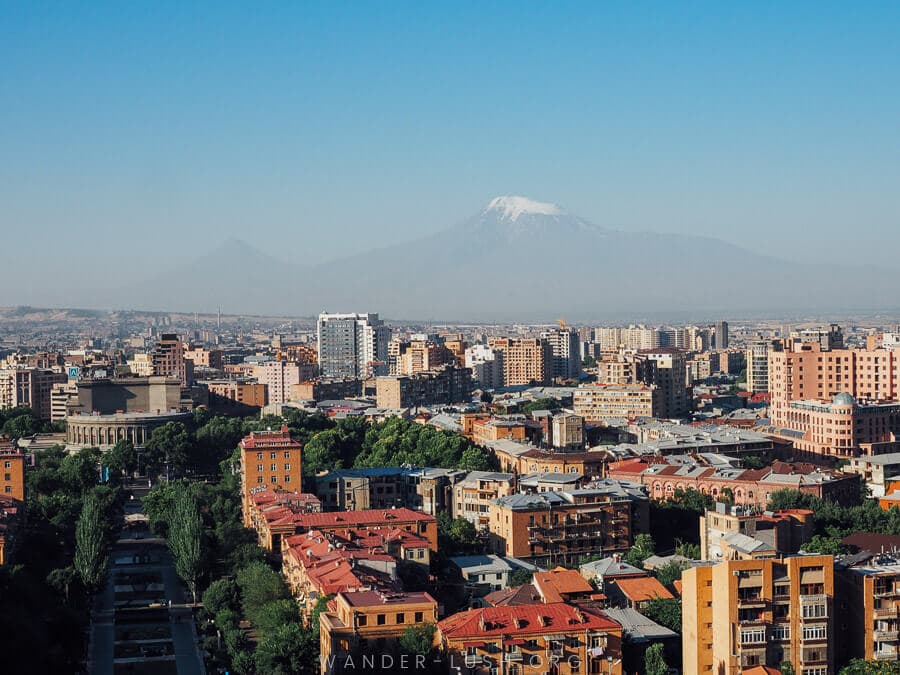
Like Tbilisi, Yerevan is another capital on the cusp of Europe and Asia. This is one of the oldest continually inhabited cities in the world. Yerevanians have weathered a recent history so tragic it almost defies belief.
Hard times have made Armenians proud of their identity and heritage, and their capital is in many ways an outward expression of that. This is where you’ll find most of the country’s top museums, cultural institutions, and restaurants that keep Armenia’s culinary traditions alive.
With its pink tuff-stone facades, wide boulevards and fountain-filled squares, Yerevan is a walking city and a photography lover’s dream. This guide brings together my favourite things to do in Yerevan plus my top visitor’s tips.
Please note: This post contains affiliate links, meaning I may earn a commission if you make a purchase by clicking a link (at no extra cost to you). Learn more.
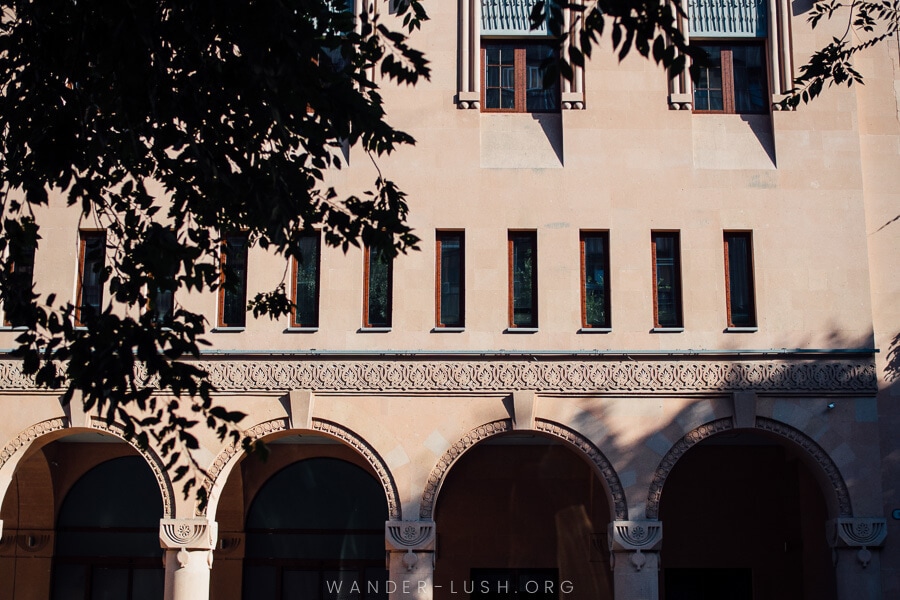
Yerevan Essentials
- Yerevan City Card: If you plan on doing a lot of sightseeing, consider picking up an official Yerevan City Pass. It grants you entry to more than 40 museums in Yerevan, city tours, unlimited rides on public transport, a complimentary SIM card, plus discounts on a number of restaurants and shops. Buy your Yerevan Card online here .
- Airport transfer: Book a private transfer to your hotel in Yerevan here . Prices start from a very reasonable $13 per group.
- Top Yerevan city tour: Short on time or want to explore the city with a local? You can now tour Yerevan in a vintage GAZ-M20 Pobeda (nicknamed ‘Stalin’s Car’), visiting Victory Park, Cafesjian, Republic Square and the Vernissage market in the comfort of a retro convertible!
- Yerevan day trips: For budget-friendly day trips around Armenia, I recommend travelling with Hyur Service . They offer a large variety of long and short itineraries with professional guides and safe drivers. Browse more Yerevan day trips here on Viator .
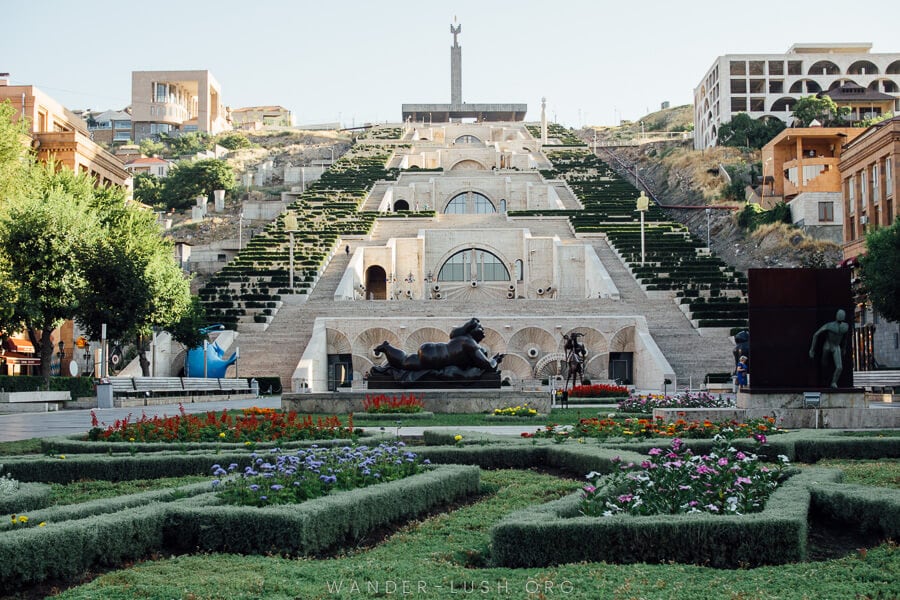
Where to stay in Yerevan
If it’s your first time in Yerevan, I highly recommend choosing an accommodation in the central Kentron District. This will put you within easy walking distance of all the top places to visit in Yerevan, terrific restaurants, bars and cafes.
I usually stay in the north-west of the city around Saryan Street.
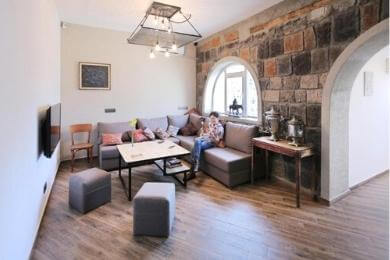
BUDGET: Highland Hostel (⭐ 9.8). This bright hostel has both a mixed dorm and a budget-friendly private double room. It is located 10 minutes by foot from Republic Square.

MID-RANGE: Republica Hotel (⭐ 9.2). This stylish hotel offers comfortable rooms decorated with traditional Armenian carpets and with views towards Ararat from the windows and balconies. The breakfast is highly regarded.

HISTORIC: Villa Delenda (⭐ 8.8). This cosy, character-filled boutique hotel is set inside a 100-year-old stone villa and decorated with gorgeous heritage furnishings. The central location in Kentron is perfect.

HIGH-END: Tufenkian Historic Yerevan Hotel (⭐ 9.1). This luxury 19th century-style hotel is located adjacent to the Venissage in the centre of the city. It features modern suites, a pool, an onsite restaurant, and in the basement, an Armenian carpet museum!
30 awesome things to do in Yerevan
This curated list brings together my favourite free things to do in Yerevan , alternative and offbeat attractions, museums and galleries, and classic Yerevan experiences that I consider must-dos!
1. Summit the Yerevan Cascade for a view of Mount Ararat
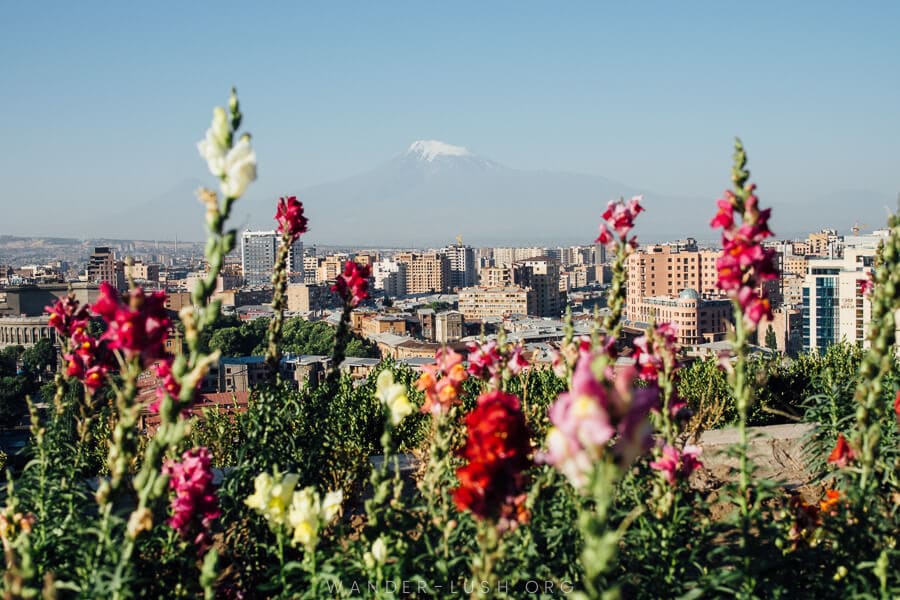
On the opposite side of the city from Republic Square, the massive limestone staircase that is the Yerevan Cascade rises up to link the lower and upper parts of the city. One of the best things to do in Armenia is climb the Cascade for a view of Yerevan and the twin peaks of Mount Ararat .
Start in the Sculpture Garden that skirts the bottom of the stairs. Here’s where you’ll find a collection of provocative and humorous works by Colombian artist Fernando Botero. ‘Smoking Woman’ and ‘Gatto’ (the cat) are my favourites.
You then have the option to climb the outdoor Cascade stairs or to head inside to the Cafesjian Museum of Art and ride the escalators to the top. Ascending the massive hillside staircase will give you close-up views of the Soviet-style stone reliefs , fountains and sculptures that decorate every tier.
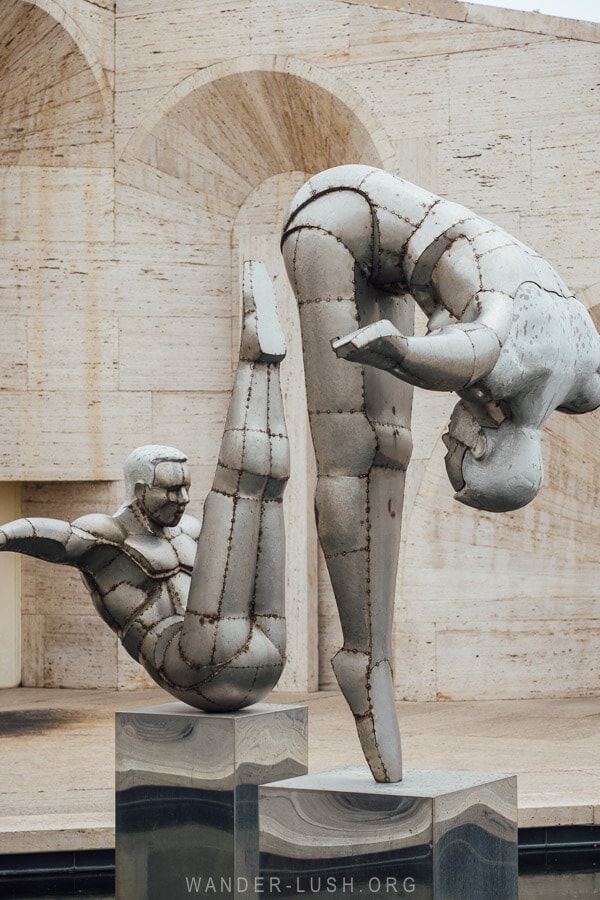
Inside, encased within the stairs, there is a series of galleries that showcase different art and design exhibitions. Four of the galleries (including the Sasuntsi Davit Gallery) are free to visit while others require a ticket.
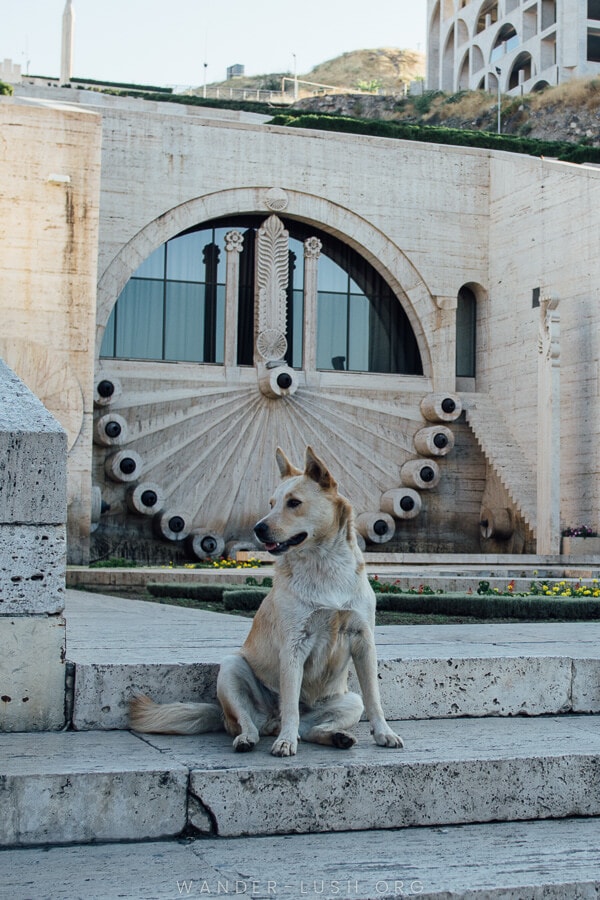
The Cascade is one of the most beautiful places in Yerevan. And it only gets better once you get to the top of the stairs – if you’re lucky, you’ll be rewarded with gob-smacking views. On a clear day, fabled Greater Ararat – the spot where Noah is said to have set down his Ark – rises above the rooftops.
Save this activity for a clear day. My best tip is to get there as early as possible, especially in summer, as the sky tends to get progressively hazier as the day goes on. Do note that the fountains aren’t turned on until mid-morning (on my last visit I was there at 10am and they weren’t running yet).
In spring and winter you can climb up for sunset and often get a clear picture of Ararat.
- Location: 10 Tamanyan Street
- Opening hours: 24/7 (outside); 8am-8pm Friday to Sunday (Cafesjian)
- Cost: Both the sculpture garden and galleries are now completely free
2. Keep on climbing to the October Revolution Memorial
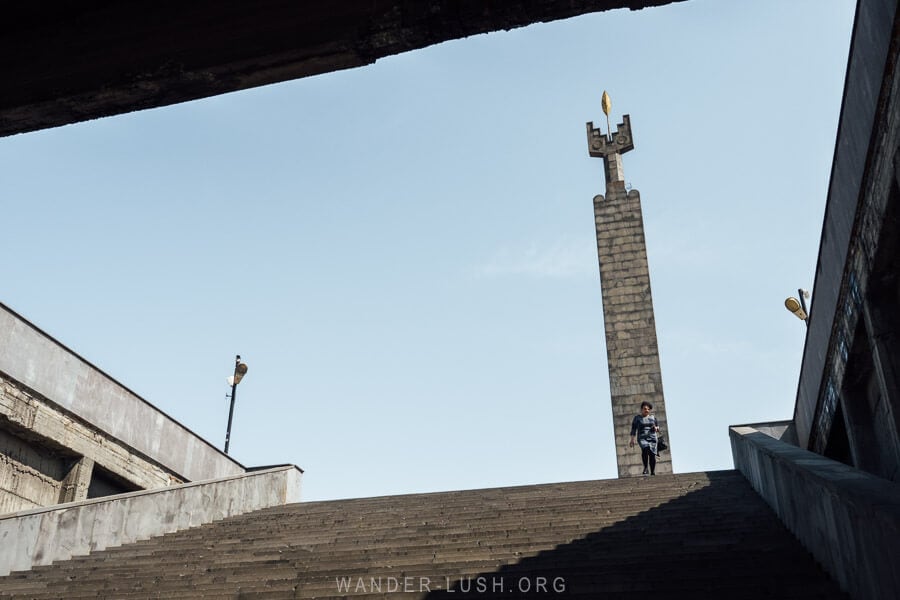
The views from the top of the Cascade are hard to beat – but if you want to continue walking, it is possible to climb even higher above the city. The October Revolution Memorial, Victory Park and the Mother Armenia statue are all located in Kanaker-Zeytun district behind the Cascade and are easy to reach on foot in around 20-30 minutes .
When you reach the top of the Cascade, take the path up on the left-hand side. You will soon be able to see the underside and inner workings of the Cascade itself, which is quite interesting!
Continue walking, following the lemon-coloured wall next to the construction site all the way until you are standing underneath the concrete structure. Use the metal stairs next to the guard box to go all the way to the top, and you will pop out inside the memorial complex.
You can get a nice photo of the obelisk and stairs from this angle, framed by the concrete overhang.
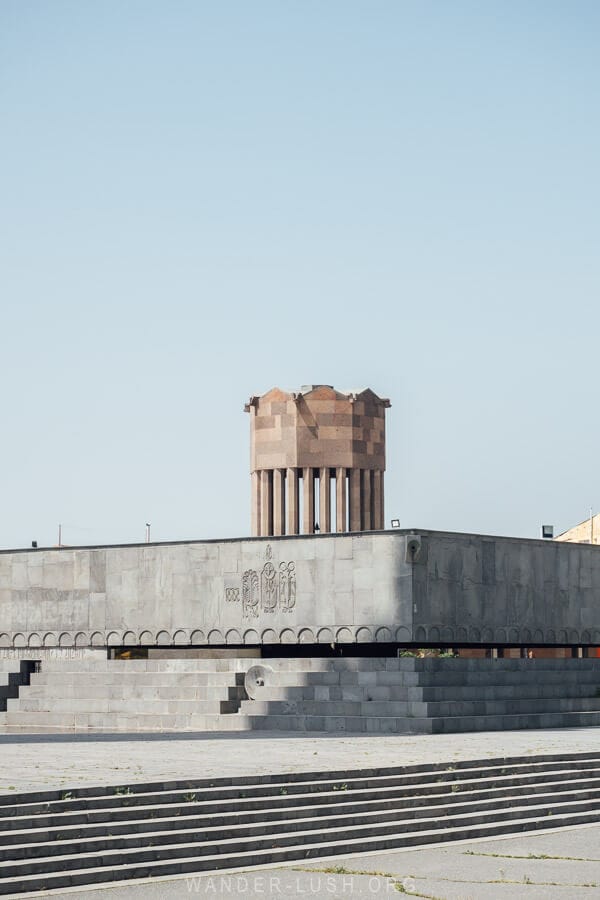
The October Revolution Memorial consists of a huge concrete plaza (the views are rather grand from here, too), a mausoleum-like stone building, and a 50-metre-tall obelisk . The obelisk is crowned with a single wheat sheaf symbolising the Tree of Life.
It was created in 1967 by Jim Torosyan and Sargis Gurzadyan to commemorate the 50-year anniversary of the Bolshevik Revolution.
3. Walk through Victory Park & say ‘hello’barev’ to Mother Armenia
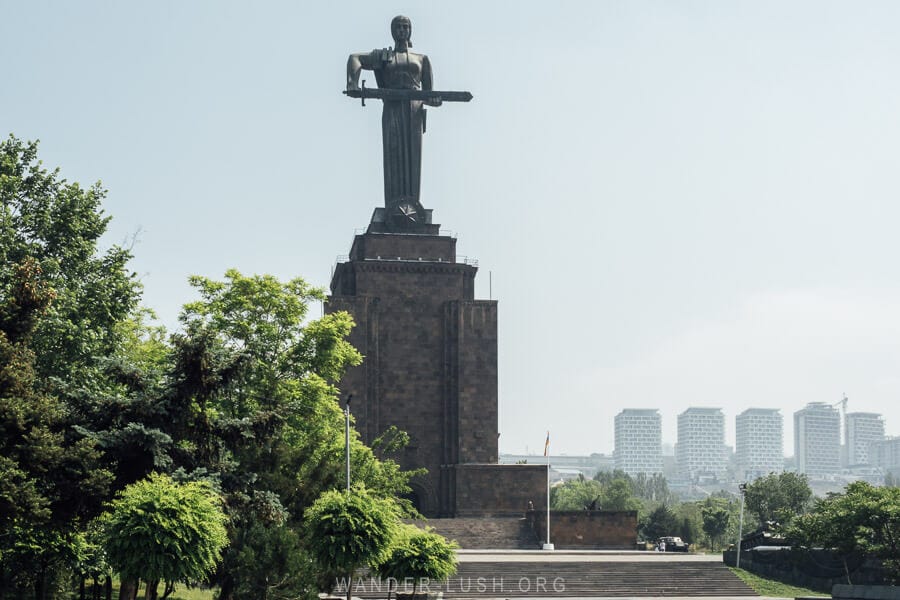
Officially opening in November 1950 after two decades of work, Victory Park is one of the biggest green spaces in Yerevan and undoubtedly commands the best views of the city.
The park has a great retro vibe (there is even an abandoned Soviet-era building inside – see the next section), with cute hand-drawn maps at every entrance. There are several more war memorials inside the park plus some beautiful khachkar stones. In the upper part there is an amusement park, an artificial lake and a ferris wheel.

When coming from the Cascade via the October Revolution Memorial, exit from the back of the memorial plaza (follow the street down a few metres to get a view of the neo-Brutalist apartment building ), then use the pedestrian underpass to cross the road. You will see one of the entrances to Victory Park directly in front of you.
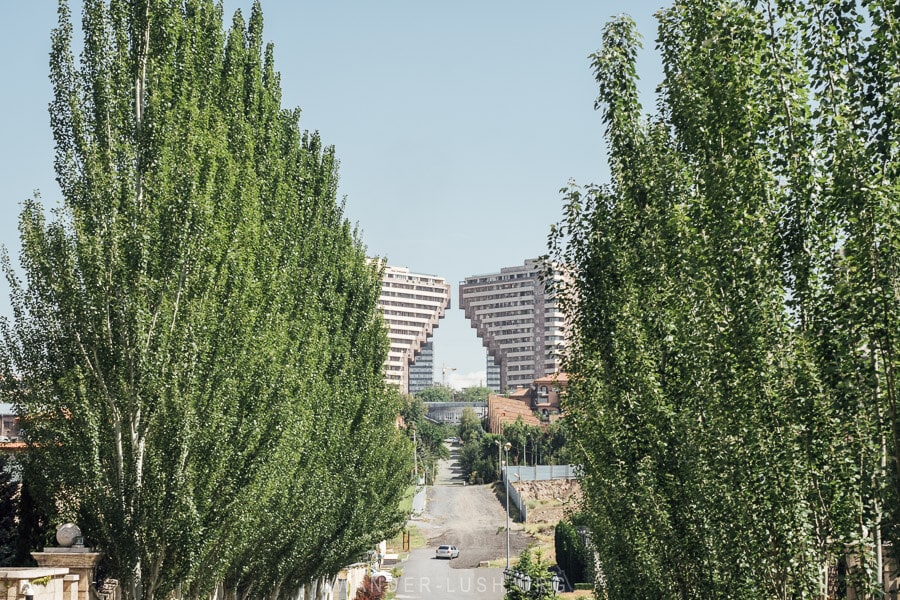
Once inside, follow the main walking path all the way along, past the abandoned restaurant (see below), and you will eventually come to a marked panoramic viewpoint, the Tomb of the Unknown Soldier and eternal flame, and the Mother Armenia statue.
One of the most conspicuous Soviet-era monuments in Yerevan, Mother Armenia is a 22-metre-high statue set in Victory Park. Originally a 17-metre-tall Stalin statue stood on this spot until the copper effigy was removed in 1962.
A symbol of ‘peace through strength’, Mother Armenia was designed by Ara Harutyunyan and bears a resemblance and similar sentiment to other ‘mother’ statues in former USSR cities (including Tbilisi, where you’ll find Mother of Georgia adjacent to Narikala Fortress ). There is a second Mother Armenia statue in Armenia’s second-largest city, Gyumri .

This statue is special for a couple of reasons. Firstly, it is modelled off a real woman, Genya Muradian. The story of how she came to inspire the sculptor is very cool!
Another thing that sets this statue apart from her sisters is the basalt-stone pedestal, which is hollowed out to form several chambers. Designed by Rafayel Israyelian, it now houses the Military Museum of Armenia . Entry is by donation.
4. Photograph the abandoned Aragil Restaurant

If you’re up for a short urbexing detour, I highly recommend stopping at the former Restaurant Aragil while you walk through Victory Park. Located at the very front of the park overlooking the city, it has an incredible view and must have been quite the spot back in the day.
I wasn’t sure what to expect when I went looking for the abandoned building. Turns out it is right off the main path that runs through the lower part of the park. The interesting part – the open terrace with a colourful floor mosaic – is outside (the main part of the restaurant building is locked) and very easy to find. I was alone and didn’t feel nervous here at all.

You can also see the old restaurant sign hanging at the front of the building, and a very interesting stone relief on the side that depicts a stork (Aragil means ‘stork’ in Armenian). Off to the side there are abandoned gazebos.
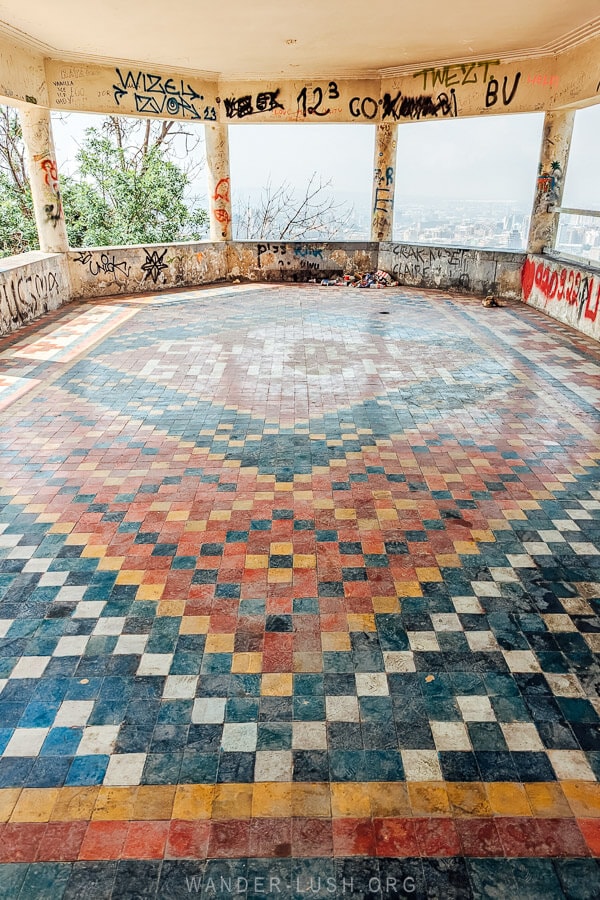
A sign on the front of the building indicates that the restaurant opened in 1960 and was designed by the Armenian architect Rafayel Israyelian (the same artist responsible for the stone Mother of Armenia pedestal). It also says the restaurant was ‘preserved and restored’ – I guess at some point there were plans to demolish it. I hope someone does eventually restore and reopen it.
5. Visit the mighty Matenadaran Museum of Ancient Manuscripts
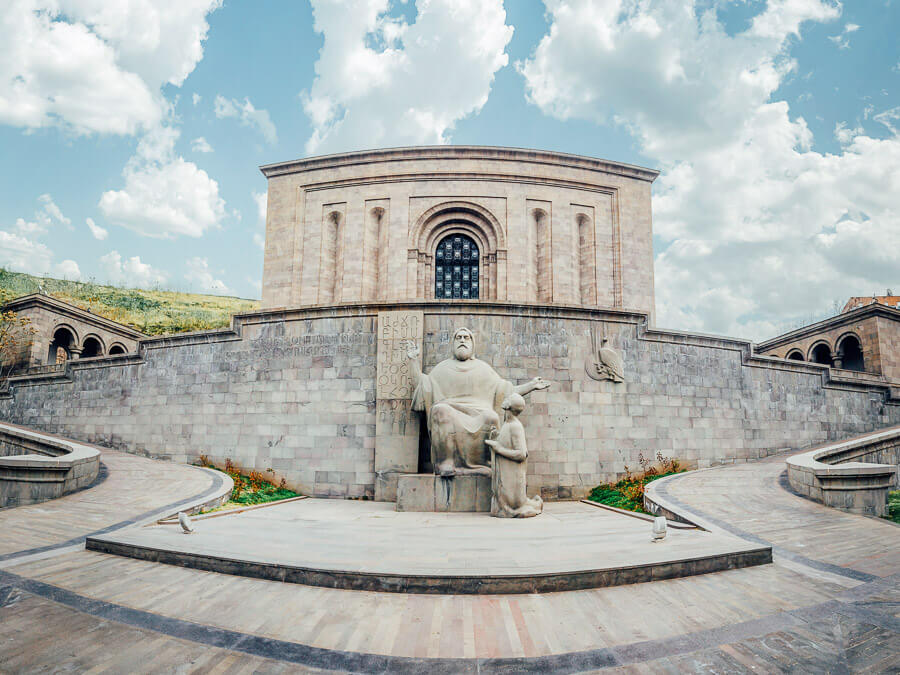
Officially the Mesrop Mashtots Institute of Ancient Manuscripts, the Matenadaran is set inside an imposing building on the hillside behind the Cascade. To get there, cross the little footbridge before the Divers sculpture then follow the lower road.
The Matenadaran is the safekeeper of the world’s largest collection of Armenian manuscripts. The institute was established in 1959 and is named after the man who developed the Armenian alphabet. The five-storey building holds an estimated 23,000 manuscripts and scrolls, plus another half-a-million archival documents, decrees and periodicals – many of them donated by the public.
A small cross-section of the collection is on display inside the Matenadaran’s stately rooms, presented in antique wooden cabinets under glass. The illuminated manuscripts are particularly beautiful, and it’s fascinating to see early examples of the Armenian alphabet, itself very unique.
The institute also has a copy of Urbatagirk , the first ever Armenian book published in Venice in 1512.
- Location: 53 Mesrop Mashtots Avenue
- Opening hours: 10am-5pm Tuesday to Saturday (closed Sundays and Mondays)
- Cost: 1,500 AMD
- Tip: You’ll need to pay an additional 2,500 AMD if you want to take photos inside
6. Grab a drink at Lumen 1936, Yerevan’s most beautiful coffee shop
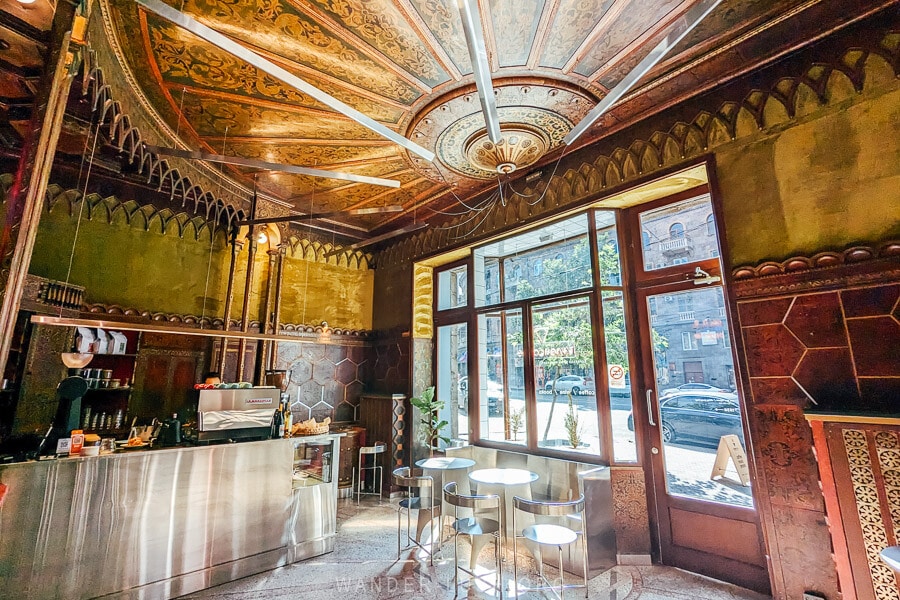
Conveniently located close to the bottom of the Cascade, Lumen Coffee 1936 is the ideal place to spot for breakfast or a drink after your morning walk.
Previously a tobacconist and a bookstore, the space originally opened in 1940 and features original painted walls, inlay ceilings and woodwork by master craftsman Hovhannes Naghashyan.
The cafe has two delightful little single-person booth seats for solo sippers plus a couple of tables. The coffee is top-notch, and they also serve breakfast (sadly I arrived before the kitchen was open so I just grabbed a croissant).
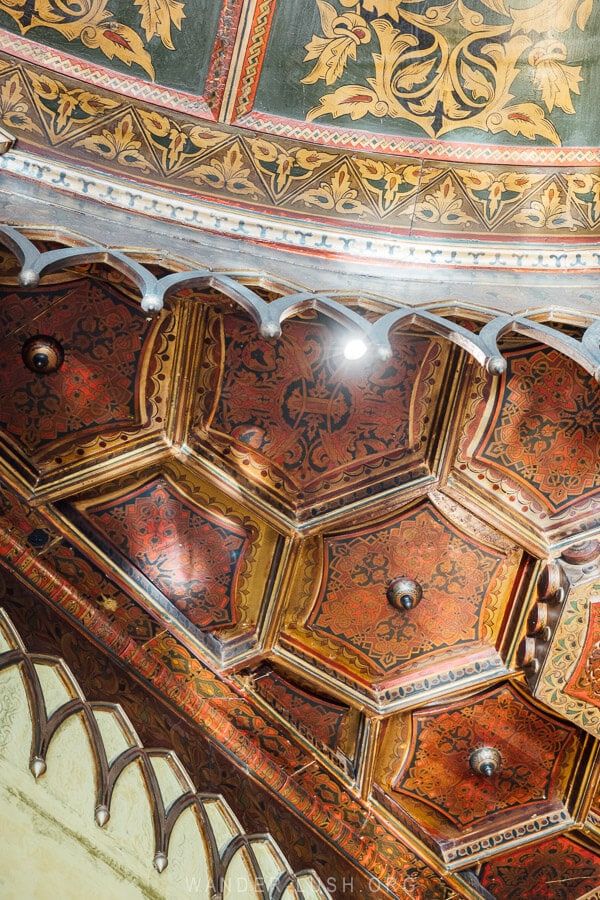
The historic fittings and morning light pouring through the front windows makes this one of the most beautiful places in Yerevan.
- Location: 45 Mesrop Mashtots Avenue
- Opening hours: Daily from 8.30am until late
7. Hunt down Yerevan street art

In early 2023 Yerevan hosted its first street art festival, the City of the Future Street Art Festival . Several large-scale murals were created as part of the event, including the work pictured above left by Italian artist Antonio Perrotta ( attorrep ), which can be seen on the facade of the Academy of Fine Arts close to Lumen Cafe.
There are at least three more murals around town – see how many you can spot during your travels around Yerevan.
Just around the corner, there is another public art project worth stopping by. The ‘Eternal Alphabet Wall’ is a set of sculptures of the characters of the Armenian alphabet created by artist and designer Vahan Balasanyan.
8. Stroll through Republic Square
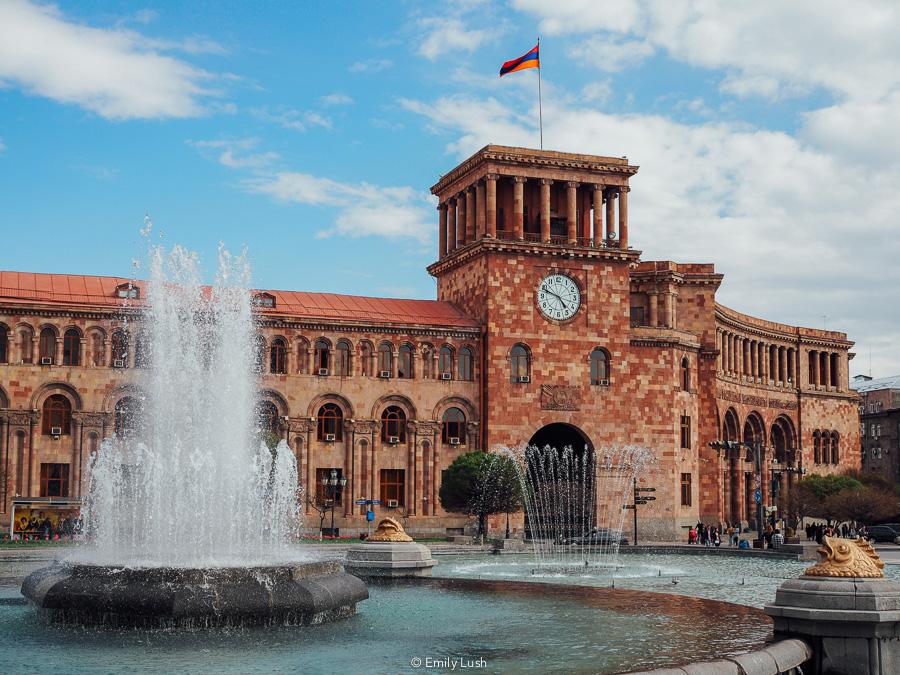
Republic Square (also known simply as ‘the Square’ or Hraparak) is the heart and social centre of Yerevan. This is where you can see some of the city’s most impressive stone buildings (including the National Museum) arranged around a large open plaza. In spring and summer, tulips and roses bloom around the edge of the square.
When it was constructed between the 1950s and 70s, city planners flattened Yerevan’s old town and erected the square right on top. That’s why Yerevan doesn’t have a defined ‘Old Town’ area like Tbilisi . At the time of my first visit in 2017, work had just started to construct a ‘new old town’ using fragments of recovered tuff stone.
Originally called Lenin Square, this was once a marching ground for military parades. Now, Republic Square is a gathering place for Yerevanites young and old – and a very popular spot to grab an ice cream cone or a cup of coffee on a sunny afternoon.
Did you know that Yerevan gets 300 days of sunshine every year? Republic Square is the perfect place to soak up some rays. Every night, the square’s Dancing Fountain lights up for a show – but I prefer this area during the day when it’s chokkas with people. The atmosphere is great.
Located at the top of Republic Square, the History Museum of Armenia houses some of the country’s most significant archaeological finds, including the famous Areni-1 shoe , a 5,500-year-old leather shoe that was unearthed in Vayots Dzor in 2008. It’s very well preserved considering it’s the oldest leather shoe in the world!
The museum collection catalogues more than 400,000 items – a testament to Armenia’s long history. Given that this region is the birthplace of viniculture, I also recommend seeking out the urns and other artefacts related to the area’s winemaking tradition should you choose to visit.
The History Museum is interesting but it is not my favourite museum in Yerevan – read on for two of my top picks.
9. Drink from a Pulpulak
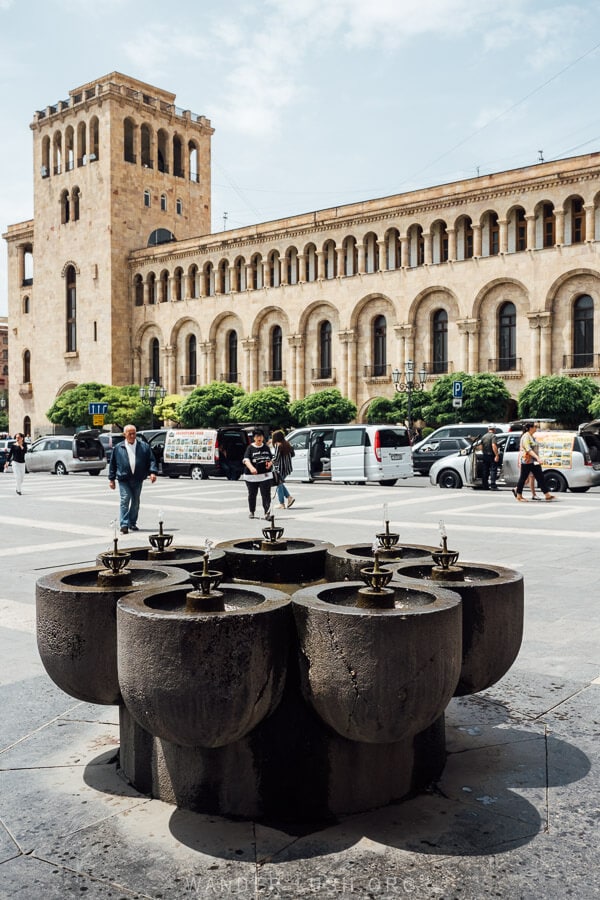
Yerevan’s drinking fountains, known as pulpulaks, are another unique feature of the city’s urban planning. Most of the fountains were erected in the 1920s. Incredibly, there are more than 1,500 in total – once you know what to look for you’ll notice them on almost every street corner and in parks and squares everywhere.
The fountain with the most impressive design is Yot Aghbyur (‘Seven Springs’) , which sits on the western side of Republic Square near the museum and has been a fixture of the city since 1965.
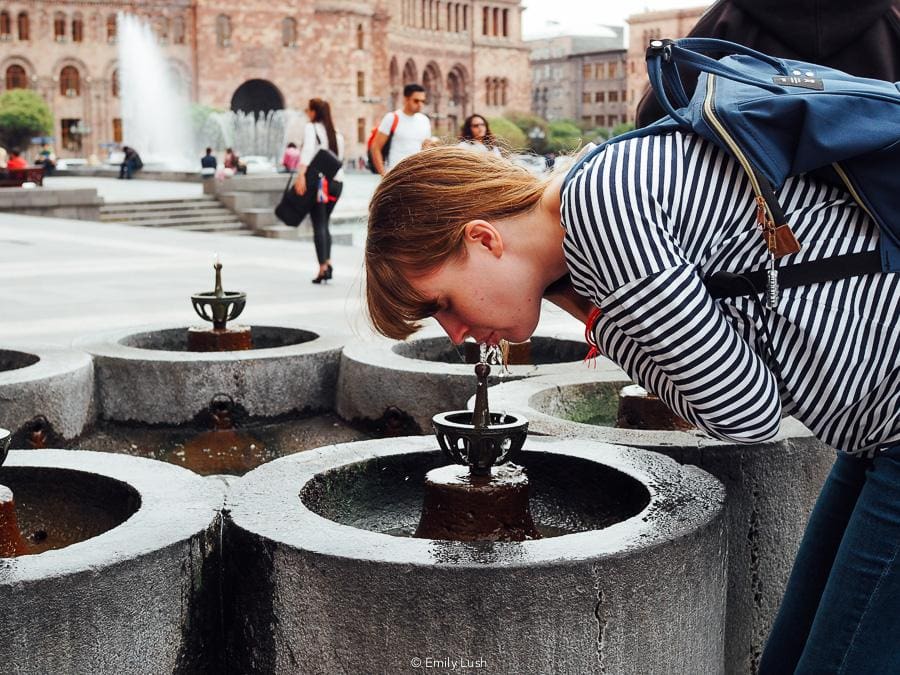
Crowds of thirsty punters queue to drink from the seven water bubblers. Do as the locals do and take a quick, healthy gulp of the fresh, icy cold water whenever you pass by – just don’t let your lips touch the fountain!
10. Step inside Katoghike, Yerevan’s most beautiful church
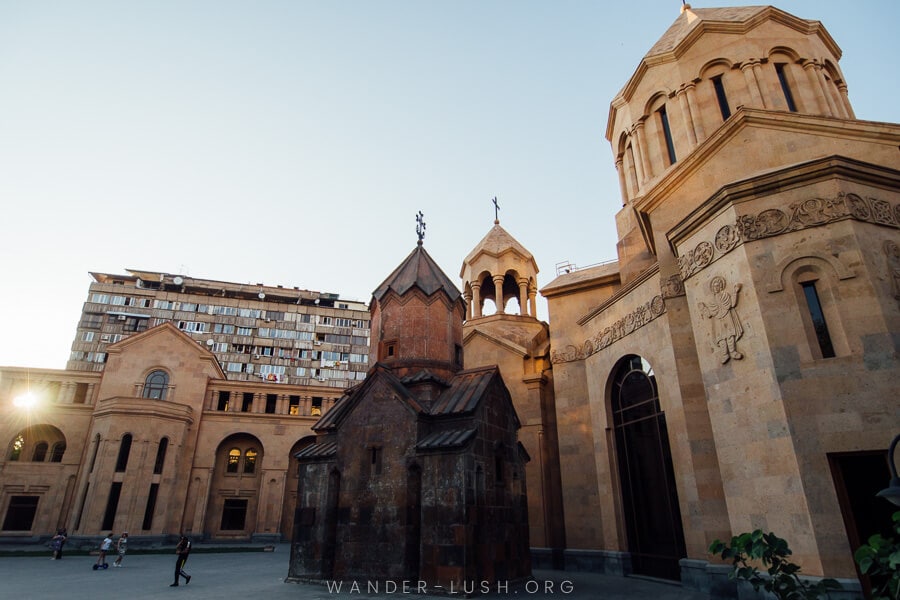
There are dozens of churches in Yerevan, most built from tuff stone in the same shades as the city’s buildings. They can be easy to miss, especially when they’re nestled at the foot of towering apartment blocks.
Katoghike Holy Mother of God Church was consecrated in 1264 , making it one of the oldest churches in the city . The complex is the result of decades of additions and reconstructions. A tiny chapel – only big enough to hold a few worshippers – is dwarfed by a new basilica that encases it.
Parts of the complex (including an original 13th-century wall) have survived all kinds of hardships, from the threat of Soviet city planning to earthquakes. In this way, I see it as something of a motif for Armenia in general. This place has a special aura and reverence about it, especially in the late afternoon when the sun sinks behind the bell tower, lighting up the plaza and illuminating the stone.
- Location: 17 Abovyan Street
- Opening hours: From 9am daily
11. Visit the Blue Mosque, the last active mosque in Armenia
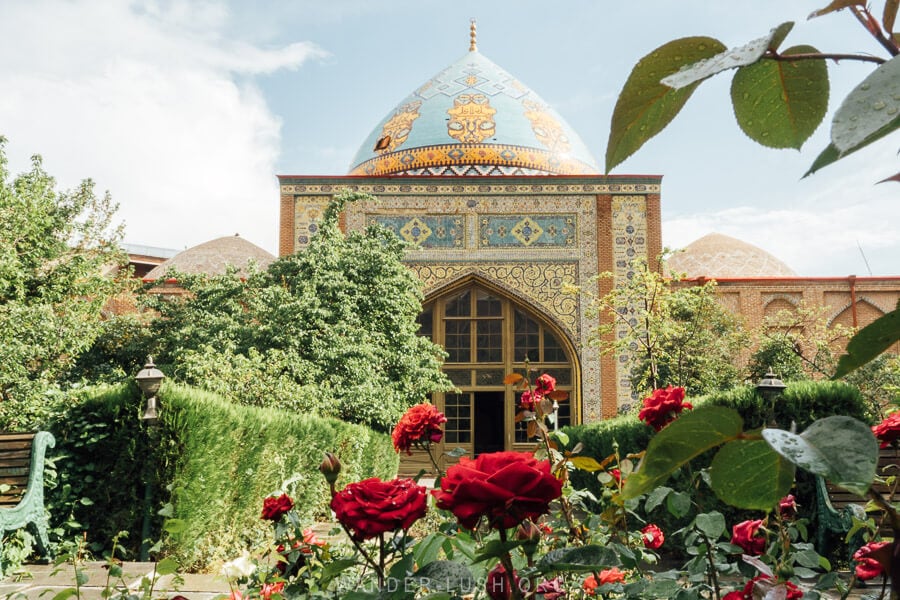
Being the first nation to adopt Christianity as its official religion, the vast majority of Armenians have worshiped the same god since 301 AD. Modern-day Yerevan is extremely diverse, with Jews, Yazidis, Kurds and Syrian Muslims all calling the capital home.
Built in the 18th century, the Blue Mosque was the largest of Yerevan’s eight mosques and is the last remaining Islamic house of worship in Armenia today. Mainly used by the city’s Iranian community and embassy staff, it’s one of the top Yerevan attractions.
In a gesture of good faith, the mosque was leased to the Iranian Embassy in Yerevan in 2015. The turquoise, indigo and butter-yellow mosaics on the facade and exterior dome were restored and can now be admired from the leafy gardens out front. Don’t miss the elaborately decorated entrance that faces onto the road.
The mosque doubles as a cultural centre, offering classes in Farsi. It’s possible to go inside when prayers are not in progress – I haven’t ventured in myself, but from photos, the brick domed interior looks impressive. Appropriate dress (including a head covering for women) is required if you want to venture any further beyond the garden.
At the time of my most recent visit there was a pop-up shop inside one of the ancillary buildings. This meant that I could go inside one of the rooms and view the convex brick dome and tile work that decorates the interior.

The Blue Mosque is a symbol of the cordial relationship between Armenia and neighbouring Iran. The two countries have a visa-free tourism arrangement (a huge number of Iranians visit Yerevan every year), and Iran has allowed Armenia to preserve several Apostolic churches that fall within the Islamic Republic’s borders.
- Location: 12 Mesrop Mashtots Avenue
- Opening hours: 10am-1pm & 3pm-6pm daily
12. Rummage for treasure at the Vernissage Market
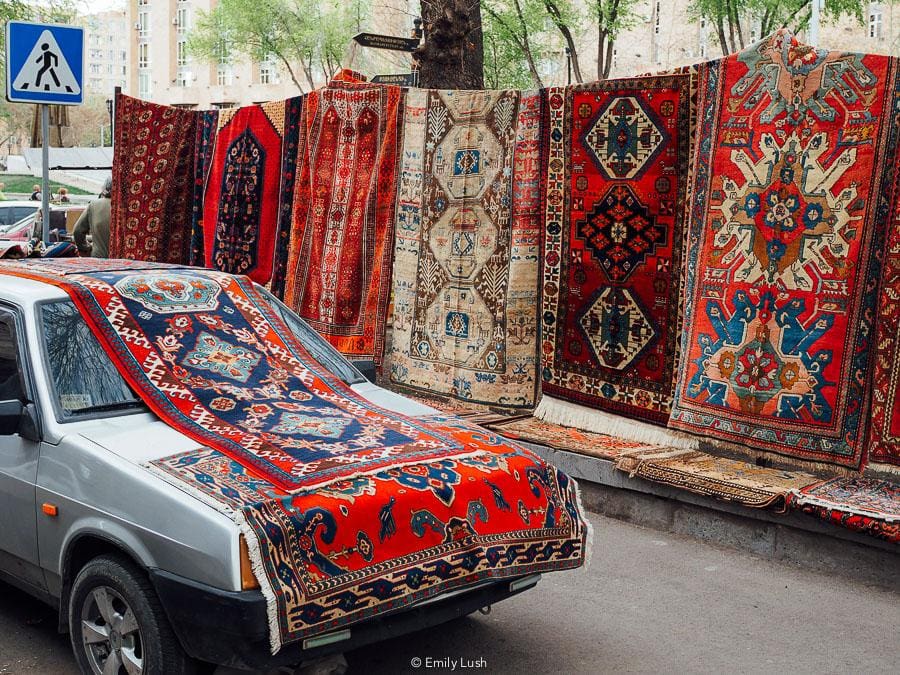
A must see in Yerevan, the city’s biggest outdoor market, the Vernissage, occupies all of the central Charles Aznavour Square. It began in the 1980s when a group of local painters started displaying their works outside the art institute on Buzand Street. Today it’s a huge indoor-outdoor market selling everything from canvases and carpets to second-hand treasures and handcrafted souvenirs .
As a rough guide, you can find most artists and craftspeople in the undercover section while antiques and vintage items are sold out back.
My favourite part of the Vernissage is the carpet section. Vendors set up along the side of the market, displaying a dizzyingly beautiful array of Caucasian rugs hung on tree branches and draped over the hoods of vintage cars.
Browse the rows of stalls, meet the artisans, rummage for antique coffee pots and cute knick knacks, then walk yourself up and down ‘carpet row’ a couple of times. The Vernissage is similar in some ways to Tbilisi’s Dry Bridge Market , but there are more handmade products versus antiques.
- Location: Buzand Street
- Opening hours: Daily from 7am-6pm
For tips on shopping for textiles at the Vernissage Market and elsewhere in Armenia, check out my Textile Lover’s Guide to the Caucasus .
13. Browse Yerevan’s small galleries & boutiques
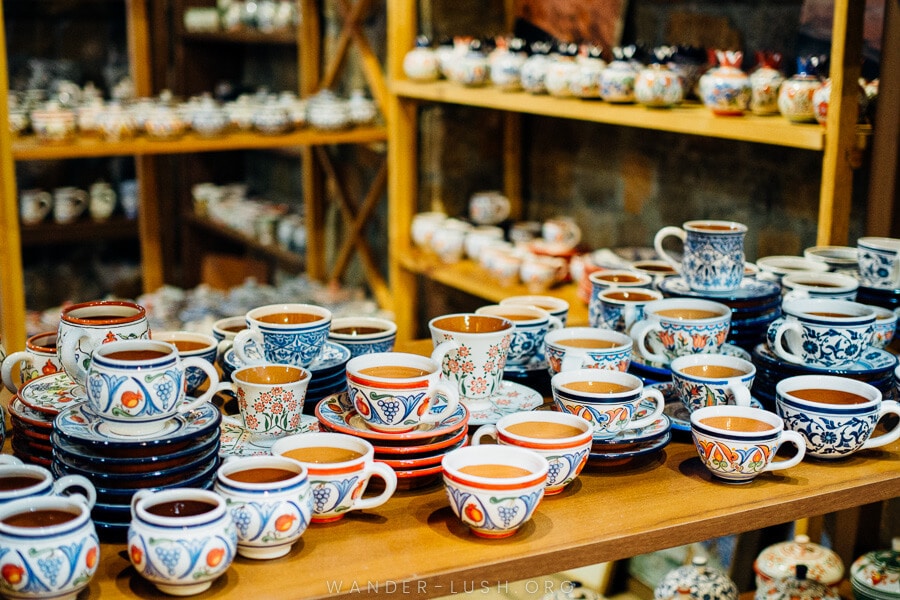
The whole of Yerevan sometimes feels like an outdoor gallery, with painter’s easels, street performers, murals and colourful cafes on every corner. There are plenty of small galleries and boutiques where you can browse Armenian art, ceramics and handicrafts.
Dalan is one of my favourite gallery spaces and doubles as a souvenir shop. This is where the famous and much-photographed wall of plates is located.
Whether it’s fashion, hand-painted ceramics, tea, honey and other edibles, knickknacks, Soviet memorabilia or textiles you’re after, you’ll find it for sale in Yerevan.
→ For more advice on what to buy in Yerevan, see my guide to Armenian souvenirs and Yerevan shopping map .
14. See how lavash is made at the GUM Market
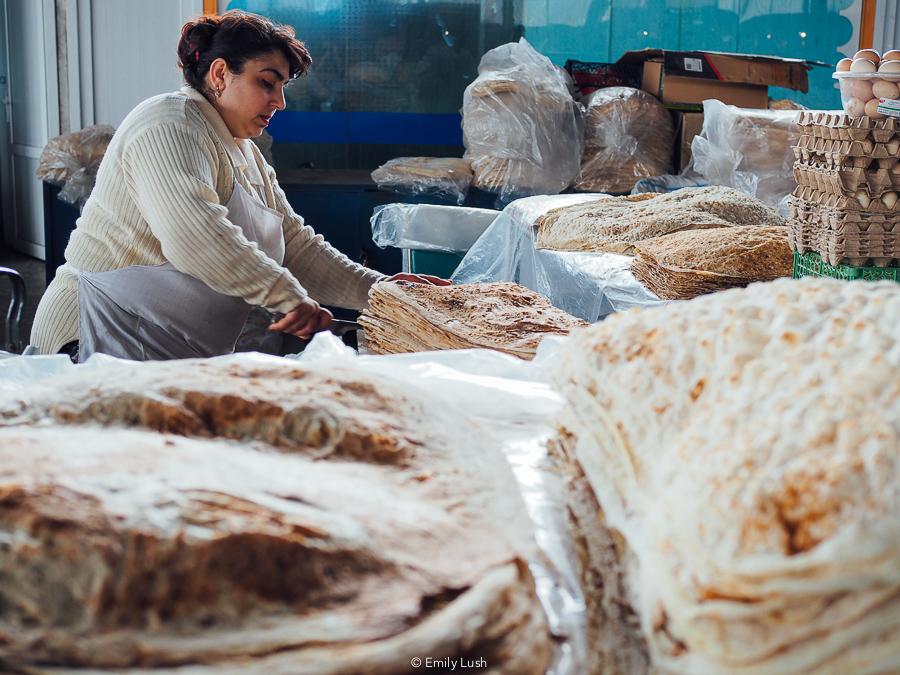
In Armenia, lavash is an essential accompaniment to every meal. The technique and ritual involved in making and eating this paper-thin bread is so intertwined with Armenian heritage that in 2014, UNESCO recognised it as part of the country’s intangible cultural heritage.
Lavash comes in an astounding array of colours and textures, each one more delicate and airy than the last. The best place to see huge lavash sheets being prepared and sold is at the GUM Market on Movses Khorenatsi Street.
This is one of my favourite markets in the Caucasus. It’s relatively small, but I always spend a good hour here roaming the aisles, trying to guess what the more foreign-looking items might be, taste testing (people are always offering samples!), and photographing the vibrant displays.
The lavash shops are along the left-hand wall of the main hall. At the front of the market you’ll find candied fruits and nuts. Don’t miss the back section where the fresh produce and pickles live!
If you’re curious to see how Armenian lavash is made, check out this short video I made on a day trip from Yerevan:
→ For more photos and tips, see my guide to visiting the GUM Market.
- Location: 35 Movses Khorenatsi Street
- Get there: 5-minute walk from Zoravar Andranik metro station (2 stops from Republic Square)
- Opening hours: 11am-5pm daily
- Tip: I recommend visiting around noon when the market is liveliest
15. Ride the Yerevan Metro & admire the station architecture

In the Soviet era, when a city’s population hit one million people a state-sponsored metro would be built for the people. Anything less, and a simple tram system would suffice.
I’m told that Yerevan’s population never met the threshold but the city managed to bypass these rules by convincing authorities that the repatriation of the Armenian diaspora would cause the population to balloon. (It didn’t – in fact, Yerevan’s population wouldn’t hit one million until 2012!)
Yerevan’s metro line officially opened in 1981 and services just 10 inner-city stations (with two more on the way). Tunnels are burrowed 20-70 metres below the streets, and some stations are located above ground. It’s an easy way to travel from one side of the city to the other – and riding the metro is a fun experience in and of itself.
Yerevan’s metro is very retro – some of the original blue cars still shuttle along, and the system continues to operate on a plastic token system. To ride the trains, you must first exchange a coin for a plastic token at the cashier desk inside the entrance. Alternatively, you can buy a rechargeable metro card or pick up a Yerevan City Card , which includes free public transport.
You can find some great examples of quirky metro station art and architecture in Yerevan, with the most impressive Soviet-style wall friezes located on the platforms at Yeritasardakan Station and Barekamutyun Station.
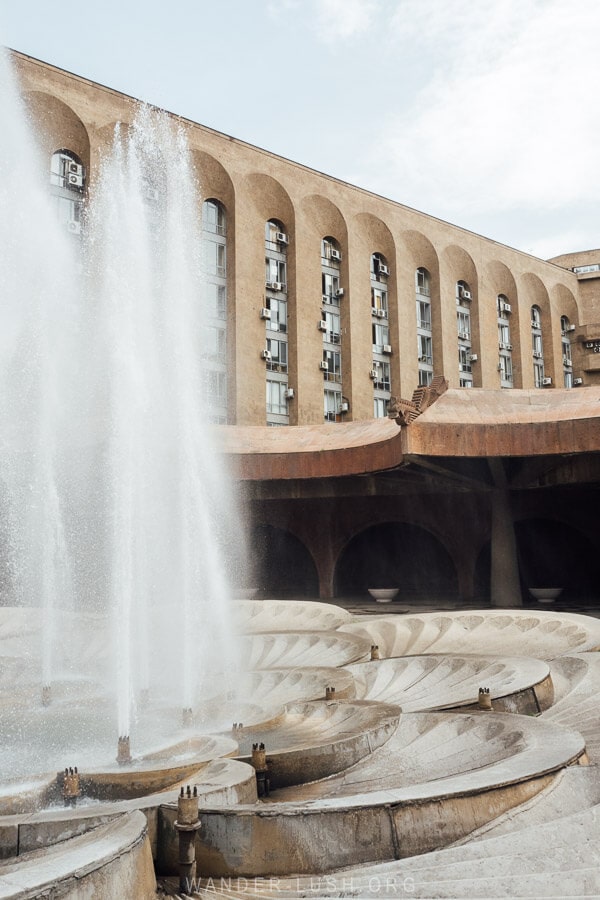
The underground Republic Square Station is very impressive as well, with its sunken fountain and sculptural roof opening (pictured above).
- Opening hours: The Yerevan Metro runs from 7am-11pm daily
- Cost: 100 AMD per ride
- Tip: Station names and directions are written in English on the tunnel walls
16. Seek out Yerevan’s Soviet throwbacks
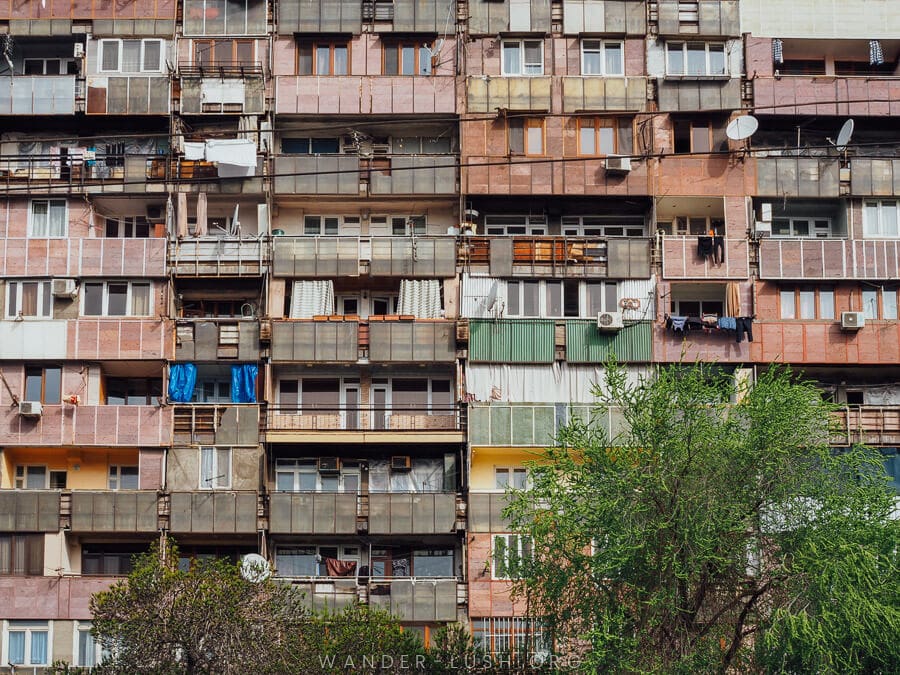
Armenia was a Socialist Republic for almost 70 years. Some of the city’s most prominent landmarks went up during this period, including the Opera House and Republic Square.
There are reminders of Armenia’s not-so-distant Soviet past all over the city – fans of Brutalist architecture and Soviet nostalgia are guaranteed to have a field day.

Apart from the spots already mentioned in this guide, other prominent examples of Socialist architecture in Yerevan include the hulking ‘Commieblock’ apartments around Andranik Metro Station (you can visit these on your way to the GUM Market).

Then there are the not-so-obvious Soviet-era constructions – many of them abandoned and untouched since the collapse of the USSR. I’ve heard there is an abandoned Soviet sports complex near the Genocide Memorial that’s become popular among urbexers in recent years. I’ve never been able to find it – if you have any leads on the exact location, please let me know!
17. Watch the weavers in action at the Megerian Carpet Museum

If you’re a fan of textiles and traditional crafts, don’t miss visiting the Megerian Carpet Museum. The location is a bit further out and requires a taxi ride from the centre, but it’s worth it to visit one of the most interesting places in Yerevan.
This private shop-museum is owned by a local family and exhibits a huge collection of antique and newly woven Armenian and Caucasian rugs. Wander through the carpet-laden rooms and compare the patterns and colours of different regional schools. Weaving and dyeing demonstrations usually take place during the day.
If you’re in the market to buy an Armenian carpet, this is one of the best places to find an authentic original or hand-woven replica.
If you don’t have time to venture out to Megerian, there is a second (much smaller) demonstration workshop and carpet museum-shop located in the bottom of Tufenkian Heritage Hotel , near the Vernissage Market (pictured above).
- Location: 9 Madoyan Street
- Get there: 20-minute walk from Garegin Nzhdehi Square metro station or 10-minute taxi ride from Republic Square
- Opening hours: 10am-5pm Monday to Saturday (closed Sundays)
18. Spend an afternoon at the Lusik Aguletsi House-Museum & Cafe, one of my favourite hidden gems in Yerevan

Lusik Aguletsi House-Museum & Cafe is my new favourite place in Yerevan. It opened back in 2018, but somehow I didn’t hear about it until 2023.
Born in Nakhchivan in 1946, Lusik Aguletsi was a painter and ethnographer who advocated for the preservation of Armenian culture. She relocated to Yerevan in 1953 and moved into her husband’s family home on a quiet street behind the railway station. This is now the venue for a house-museum dedicated to documenting her life’s work.
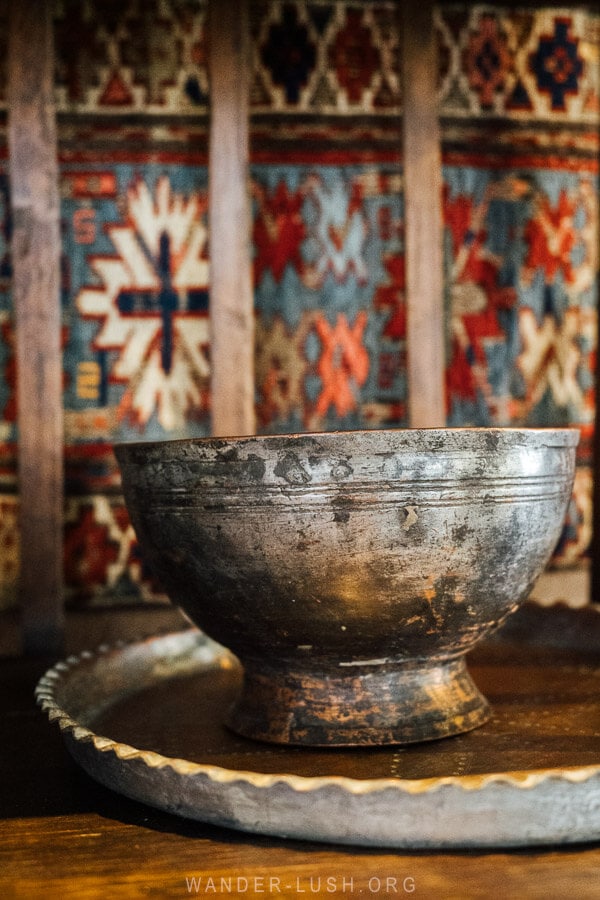
Lusik famously wore Armenian national dress every day. A large part of the museum collection is made up of embroidery and textiles that she sewed herself. You can also see a huge assortment of folk puppets, Lusik’s own canvases, and other cultural objects that she collected over her lifetime.

Part of the house has been converted into a restaurant where you can sit down for a meal amongst the antiques. I ordered the cucumber and basil lemonade and the arishta, a traditional Armenian pasta served with vegetables.
It was honestly one of the best meals I have had in Yerevan. I highly recommend eating here, then taking the short (free) tour of the museum.

Lusik Aguletsi House-Museum & Cafe is walking distance from the Sasuntsi David Metro Station. On the way, stop to see the equestrian statue of David of Sassoun , located in front of the equally impressive railway station.
- Location: 79 Muratsan Street
- Get there: 15-minute walk from Sasuntsi David Metro Station
- Opening hours: Daily from 12pm-7pm
- Cost: Free (donations welcome)
19. Visit the house museum of filmmaker Sergei Parajanov

Another excellent museum and one of Yerevan’s quirkier institutions, the Sergei Parajanov House Museum is a small museum dedicated to the filmmaker and pioneer of 20th-century cinema who was born in Tbilisi but lived (and died) in Yerevan.
The museum recalls Parajanov’s avant-garde career through a collection of eclectic (sometimes irreverent) films, mixed-media collages and personal possessions . It’s a treasure box of curiosities and there are some truly wonderful art pieces in the mix. You really get a feel for his character and personality when you walk through.
Parajanov’s cult classic film, The Color of Pomegranates (1969), plays on a loop on a TV inside the museum. I highly recommend watching the movie before you visit the Caucasus region . You can buy it on DVD here .
- Location: Dzoragyugh 1st Street
- Get there: 15-minute walk from the Blue Mosque (near Kond)
- Opening hours: 10.30am-5pm daily
- Cost: 1,000 AMD
20. Explore Kond, Yerevan’s oldest neighbourhood
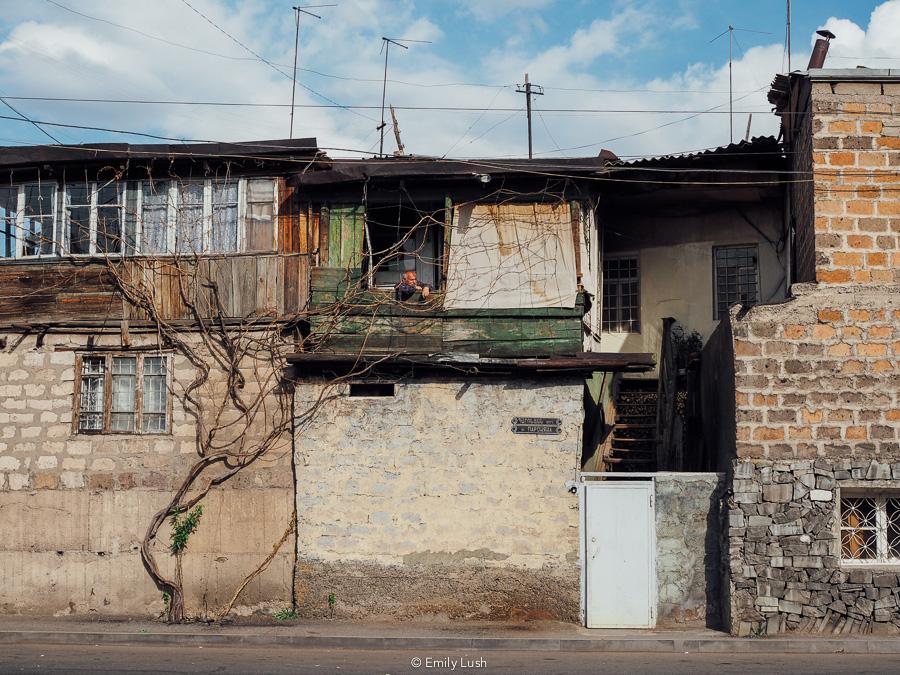
While you’ll probably spend most of your time in Kentron, Yerevan’s central district, you should also get out to explore Kond, a much smaller neighbourhood on the city’s western fringe. This is one of the best places in Yerevan to go for an aimless stroll.
In the absence of an official old town, the accolade of Yerevan’s oldest area goes to Kond. The neighbourhood is elevated on a hillside and can be reached either by steep street or via any one of the narrow staircases that lead up from the main road. Kond is mainly residential with an assortment of character-filled, tumbledown houses , overgrown gardens, and patched-up shacks.
Don’t be expecting a picture-perfect old town; Kond is a bit rough around the edges but beautiful in its own threadbare way. If you enjoy architecture and street photography , this is a great place to get lost for a couple of hours.
While in Kond, don’t miss the Saint Sarkis Cathedral , a humble church made from orange tuff stone sourced from Ani. If you need a break from walking, stop for a coffee and chat at Kondi Hayat , a new cafe in Kond.
21. Walk through the Kond Pedestrian Tunnel to Hrazdan Gorge
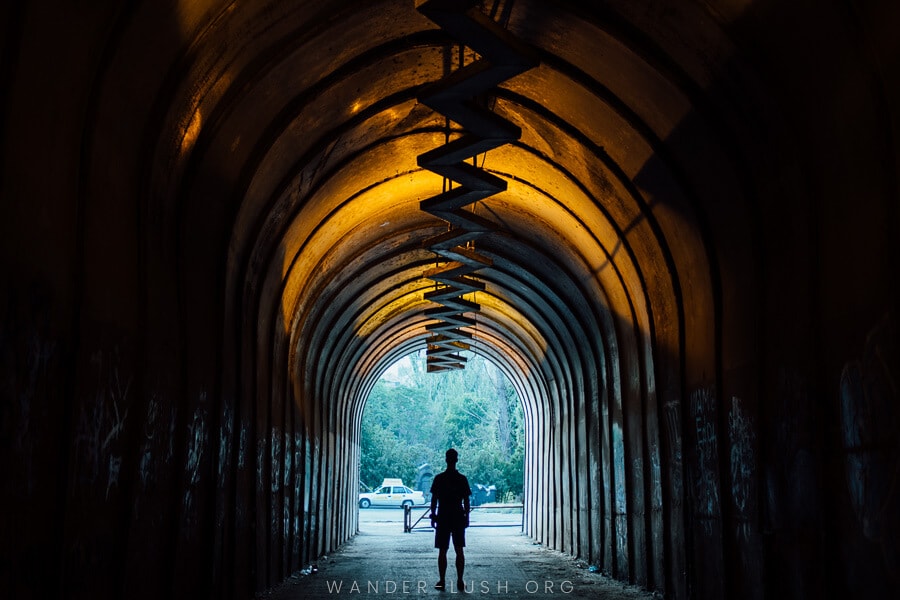
The Kond Pedestrian Tunnel is one of the many hidden gems in Yerevan. Built in the Soviet era, the long pedestrian walkway cuts under the Kond neighbourhood, joining the city centre from Saryan Street with Hrazdan Gorge.
Sections of the dimly lit 500-metre tunnel are decorated with graffiti and street art. On any given afternoon you’ll find the tunnel full of couples walking arm in arm, families out for a stroll and kids riding their bicycles.
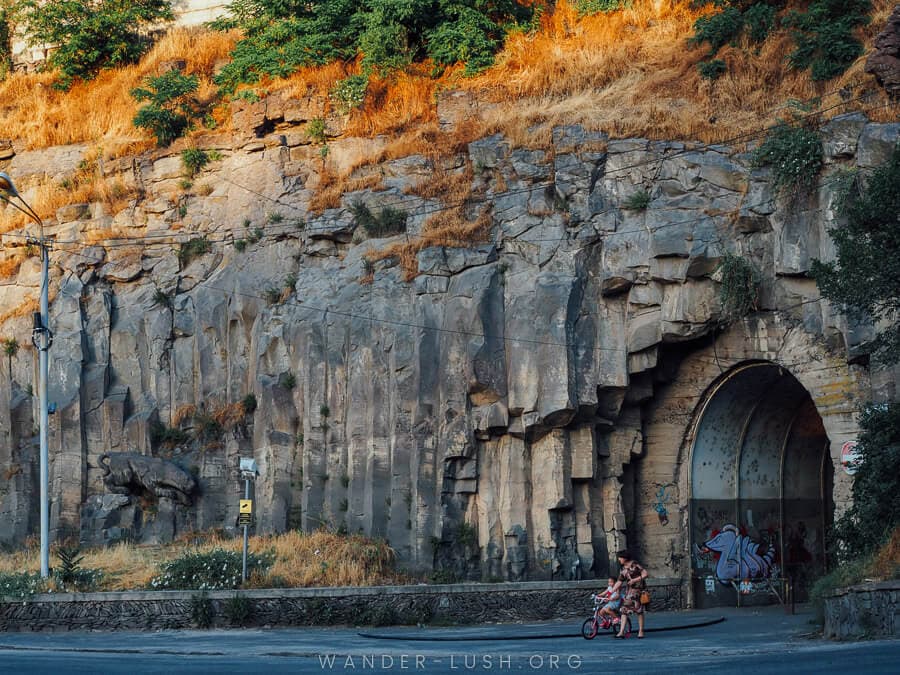
At the end you emerge in Hrazdan Gorge , an unexpected urban green space that runs along the edge of the city by the river. Emerging from the tunnel on the other side of the rock wall, you almost immediately feel as if you’ve escaped the city and been transplanted to an urban oasis.
This is a great place to stroll in the fresh air. The Armenian Genocide Memorial can be spotted on the hill above the river, and you can follow the low path all the way around to the Ararat Yerevan Brandy Company factory . There’s even a zip line in the gorge.
22. Find the Children’s Railway
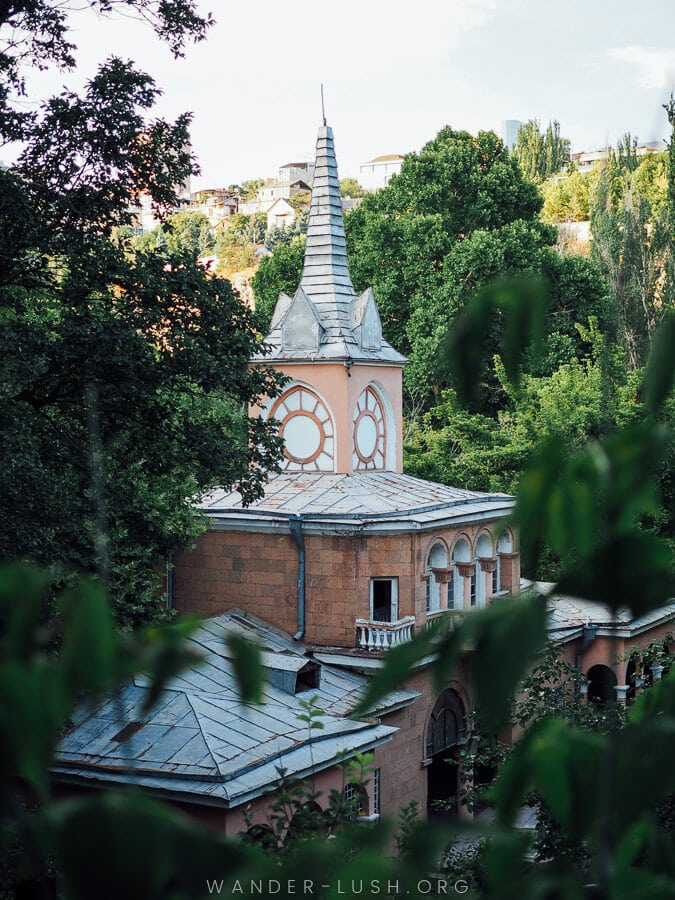
As you walk north along Hrazdan Gorge you’ll notice an apricot-coloured, castle-like building peeking out through the shrubs. This is the main station building for the Children’s Railway.
In Soviet times, this miniature railway was an interactive classroom where kids could come and learn about train engineering. The 2-kilometre track is still functioning and in the warmer months, you can see groups of excited little faces peeking out as the locomotive chugs along through the gorge.
The wooden station building is dated 1937 and is a blast from Yerevan’s Soviet past. Photograph the architecture, stroll through the nearby amusement park, or follow the railway track to find a natural swimming pool by the river.
23. See the whimsical wall drawings at the Khnko-Aper Children’s Library
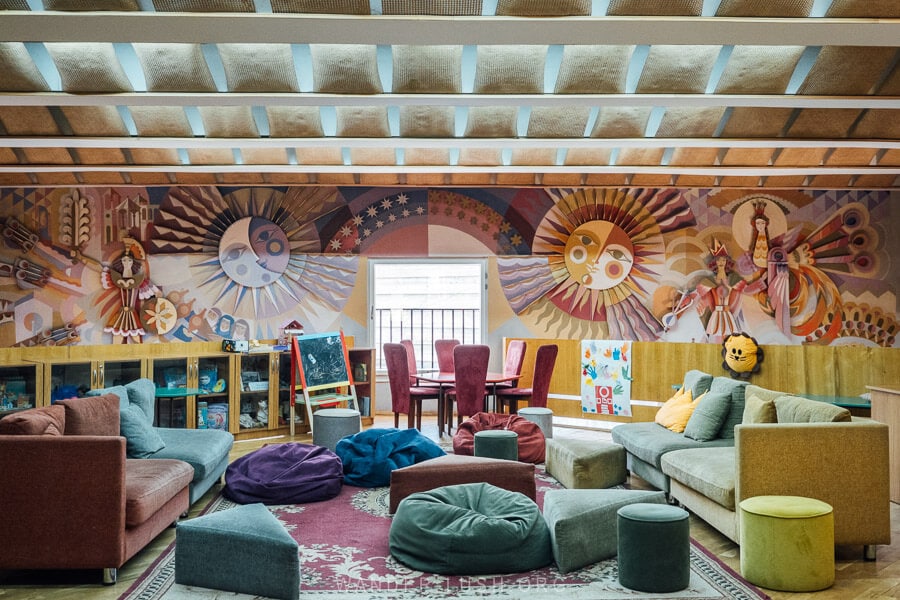
I stumbled on this library completely by accident when looking for places to visit near Freedom Square. After seeing some interesting photos of wall murals on Google Maps, I decided to wander in… As I so often do, I walked through the lobby with purpose and no one gave me a second look.
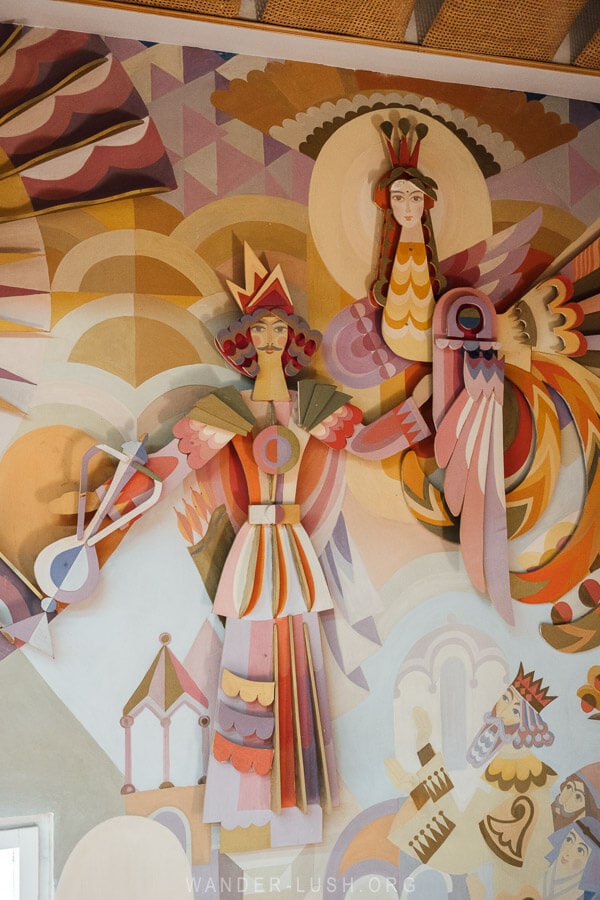
Armenia’s national children’s library, Khnko-Apor was founded in 1933 and houses a collection of more than half a million books . There are dozens of different reading rooms (including Iranian and German halls) that seat up to 100 people, plus children’s play areas and educational spaces.
Rooms of particular note include the children’s reading room on the second level, and the reading room on the third floor. Both are decorated with hand-drawn illustrations that, as far I can tell, were created in the 1980s.
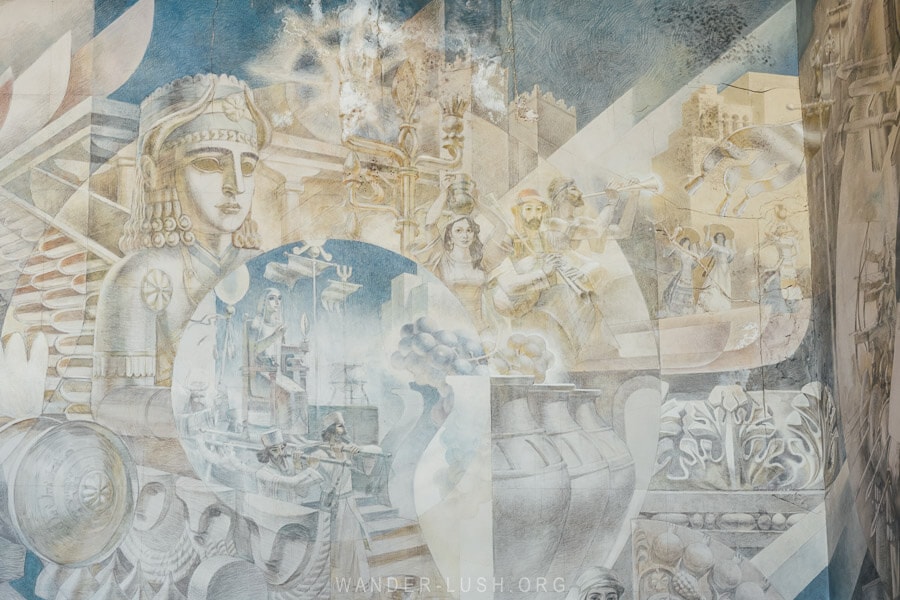
At first I couldn’t find the murals I was looking for, so I asked a staff member – she spoke perfect English and kindly showed me which doors I should look behind. As I kept exploring, I met a couple of other librarians who were all equally warm towards me and were happy for me to take photos.
- Location: 42/1 Teryan Street
- Opening hours: Monday to Saturday from 10am-5pm
24. Stop by the historic Moscow Cinema
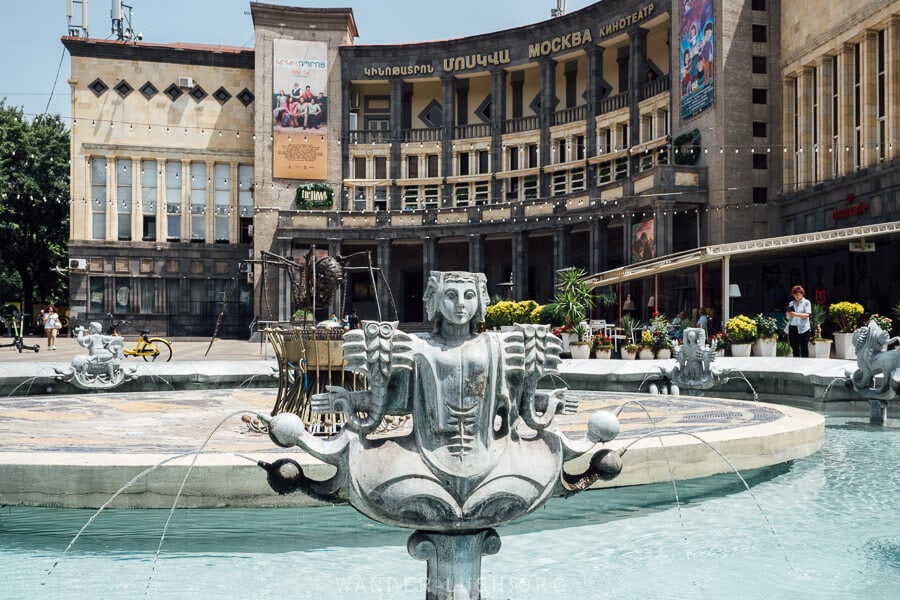
Built in 1936, the Moscow Cinema is one of Yerevan’s main landmarks from the Soviet period. It has been redesigned several times but it has kept the same name (emblazoned on the front entrance in both Armenian and Russian) – and it still serves its original purpose. Its four theatre halls show new release movies and host the annual Golden Apricot Yerevan International Film Festival.
The concave facade has some interesting design details, and on both sides of the building you can see Soviet-style decorations. This is a public building and you are welcome to wander in for a look: As well as movie theatres, there is also a hotel inside (and on the second floor, a free and very clean restroom if you need it!).
I walked up to the movie theatre entrance and made a fabulous discovery – in one corner, partially hidden behind a movie poster, there is a very interesting Soviet-style bas relief that depicts music, theatre and the arts. Named ‘Gorani’ (I assume after the famous Western Armenian folk song), the clay sculpture was created in 1984 by architects B. Arzumanyan and E. Safaryan and artists V. Atanian and A. Hovsepyan.

Yerevan’s Saint Paul and Peter Church once stood on this spot before it was demolished by the Soviets in the early 1930s. Today the cinema opens out onto Charles Aznavour Square , where there is a very cute astrological fountain with Zodiac characters, plus a contemporary spider sculpture by Ara Alekyan crafted with debris from the 1988 Spitak Earthquake.
- Location: 18 Abovyan Street
25. Tour the Ararat Brandy Factory

The orange stone Ararat Brandy Factory building is one of the most recognisable landmarks in Yerevan. Inside, one of Armenia’s most iconic products comes to life: Ararat Brandy.
Established in 1887, Ararat is one of the oldest liquor companies in the Caucasus. The Yerevan facility houses 15,000 barrels – or one third of the company’s stock – and doubles as a museum and tasting room, where you can partake in a guided tour and brandy tasting .
I was always on the fence about whether or not to do the factory tour. On my first few visits to Yerevan, I skipped it – but when I recently visited again with my dad, he was eager to try it.

The tour is quite pricey – we paid 12,000 AMD per person for the most expensive program, the Ararat 10 Tour. That included tastings of three decade-old brandies, Akhtamar, Armenia and Dvin. Regular guided tours without tastings are also available for 4,500 AMD.
Our guide was extremely knowledgeable and professional – I actually really enjoyed the tour. If you have a spare hour and the history of brandy interests you, I think it’s worth adding to your Yerevan itinerary.
Bookings are recommended – we got lucky and arrived just as a group tour was starting, but normally you need a reservation to guarantee your place, especially if you’re visiting in the summer high season.
Competitor company Noy Brandy also offers guided tours and tastings at their facility on the opposite side of Victory Bridge.
- Location: 2 Admiral Isakov Avenue
- Get there: 5-minute taxi ride from Republic Square
- Opening hours: Daily from 9am-6pm
- Cost: 4,500-12,000 AMD ( reservations here )
26. Visit the Armenian Genocide Museum & Memorial

While you’re out enjoying the finer things Yerevan has to offer, remember that things haven’t always been so rosy. The events of 1915 cast a long shadow over Armenia and are never too far from people’s memory.
As an Australian I’m embarrassed to admit that I knew nothing about the Armenian Genocide before I arrived in Yerevan. As uncomfortable as it may be, taking the time to learn about this chapter of world history that many of us have forgotten about is an absolutely essential part of any visit to Armenia.
The best place to learn, reflect and pay your respects is at Tsitsernakaberd, the Armenian Genocide Memorial Complex. The main part of the outdoor memorial consists of 12 concrete slabs, each representing a lost Armenian province. The eternal flame laid 1.5 metres deep is a tribute to the victims of the genocide.
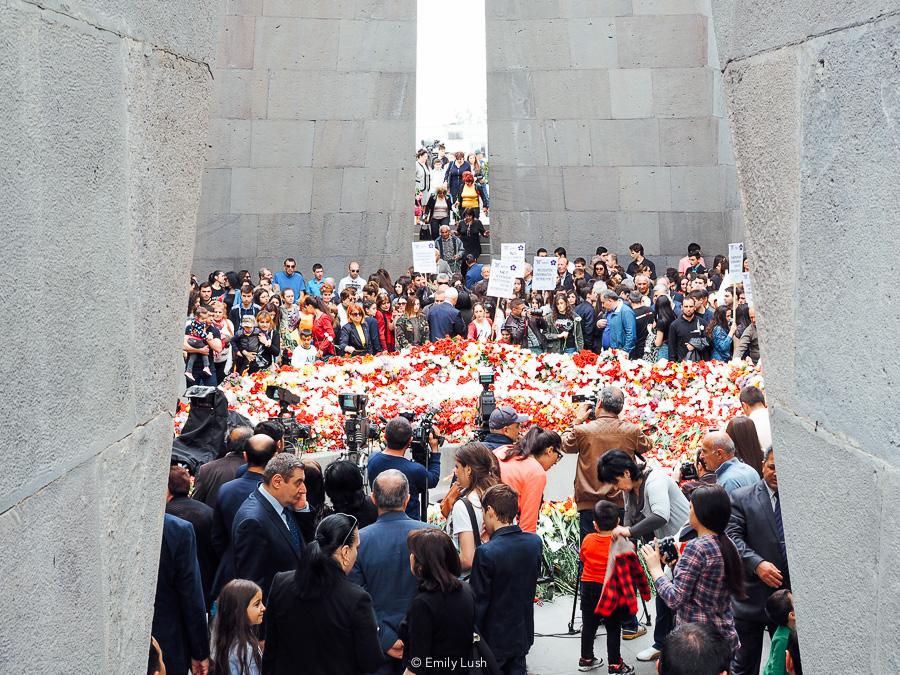
Located next to the memorial, the Armenian Genocide Museum does an outstanding job of leading visitors through the tragic events of April 24, 1915. At times the exhibition is graphic and utterly gut-wrenching, but at the end you come away with a sense of Armenia’s fighting spirit and a new appreciation for the enduring culture, religion and traditions.
- Get there: 10-minute taxi ride from Republic Square
- Opening hours: 11am-4pm Tuesday to Sunday (closed Mondays)
- Cost: Free entry (donations welcome)
27. See a show at the Opera Theatre

One of the best things to do in Yerevan at night is dress up in your fanciest attire and catch a performance at the Armenian Opera Theatre.
The circular theatre on Freedom Square opposite the Cascade is enveloped by gardens. The small lake nearby is called Swan Lake – a tribute to the theatre’s first ballet performance in 1935. During the day, this is a lively area with children riding their bikes around the square and cafes set up along the nearby sidewalks.
There are five statues in the square , including the twin effigies of composer Alexander Spendiaryan and poet Hovhannes Tumanyan, both erected in 1957. Look under foot for commemorative plaques dedicated to famous Armenian artists , Hollywood Walk of Fame style. The eastern side of the theatre with the Opera Club entrance is very photogenic.
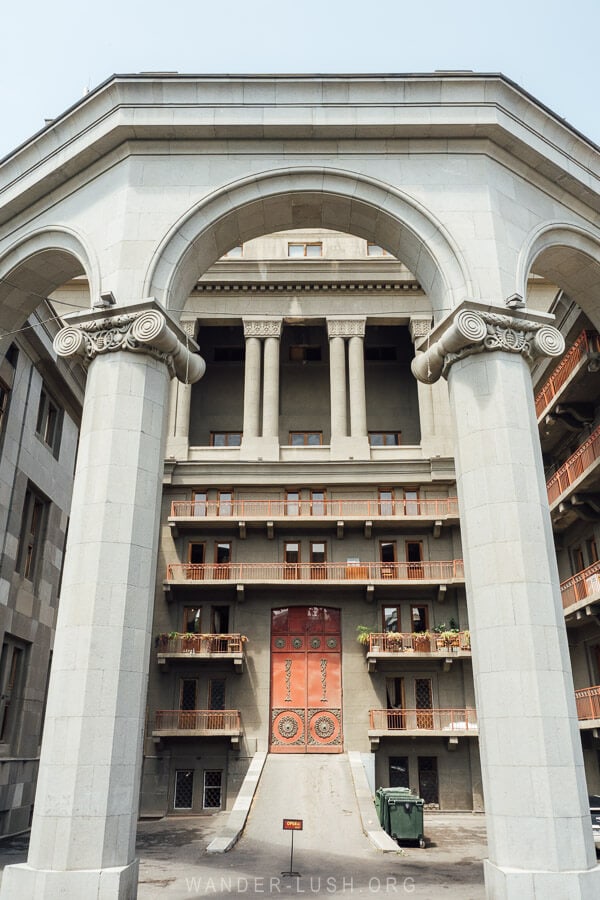
At night, the theatre lights up and the show begins. There are two halls seating 1400 and 1200 people each. When full, the atmosphere is electric. I was lucky enough to see Swan Lake here in spring 2017.
If it’s playing, try to see Anoush , the first opera performed in Armenian that’s been on the playbill here since 1935. Otherwise I would suggest just buying tickets for whatever happens to be on – it’s more about the experience.
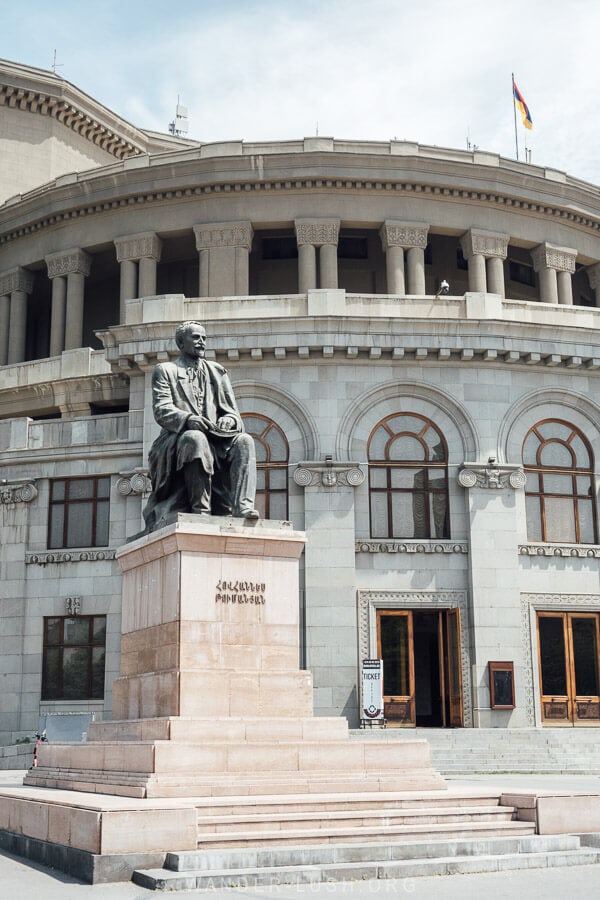
My trip to the opera in Yerevan was quite unusual. I showed up on the wrong night (I had accidentally bought tickets for the previous night’s performance) and ended up being snuck into the back of the theatre by a friendly stewardess! I had to stay on guard for the first half of the performance in case the rightful ticket holder showed up to claim my seat.
It’s recommended to buy tickets (for the correct night!) in advance from the box office out front. Note that there is no bar inside the theatre. Cloak rooms and bathrooms are downstairs.
- Location: Tumanyan Street
- Performance times: Check the program here
28. Feast on lahmajun & other Armenian delicacies
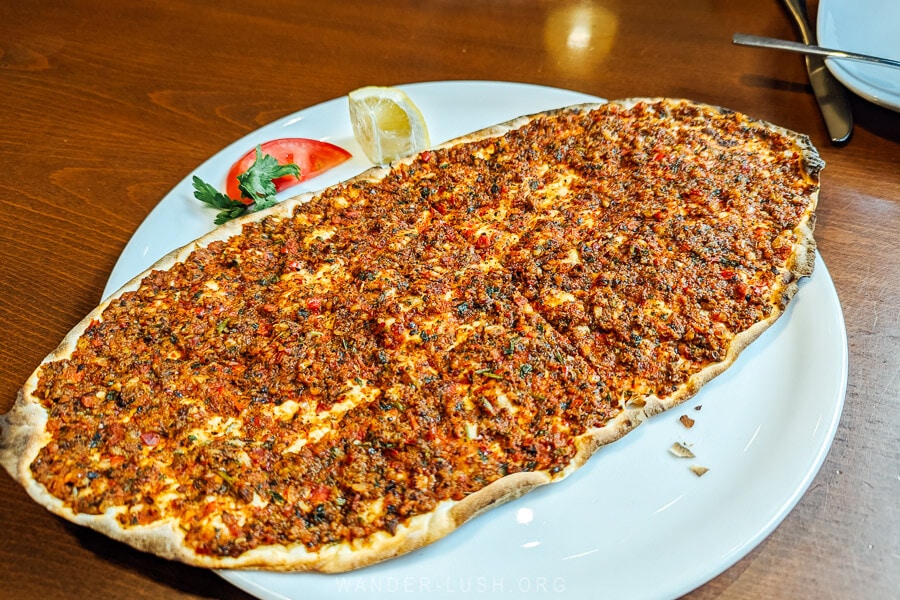
Much like Georgian food, Armenian cuisine is completely underrated . If you’re not familiar with the tastes and textures, eating out in Yerevan will definitely be a pleasant surprise.
One of my favourite dishes and something I always reach for when visiting Yerevan is lahmajun. Though not strictly an Armenian dish (it is a food culture shared with Turkiye, Lebanon and other parts of the Middle East), it is very popular in Yerevan.
Lahmajun is essentially a flatbread topped with various ingredients ranging from vegetables to ground meat to simple Zaatar spice rubs. It always makes for an affordable and tasty meal.
Popular lahmajun joints in Yerevan include:
- Anteb : One of my favourite eateries in Yerevan (see more below), Anteb Restaurant specialises in Western Armenian dishes, including lahmajun.
- Lahmajun Gaidz : For creative lahmajun recipes that incorporate Mediterranean and Middle Eastern flavours.
- Elie’s Lahmajun : A local favourite close to Republic Square.
29. Grab a drink at Mirzoyan Library, Yerevan’s coolest bar
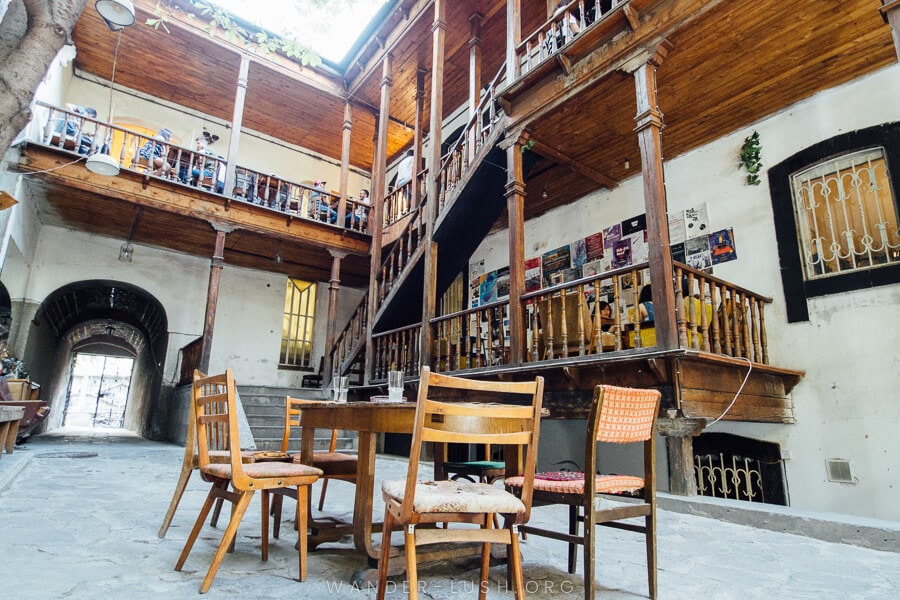
Yerevan nightlife is quite lively and there is no shortage of things to do once the sun goes down. According to my walking tour guide, Yerevan has more than 500 open-air cafes – I’d say that’s a conservative estimate! At night, you’ll find that many of these cafes transform into trendy wine and cocktail bars .
My favourite place to go for a drink in Yerevan is Mirzoyan Library . Set in a historic courtyard and house, it functions as a photography gallery slash library slash cafe during the day. The space was concocted by photographer Karen Mirzoyan to make her personal collection of fine photography books available to other young artists in the city.
In the evening, you can pull up an antique chair and sit on the rickety verandah or just perch yourself on one of the staircases. Wine and beer are served alongside non-alcoholic drinks. You can browse the books while you sip but you can’t take them home – no library cards here!
- Location: 10 Mher Mkrtchyan Street
- Opening hours: Midday to midnight daily
30. Taste Armenian wine at In Vino
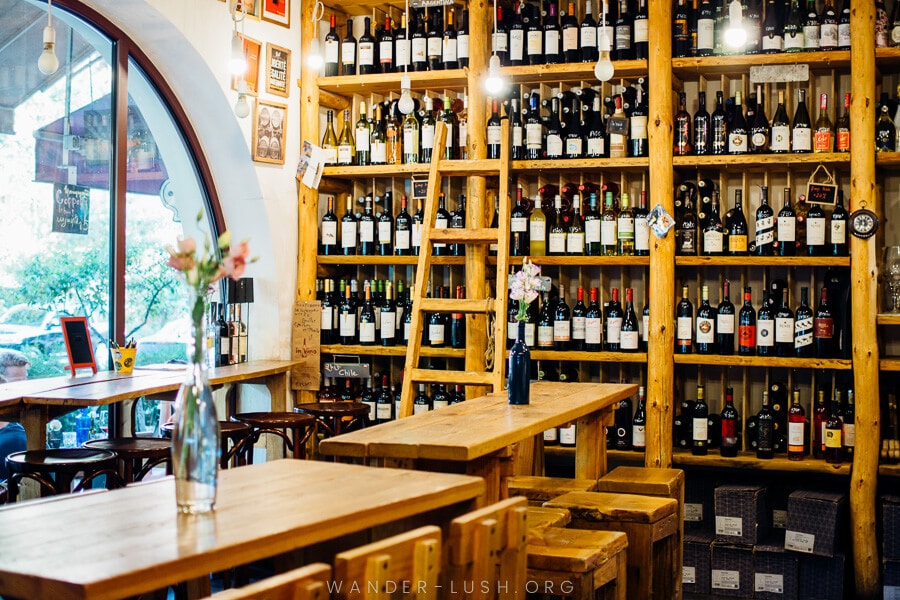
Want to get acquainted with Armenian wine? Yerevan is home to the country’s leading wine bar and shop, In Vino on Saryan Street.
More than 25 wines are available by the glass so you can try a selection of locally produced drops from Areni and Armenia’s other wine-making regions. Prices start from a very reasonable 800 AMD.
For the full experience, pair your plonk with a tasting plate of local cheeses, cured meats and nuts. Delicious desserts also feature on the menu, or for something more substantial you can order a baguette sandwich (sold by the centimetre) or meals from nearby Tapastan.
Formal wine tastings are also available and include 4-6 Armenian wines.
- Location: 6 Martiros Saryan Street
- Opening hours: 11am-midnight daily
- Cost: From 800 AMD for a glass of wine
- Read next: Where to do a wine tasting in Tbilisi, Georgia
BONUS: Learn about the history of Yerevan on a walking tour
The city of Yerevan, like the nation of Armenia, has a long and complicated past. If you really want to sink your teeth into local history and culture while ticking off the major landmarks, then I highly recommend joining a walking tour.
Yerevan is home to an excellent free walking tour program that offers both general and culture-focused itineraries. Tours last 2-2.5 hours (although I ended up spending 4 hours with my guide when we did the introductory tour!), and usually depart from Republic Square. Remember to tip.
If you prefer to explore at your own pace and with your own guide, this private walking tour hits most of the major Yerevan landmarks, including Saint Gregory The Illuminator Cathedral, the Opera Theatre, Cafesjian, and Victory Park.
Alternatively, this Evening Walking Tour of Yerevan starts at the Vernissage Market and is perfect if you’re travelling during summer and want to beat the heat of the day. And for something really special, you can tour Yerevan in a vintage GAZ-M20 Pobeda (nicknamed ‘Stalin’s Car’)!
My favourite cafes & restaurants in Yerevan
Anteb: The first place I go whenever I arrive in Yerevan. This no-frills restaurant specialises in Western Armenian cuisine and serves amazing manti dumplings and lahmajun topped flatbread.
Dargett Craft Beer: If wine isn’t your cup of tea, Armenia has a budding craft beer scene with a growing number of specialty bars in Yerevan. Dargett Craft Beer is the city’s leading brew pub, with artisanal beers on tap, a huge selection of bottles, and a menu of crowd-favourite beer snacks (think fish and chips, onion rings and Poutine). Their own craft beers (including stout, pale ale and pilsners) are made in Armenia on local spring water
The Green Bean Cafe: My go-to in Yerevan for good coffee and light, healthy meals. This cafe has a strong focus on fresh, plant-based food but the menu spans a huge range of offerings. There are 3 branches in the city, including one adjacent to the Cascade and another on Amiryan Street.
Sherep: ‘Elevated’ Armenian fare and scrumptious desserts, including a chocolate mousse with local brandy – yum.
Tapastan: Local wines and Armenian dishes served tapas sharing-plate style.
Dolmama: This restaurant is a bit more pricey but it’s a Yerevan institution so I definitely recommend trying it once. The dolma is excellent – obviously!
Yerevan Map
Click here to open my Yerevan City Map in Google Maps .
Recommended day trips from Yerevan

For budget-friendly guided tours from Yerevan, I recommend travelling with Hyur Service . I have personally used them several times. Guides are professional, drivers safe, and although the itineraries are often long, they usually incorporate lots of stops along the way.
Here are some of the most popular day trip options offered by Hyur and other companies. Some of these places can also be visited independently.
Garni Temple & Geghard Monastery: The 1st-century Garni Temple and medieval Geghard Monastery are within a 15-minute drive of each other and are thus often paired as a side trip from Yerevan. Both are visually spectacular and have a fascinating history. This is my top choice of easy day trip, involving roughly 2 hours of driving in total.
This group tour to Garni and Geghard also includes an Armenian lavash-baking demonstration.
Echmiadzin & Zvartnots: Echmiadzin (Vagharshapat) is home to the stunning Mother See of Holy Etchmiadzin, one of the oldest cathedrals in the world. On the drive from Yerevan, tours often stop at the ruins of Zvartnots Cathedral and the much-photographed ring of columns that frames views of Mount Ararat. Total driving time is around 90 minutes. This trip can also be done independently by public transport ( marshrutka ).
This group tour with Hyur Service runs for 4-5 hours and includes Mother See, several smaller churches and Zvartnots.
Khor Virap: Khor Virap monastery is located roughly an hour from Yerevan, very close to the Turkish border. If you want spectacular views of Mount Ararat, this is the place to go.
This trip to Khor Virap with Hyur includes a wine tasting in Areni and a visit to Birds Cave where some of Armenia’s most important archaeological finds were unearthed. They also offer a private 8-hour combination tour to Khor Virap, Garni Temple & Geghard.
Lake Sevan & Dilijan: Armenia’s largest lake and the beautiful Sevanavank Monastery are under 90-minutes drive from Yerevan. This isn’t my top choice of day trip, but it’s a convenient option if you want some fresh air and lake views.
This budget-friendly group tour offered by Hyur visits Dilijan, Armenia’s ‘little Switzerland’, and two beautiful forest monasteries after Lake Sevan.
Tatev Monastery: This iconic monastery accessed by cable car is in Armenia’s far-south and can be visited in a day – but be warned that it requires a lot of driving (around 4.5 hours each way). I did this day trip on my first visit to Armenia and it was tolerable, but only because the tour made lots of stops along the way, including at the wonderful Noravank Monastery. Read my tips for getting to Tatev from Yerevan here .
This terrific Tatev group tour includes a ride on the Wings of Tatev and a guided tour of Tatev Monastery plus a local Armenian lunch, wine tasting at Hin Areni Winery and a stop at Karahundj (Armenia’s Stonehenge). If you want to pack a lot in, this is my top choice of day trip from Yerevan.
Haghpat & Sanahin: This is another long day trip (6 hours on the road at a minimum). If your itinerary allows, I recommend visiting the two UNESCO monasteries in far-northern Lori from Vanadzor instead. (You can also visit from Tbilisi .)
This private tour to Lori from Yerevan includes hotel pick-up/drop-off, an English speaking guide, and also visits Odzun Monastery in addition to Haghpat and Sanahin.
Headed to Tbilisi next? Check out my list of awesome things to do in Georgia’s capital city and my recommended Tbilisi day trips .
Best time to visit Yerevan
Yerevan is an all-weather city, but there are still defined high/low seasons and times of the year when the forecast is more likely to be on your side.
I would avoid visiting Yerevan in summer (June through to early September) – this is high season when prices go up, plus it’s stifling hot (up to 35 or 40 degrees Celsius in the city). Winters in Yerevan are quite mild, and the temperature rarely drops below zero. January is the coldest month, with average daytime temperatures of 2 degrees.
I first visited Yerevan in spring and still think this is one of the nicest times to visit the city (and Armenia as a whole). May can be a bit rainy, but April/May is generally very pleasant temperature-wise. Outdoor cafes start reopening and you’ll see beautiful flower markets overflowing on every sidewalk. The energy is wonderful.
I had the pleasure of spending Easter in Yerevan and loved observing Easter traditions. I also had a chance to mark Genocide Remembrance Day in Yerevan , a sombre yet heartwarming occasion that commemorates the events on and around April 24, 1915.
Fall (late September to November) is temperate and another nice time of year to visit.
How many days do you need in Yerevan?
To see the highlights, experience Yerevan’s cafe culture and soak up the city atmosphere, I recommend spending at least 2 full days in Yerevan , 3 if possible. You could very easily stay longer – and you might be tempted to!
While you can get a good overview of Yerevan in the space of a day, you will definitely feel rushed and you’ll have to sacrifice on some things.
One of the best things about Armenia is that you can travel almost anywhere in the country from Yerevan and still be back for a late dinner. Thus I also recommend setting aside 1 or 2 additional days for side trips from the capital.
See my favourite day trips from Yerevan listed above.
How to get to Yerevan
Zvartnots International Airport is located 15 kilometres west of Yerevan and is Armenia’s main hub for air travel. The airport is serviced by Qatar Airways, Pegasus, FlyDubai and Wizz Air, making it relatively easy to reach Yerevan from Western Europe, Turkey and the Middle East .
→ Book a private transfer to your hotel in Yerevan here . Prices start from just $13 per group.
If you’re travelling overland, there are several options available for entering Armenia from neighbouring Georgia or Iran. Because of Yerevan’s location and the quality of roads, it’s more convenient to enter from Georgia.
Note that Armenia’s borders with Azerbaijan and Turkey are closed and overland travel is not permitted. If you’re coming from Azerbaijan , you will need to cross through Georgia first. I recommend using the night train to get from Baku to Tbilisi .
How to get to Yerevan from Tbilisi
My preferred way to travel between Georgia and Armenia’s capital cities is on the overnight sleeper train. Trains run every night in the summer high season and every second night in the low season.
Trains are comfortable, safe, fast – and fun. Find my comprehensive guide to the Tbilisi Yerevan train here (and find a code to buy discounted tickets inside).
Marshrutka minivans and taxis are also available. I personally try to avoid long-distance road travel in the Caucasus whenever possible, but if you prefer not to use the railway, then this is another option. The ride takes 5-6 hours on average including border procedures.

Is Yerevan safe for tourists?
Yerevan has very low crime rates overall and although theft and pickpocketing do occur from time to time, the chances of you being targeted as a tourist are very, extremely slim.
In my experience, people in Yerevan are far more likely to shout you a taxi fare or a drink than to try and swindle you (this has happened to me multiple times). Tourist scams do occur, but nowhere near as often as in some Western European capitals.
Based on my own experiences and from talking to other travellers and friends who have lived in Yerevan, this is an extremely safe city overall, even for solo female travellers. I would not hesitate to walk alone down a city street in Yerevan at night, and similarly I would have no reservations about using the metro, visiting crowded places, etc.
That doesn’t mean you shouldn’t exercise common sense and a normal level of caution when visiting Yerevan. Take care of your belongings, avoid carrying large amounts of cash on you, and be mindful of personal space.
Be vigilant when crossing the street. Use a taxi app to book cabs or negotiate the fare in advance. Avoid travelling on the road after dark – traffic and road safety are probably the biggest safety issues for tourists in Armenia, just as they are concerns in neighbouring Georgia .
Protests and demonstrations do occur in Yerevan; it’s best to avoid large gatherings in case things get out of hand.
Is Yerevan expensive? Yerevan travel budget
Much like Georgia , Armenia is an extremely budget-friendly destination overall. Being the capital, Yerevan is one of the more expensive places to visit in the country but it’s still very affordable, certainly by European city standards. Personally I find Yerevan a touch more expensive than Tbilisi.
The official currency in Armenia is the Armenian dram or AMD. At the time of writing 1 USD = 515 AMD .
Here are some approximate costs (per person) based on my most recent trip to Yerevan:
- One night in a mid-range hotel/guesthouse: 14,000 AMD (26 USD)
- Meal in a mid-range restaurant: 4000-7000 AMD (7.50-15 USD)
- Latte in a cafe: 1300 AMD (2.40 USD)
- Bottle of Armenian wine: 3500 AMD (6.60 USD)
- Metro fare: 100 AMD (0.20 USD)
- Taxi fare within the city: 500-1000 AMD (1-2 USD)
- Museum ticket: 1000 AMD (1.90 USD)
A mid-range traveller staying in a hotel/guesthouse, eating out twice a day, visiting museums and using a combination of metro and taxis to get around should budget around 25,000 AMD (47 USD) per person per day for Yerevan.
You can very easily reduce your costs by sticking to free attractions (there are plenty on this list), eating local meals, and staying in budget-friendly hostels or guesthouses.
What are your favourite things to do in Yerevan? If you have any tips, please share them in the comments below.
Things to do in Yerevan: Save it to Pinterest

Armenia Travel Guide
Discover insider tips, itinerary inspiration, and all the best things to see, do and experience in Armenia!
Armenia Essentials
My favourite resources and tools for planning a trip to Armenia.
Find affordable flights to Armenia
Yerevan Airport transfer
Save on museums & transport
Hire a car in Armenia
Get an e-visa for Armenia
Find the perfect accommodation
Book city tours & day trips
Order the latest Lonely Planet
More from Armenia
- The Ultimate Armenia Itinerary
- Things to do in Yerevan , 25 must-sees and alternative spots
- Where to find authentic and meaningful Armenian souvenirs in Yerevan
- Don’t miss the GUM Market , Yerevan’s colourful produce hall
- Tips for being a responsible tourist in Armenia
- The best day trip from Yerevan
- Guide to Gyumri , Armenia’s second city
- Guide to visiting the UNESCO monasteries, Haghpat and Sanahin
- How to travel between Armenia and Georgia by overnight train
- 12 things you should know before travelling to the Caucasus
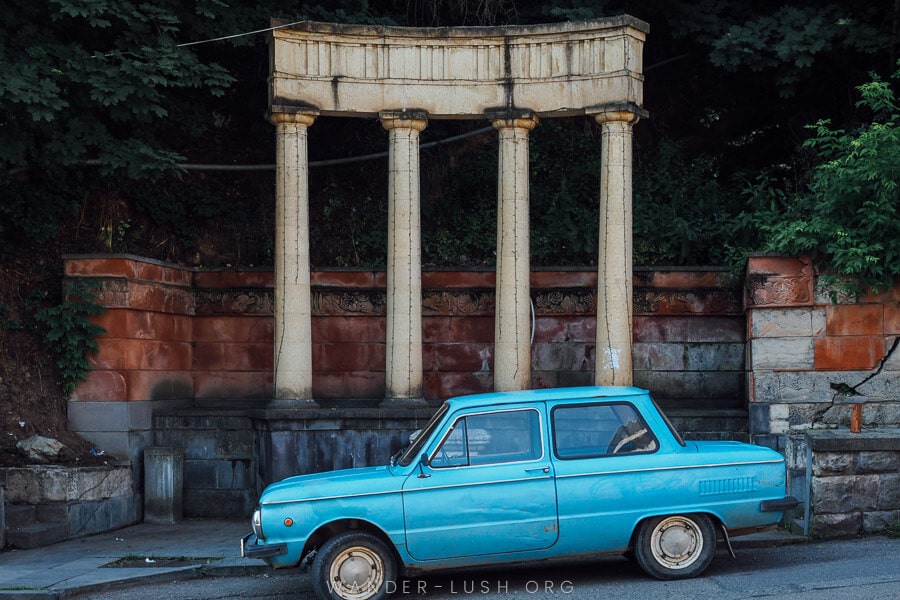
32 Comments
Hi Emily Fantastic web site! Have you visited the Ararat Distillery in Yerevan?, and, do you know of any old record shops in both Armenia and Georgia Thanks Frank
Hi Frank! Yes actually I just visited for the first time a couple of weeks ago. I will be updating this post soon! Are you looking for vintage vinyl specifically? In Georgia the best place for that is the markets – Dry Bridge and Barakholka particularly.
LOVE your write up! went to Georgia/Armenia in 2019 June and LOVED the food, the alcohol,the cities and countries. Advice please: my bday is in March, and I want to take my family to see Yerevan. I LOVED the cafes in the summer. do you think mid-March is a good enough time to introduce my family to Yerevan? I hope so, bc I really want to go and see near my bday (spring break, bc I work in schools and have a 10th grader). thank you?
Thank you Sandy! March is still quite chilly in this part of the world, but I think you’ll still enjoy Yerevan at that time of year. There might be less outdoorsy stuff on (I once visited in April around Orthodox Easter and we had to sit inside to eat most days), but on the plus side it will be nice and quiet.
Your article/blog is so inspiring, we were wondering whether Yerevan/Dilijan is a budget-friendly option to travel from Dubai, and your article says it all. We are planning a 3 day holiday in July. Yes it would be hot, but we are going for it. Your explanation was really helpful, and you have provided so many wonderful options. Planning out an itinerary myself, instead of going through tour agents. So thanks again.
Great Akshaya! Dilijan is a little cooler than the city of course, I think it’ll be quite nice! Enjoy!
One of my my favorite destinations is the observatory on mount Aragats. I’ve been to the telescope many years ago and heard that it is still open for school kids. I was wondering if there are any public options for staying overnight at the Physics Institute and stargazing through the telescope at the observatory.
I had not come across this before but it sounds wonderful! There is something similar here in Georgia at Abastumani. I’m not sure if there is accommodation available but hopefully someone else can answer.
We visited the LUYS book store, which is now called Books 1512. That’s a great find! I remember my first impressions when we were driving from the airport to our hotel, I saw a book store with high security bars, and was laughing that the book store has more security than the exclusive boutiques, but I didn’t realize it was this very store that you mentioned in your blog. It’s so gorgeous inside! I’ve never held such ancient books in my hands before. Thank you!
Great to hear that, Vera! It’s a very special spot. Thank you for the name update!
Been wanting to travel to Armenia since 2008 and tomorrow I actually fly there and your blog on Armenia is getting me psyched! Thanks for many useful tips 😉
Amazing Alejandro! That’s a long time in the making. I hope you love it as much as I do!
So beautiful! It made me even cry when I saw you wrote about Kond as I am from there. I haven’t been to Armenia already 2,5 years, I missed even more my country after reading your incredible descriptions.
Thank you for you comment, Gohar! I hope you get a chance to go back to Yerevan soon. Kond is such an interesting part of the city, I really loved walking those streets and exploring.
I am very excited to be traveling there in May for a week. Do you have a local tour guide that you might recommend? I like to explore but appreciate someone who knows a thing or two. Also, any tried & tested “must see” shops with local flair?
Great to hear! I recommend joining the free walking tour when you arrive.
Here are my favourite shops in Yerevan: https://wander-lush.org/shopping-in-yerevan-armenian-souvenirs/
Enjoy your trip!
Thank you for this amazing information. I left when I was 8 only. I am trying to go back and visit. Hopefully after the pandemic. This is very helpful. I was born in Vanadzor and would love to visit. Thanks again.
I have been to Vanadzor, it’s a lovely city! I haven’t had a chance to post about it yet but I’ll get to it soon. That’s great that you’re planning to go back. You might find this interview I did useful too: https://wander-lush.org/armenia-heritage-tourism/
Let me know if there’s anything at all I can help with. Fingers crossed you can start planning your trip soon!
Great article, informative with colorful pictures, thank you Emily!!
Thanks Sam! Appreciate it 🙂
Emily, thank you for this! I’m an Armenian and am planning to visit for the first time next summer! Thank you for your kind words, I really appreciate it 🙂
Hi Gassia! That’s so exciting! I hope you have fun planning your trip. Feel free to reach out if there’s anything I might be able to help with 🙂
Hi ememelie, I am traveling Armenia right now and it is a pleasure to read your blog if I need some inspiration. Thank you! I was wondering with what kind of camera you’re working? Best, Lena
Thank you, Lena! Glad to hear that 🙂 I use an Olympus OM-D E-M1. It’s a mirrorless digital.
We are planning to visit Yerevan next March , is it enough to explore this city ( and surrounding if possible ) within 4 or 5 days ? thanks in advance for your reply ….
Hi Nurul! Yes, I think 4-5 days would suffice if you’re happy to be busy. In that time you can see the highlights of the city and do a few day trips. Almost everywhere is reachable as a day trip, even Tatev Monastery (I have a post on that too). Consider using a company such as Hyur Service to make things easier.
Yerevan is a wonderful city! I hope you love it!
Could you tell me where you stay in Yerevan, could you recommend the airbnb, or hostel to stay in Yerevan, thanks.
We were in Yerevan for 10 days so we chose to stay at an Airbnb. It was fantastic—one of the best-appointed apartments we’ve ever stayed in, and our host, Arman, was wonderful. Here is the link: https://www.airbnb.com/rooms/17788633
Fantastic read! I didn’t know that about the one million/get a metro thing. I love riding on old Soviet metro systems ☺. Reading through your Caucasus posts you’ve cemented the region in my travel thoughts! I’ve heard lots of great things about Yerevan, your photos capture it beautifully.
Glad to have found your blog!
Thanks so much, Kim! Yerevan is a wonderful city. I’m sure you would love it!
Thank you for sharing your experience! My dad’s family is Armenian and I have always wanted to visit the country.
Thank you, Elizabeth! We really enjoyed Armenia, particularly the warm hospitality. I hope you get to visit soon!
Comments are closed.
- Subscribe to future posts
Visit Armenia
How can we help you?

Forgot password?
Company registration
Book your perfect tour to Armenia
Classical armenia.

Tasty Armenia

Daily tours
Yerevan - garni - geghard -yerevan.

Price - 3 EUR
Yerevan - sevan - tsakhkadzor - yerevan.

Price - 0 EUR
Yerevan - echmiadzin - zvartnoc - yerevan.

Price - 5 EUR

Tours for all family. They will not leave indifferernt to tourists of any age.

Culture-historical
Culture-historical tour is open new culture and historical centres of Armenia.

Gastro Tour
For Armenians, food is a ritual and art. They cook and eat here with a soul in the full sense of the word, and guests are fed with pleasure.

Festivals and holidays in Armenia
Fantastic tour, the best opportunity to attend the best festival of the year.

Weekend tour
The tour program designed for three days includes a city tour, a visit to the religious center of Armenia – the First Cathedral of Saint Echmiadzin, the pagan temple of Garni, the monaster of Khor Virap, the Geghard Monastery complex carved in rock, as well as a degustation of real Armenian wine in Areni factory.

Akhtala was built in the late tenth century by the Kiurikids, a branch of the Ba...

Amaras Monastery has played a strong role in the propagation of the Armenian alp...

Amberd was a midcentury fort-city. It was built during the 10th century, 7 km. t...

Byurakan Observatory
The Byurakan Astrophysical Observatory, or Byurakan Observatory is an astronomical observatory owned...

Tsaghkadzor
Tsaghkadzor is a city located in Kotayk Region. The city distance from Yerevan i...

The resort town Dilijan surrounded by the Lesser Caucasus mountain-range lies to...

Jermuk takes its unique place among the resorts, tourist areas and cities in Arm...
Do you have a question ?
Your feedback is important for us.
Your feedback
Please report us if you have any questions about Visit Armenia.
Visit Armenia
Visit armenia, it is beautiful., why armenia, centuries old centuries beautiful visit armenia.
To visit Armenia is to travel back in history and feel the spirit of more than 41 centuries. Experience first hand the “country sheltered by Biblical “Ararat” home of Noah’s Ark; the land where human kind was reborn.
Armenia offers a little something for every person.
Rich with historical churches, monasteries, monuments, and magnificent masonry, this country that was the first to adopt Christianity and proclaim it as its state religion in 301 AD is a unique treasure for those interested in great events.
Should your interests lie in nature, the beautiful Armenian Plateau ( the chain of mountains in Armenia which is situated in the Alps-Himalayan mountain system) with hidden lakes, including the mysterious Lake Sevan, waterfalls, torrents, rivers, springs, valleys, highlands and rich forests, clearly evidence the miracles of nature. The topography of land and the man-made wonders of centuries old architecture, ruins, churches and monasteries bring to life the history of one of the world’s most ancient nation and culture. Armenia served as a cross road of the East and West for 10 centuries as a bridge between Asia and Europe.
With a complex terrain of diverse landscape, full of vegetation and ecosystems, this country located with different floustic regions and diverse climate conditions offers spectacular flora and fauna and is a must see for the nature lover. Varied species of vertebrae and non-vertebrates find their homes in Armenia which also serves as the skyway of migrating birds. Mountaineers and hikers will enjoy the slopes of Mount Aragats. While, during the months of January to March, skiers should try the slopes at Tsakhadzhor (valley of flowers).
Life today in Yerevan is assimilated with the harmonious fusion of past and present. The people take great pride in their traditions, culture, religion, arts and crafts, delicious cuisine and sincere hospitality. From museums to theaters, an opera house, parks, restaurants, open cafes, casinos, discos, clubs, jazz restaurants, and other entertainment spots, Yerevan is alive, bustling and inviting. Most of all, the warmth and friendly manner of the people will make your visit unforgettable. One visit is never enough. This land of old and new has a gravitational pull to all who visit. Don’t be surprised if you book your next visit to Armenia while you are still in Armenia. Whether or not your heritage is Armenian, you will feel right at home and will not want to leave this beautiful land and people.
VISIT ARMENIA, IT IS BEAUTIFUL.
The idea of “VISIT ARMENIA – IT IS BEAUTIFUL” came to me in 1998 when I first visited Armenia and personally experienced the beauty of the country and its people. Since then I have been diligently working to turn this idea into reality.
I am an individual who lives in California, and have been going to Armenia every year since my first visit. I am a seasoned traveler to many countries throughout the world, and have come to the conclusion that there is no place like Armenia. Each visit to Armenia has been a new experience, with new places to see and new things to do. For this reason, I have decided to expand upon my idea and introduce it to the public.
The idea is to promote tourism to Armenia. Travel and tourism is one of the most important things for a country. In addition to its positive impact on the economy, it promotes peace, understanding and goodwill amongst people. Cultural exchange is a fascinating advancement for the growth of a nation.
Not only will a visit to Armenia help the country’s tourism, economy and growth, it will give the traveler an unforgettable vacation with memories to cherish for years to come. In fact, Armenia is not only for Armenians. It is a place for all people to enjoy. Tell your friends, Armenians and non-Armenians alike. VISIT ARMENIA – IT IS BEAUTIFUL.
Join me in promoting the slogan/logo of “VISIT ARMENIA – IT IS BEAUTIFUL”. This can be done by individuals or entities simply by placing the slogan/logo in all media forums (television programs, newspapers, magazines, publications, etc) as well as through school and church publications, or any time an individual advertises and/or sponsors in ad books, school yearbooks, newsletters, etc. It costs nothing to add this slogan/logo to any writing that will already be published or shown on television on programs that will already be aired.
Take a first step to introducing ARMENIA to all who see the slogan/logo. Be a part of Armenia’s advancement. The truth is: ARMENIA is really beautiful; Visit it. Once you see Armenia with your own eyes, you will understand why it is so important for me to introduce this idea and Armenia to you.
CALL YOUR PROFESSIONAL TRAVEL CONSULTANT TODAY See you in Armenia soon.
CHRISTIANITY IN ARMENIA
Armenia is a country of old legends and Biblical stories. It is said that on his descent from Ararat, Noah first stepped onto this land and as a result of his blessings and Christian faith, Armenia has survived many foreign invasions through centuries and is a thriving republic presently. Armenia has hundreds of unique Christian monuments, amazing sites, waterfalls, Skyscraping Mountains and wonderful people with rich heritage and warm hospitality. The blue Lake Sevan and a shining sun almost eight months of the year will be your friendly guide throughout Armenia. Even the fruits carry the spice and smell of the sun. You will find in Armenia a society rich with cultural and artistic life, surrounded by beautiful architecture.
In 2001 Armenia celebrated the 1700th anniversary of the adoption of Christianity as a state Religion. The history of Christianity in Armenia refers to the time when Christ’s Apostles St. Thaddeus and Bartholomew preached in Armenia around 100 AD. According to legend, at the end of the 3rd century King Trdat III begun persecuting Christians in Armenia. He executed a group of thirty-seven Christian virgins who had fled to Armenia to escape Roman persecution. The leader of this group was Gayane, who, along with Hripsime is revered as one of the founding saints of the Armenian Church. After committing this crime, King Trdat became insane. The sister of Trdat, Khosrovidoukht, had a dream in which a man told her that the persecution of Christians must stop. She told her brother that he would be cured if Gregory the Illuminator were released from Khor Virap, where he was imprisoned. The King agreed to release Gregory. Gregory restored Trdat’s health, who adopted Christianity.
In 301 King Trdat declared Christianity a state religion and Armenia thereby became the first Christian state to adopt Christianity as its religion. Later, Gregory had a vision in which Christ descended from Heaven and struck the earth at the town of Vagharshapat with a golden hammer. Following this, Gregory had a vision of a great Christian temple rising from the ashes. Gregory built a reproduction of the church. He renamed Vagharshapat as “Echmiadzin” (which means “the Descent of the Only-Begotten” in Armenian). Because of his role in bringing the light of Christ to the Armenian people, St. Gregory is called “the Illuminator” and is venerated as the patron saint of the Armenian Church.
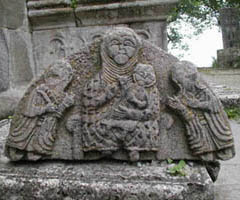
- Consular service
Visa requirements for foreigners
If you are traveling to Armenia, you might need a visa for your trip. Use our visa search tool below to enter your citizenship country and travel document type to determine if you are required to obtain a visa or not.
Visa requirements for Armenian citizens
Information is available only in Armenian
To apply for E-VISA please visit https://evisa.mfa.am
Download visa application form (.pdf).
List of countries whose nationals are unilaterally exempted from the requirement of obtaining a visa.
List of countries , with which Armenia has a visa-free regime according to bilateral and multilateral agreements.
Holders of all other national passports and travel documents, including UN Laissez-Passer, are required to obtain an entry visa.
Citizens of foreign countries for whom a visa-free regime is set can stay on the territory of the Republic of Armenia for no more than 180 days during one year if no other term is defined by the international agreements of the Republic of Armenia.
List of countries nationals of which could apply for visitor visa only with invitation. (the list of documents required for the invitation). This limitation is obsolete for the citizens of those countries of Armenian nationality.
The Ministry of Foreign Affairs of Armenia issues and extends Official and Diplomatic visas, as well as issues e-visas . Visitor visas are extended by the Migration and Citizenship Service of the Ministry of Internal Affairs of the Republic of Armenia.
Armenian visas are issued for a maximum of 120 days with the possibility to extend for another 60 days if no other term is defined by international agreements of the Republic of Armenia.
Nationals of countries who need the invitation to obtain a visa
You can see the list of countries, citizens of which can obtain an Armenian visa only upon invitation and only at the diplomatic representations of consular offices of the Republic of Armenia, by the following link:
https://www.mfa.am/en/invitation_only
How to provide an invitation
Invitations could be submitted through the unified portal https://e-request.am/en
1. Invitation sample (PDF) 2. Invitation template - editable (MS Word)
Invitations can be presented by:
- Legal entities registered in the Republic of Armenia,
- Government agencies and local self-government bodies of the Republic of Armenia,
- Embassies, consular posts, and international organizations or their representative offices accredited in the Republic of Armenia.
Individuals submit invitations to the Migration and Citizenship Service of the Ministry of Internal Affairs of the Republic of Armenia.
Required documents
- An invitation issued in the prescribed form on the organization's letterhead, signed and sealed,
- Copy of the passport of the invited person,
- Visa-application ,
- Receipt for payment of the consular fee. The consular fee is AMD 5,000 (five thousand), which can be paid at any commercial bank to the following treasury account number 900005162129 or online by the following link:
https://www.e-payments.am/en/state-duties/step3/service=1077/
Arrival to Armenia
Foreigners enter the territory of the Republic of Armenia through border-control points. For entry, a foreigner must have a valid passport, entry visa or a document of residency status unless Armenian laws or international agreements define no other procedure.
Minor foreigners may enter Armenia accompanied by parents, a parent or any other legal representative or if one arrives to his parents, a parent, other legal representative or a receiving organization.
If a foreigner arrives in Armenia without any valid identity document or visa or if he gets a refusal to obtain an Armenian visa he cannot enter the territory of the Republic of Armenia and must be returned to his country of origin or to the country he arrived to Armenia from unless the aim of arrival is to apply for asylum or refugee status.
Departure from Armenia
Foreigners can leave Armenia upon a valid passport and a document validating their prior stay in Armenia if laws or international agreements of Armenia define no other term.
Visa Extension
To extend the visa duration, it is necessary to contact the Migration and Citizenship Service of the Ministry of Internal Affairs of the Republic of Armenia and submit the visa extension application, providing the reason for extending the stay in Armenia.
DOWNLOAD VISA EXTENSION APPLICATION FORM (.pdf)
For additional information, please email us at [email protected] or call us at (+37460) 620616, 620516, and 620553.
Cookies on GOV.UK
We use some essential cookies to make this website work.
We’d like to set additional cookies to understand how you use GOV.UK, remember your settings and improve government services.
We also use cookies set by other sites to help us deliver content from their services.
You have accepted additional cookies. You can change your cookie settings at any time.
You have rejected additional cookies. You can change your cookie settings at any time.
- Passports, travel and living abroad
- Travel abroad
- Foreign travel advice
Warnings and insurance
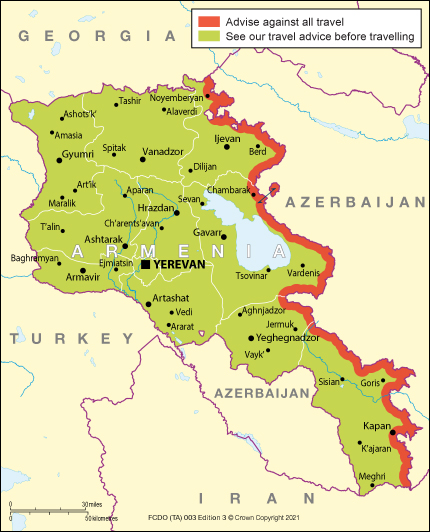
The Foreign, Commonwealth & Development Office ( FCDO ) provides advice about risks of travel to help British nationals make informed decisions. Find out more about FCDO travel advice .
Areas where FCDO advises against travel
Your travel insurance could be invalidated if you travel against FCDO advice.
Armenia-Azerbaijan border
FCDO advises against all travel to within 5km of the full eastern border between Armenia and Azerbaijan
M16/H26 road between Ijevan and Noyemberyan
FCDO advises against all travel along the M16/H26 road between the towns of Ijevan and Noyemberyan.
Find out more about why FCDO advises against travel .
Before you travel
No travel can be guaranteed safe. Read all the advice in this guide as well as support for British nationals abroad which includes:
- advice on preparing for travel abroad and reducing risks
- information for women, LGBT+ and disabled travellers
Follow and contact FCDO travel on Twitter , Facebook and Instagram . You can also sign up to get email notifications when this advice is updated.
Travel insurance
If you choose to travel, research your destinations and get appropriate travel insurance . Insurance should cover your itinerary, planned activities and expenses in an emergency.
Related content
Is this page useful.
- Yes this page is useful
- No this page is not useful
Help us improve GOV.UK
Don’t include personal or financial information like your National Insurance number or credit card details.
To help us improve GOV.UK, we’d like to know more about your visit today. We’ll send you a link to a feedback form. It will take only 2 minutes to fill in. Don’t worry we won’t send you spam or share your email address with anyone.

UN Assistant Secretary-General visiting Armenia
UN Assistant Secretary-General, UNDP Assistant Administrator and Director of the Regional Bureau for Europe and the Commonwealth of Independent States (RBEC) is visiting Armenia.
Ivana Živković, UN Assistant Secretary-General, UNDP Assistant Administrator and Director of the Regional Bureau for Europe and the Commonwealth of Independent States (RBEC) on 5 May arrived on a four-day visit to Armenia.
The objective of Ms. Živković’s visit will be to review UNDP’s partnership with the Government of Armenia, familiarize herself on the ground with UNDP key interventions, including the response to refugee crisis, as well as discuss the UNDP development agenda and key priorities with international and national counterparts.
Together with UNDP Resident Representative in Armenia, Natia Natsvlishvili, she will meet with the President of the National Assembly to launch a new project on parliamentary democracy in Armenia, the Deputy Prime Minister, and the Deputy Foreign Minister. She will also hold discussions with the UN Country Team, members of the diplomatic corps and development partners, and civil society. Ms. Živković will visit UNDP project sites and meet with beneficiaries in Gegharkunik, Tavush, Ararat, Vayots Dzor, and Syunik regions.
Ivana Živković assumed her duties in September 2022. Prior to her appointment, she served as Director-General for Economic Affairs and Development Cooperation in the Ministry of Foreign and European Affairs of Croatia.
Ms. Živković holds a Master’s degree in International Economics and a Bachelor of Science in Economics from the University of Zagreb.
Related Articles

Semi-final 1: Ten countries qualify for Eurovision 2024 Grand Final

Eurovision Song Contest 2024: First Semi-Final

Armenia will make every effort to organize 2027 World Weightlifting Championships at a high level – PM

Ambassador visits Armenian pavilion at ATM Dubai 2024 exhibition

Armenia ready to sign peace deal with Azerbaijan by November on the basis of agreed principles – PM

Putin sworn in for fifth term as President of Russia

We’re sorry, this site is currently experiencing technical difficulties. Please try again in a few moments. Exception: request blocked
- International edition
- Australia edition
- Europe edition
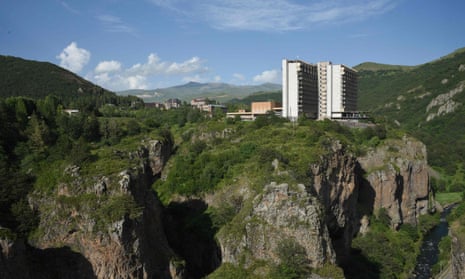
Armenia turns towards west in search of allies amid Azerbaijan tensions
Series of traumatic defeats has prompted a rethink in what was once seen as the most pro-Moscow of the ex-Soviet republics
W ith its waterfall, hot spring, orchards full of apricot blossom and a gorge through which the swollen Arpa River races, the town of Jermuk since Soviet times has been one of the most visited in Armenia. That was until just after midnight on 12 September 2022 when Azerbaijani forces surged over the border , advancing about 4 miles in a two-day push that left them in full control of the long mountain ridge overlooking the town.
“It was truly frightening. The forest was set on fire. It was like lightning coming down on us. It went on for two days. We did not know how it would end, and how to get our families out,” recalled Rubik Avakelyan, 69, sitting on a park bench.
The initial three-hour attack included mortars, heavy artillery and drones. The whole town now lives in fear of a further attack. “We did not know which way to turn, but I do not see much future here,” Avakelyan said.
Closer to the frontline, buildings and a fish farm lie abandoned, adding to the sense of foreboding and decay that contested borders can bring.
“The Azeris are fortifying their positions and we think when the snow is over they are planning something else,” said Vahagn Arsenyan, the mayor of the 9,000-strong town. “We expect a new aggression at any time, and right now and here where we are sitting in this office is a visible target for them. They have damaged us economically and psychologically. The hotel rooms were usually 90% occupied.”
Tourism income is down 60% as visitors are put off by the presence of Azerbaijan’s forces only 3 miles away. “If there is no economy, families want to leave,” Arsenyan said.
The quest for suitable allies is a constant in Armenia’s history, as testified to by a statue of a 17th-century Armenian diplomat, Israel Ori, on the outskirts of town. Ori dedicated his life to the country’s liberation from the Persian and Ottoman empires. He travelled through Europe fruitlessly in search of countries willing to help liberate Armenia , before finally arriving at the court of Peter the Great to plead: “We do not have another hope, we hope for God and your country.”

Armenia’s prime minister, Nikol Pashinyan, is caught in a similar predicament. He has invested hope in building alliances to fend off the “Turks”, as many Armenians call the Azeris. However, it is not to a distracted Russia that he has turned but to the west, a gamble for this lonely democracy in a region of authoritarianism.
It is a remarkable turnaround for a country that used to get 98% of its arms from Russia and was seen as probably the most pro-Moscow of the former Soviet republics at the time of the Soviet Union’s dissolution in 1991.
Pashinyan came to power in a velvet revolution in 2018. Faced with intractable conflicts, he did not initially seek to break the security partnership with Russia. Landlocked, with two of its four borders – with Turkey and Azerbaijan – closed, Pashinyan could hardly afford to alienate Russia in what Moscow regarded as its back yard.
But a rethink has been prompted by a series of traumatic defeats at the hands of the better trained and better armed Azerbaijan in 2020 and 2022, followed by the expulsion of more than 100,000 Armenians from the enclave of Nagorno-Karabakh in September 2023. On the latter two occasions, Russia, burdened by the war in Ukraine, failed to come to Armenia’s protection, in effect trashing security guarantees.
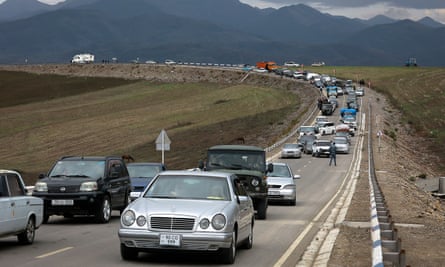
Popular anger at the perceived betrayal by Russian peacekeepers, especially among some of the expelled refugees from Nagorno-Karabakh , is intense.
Sitting in a rudimentary government-provided flat in the capital, Yerevan, Ruslan Hayrapetyan, a former police officers, said he repeatedly went to the Russian peacekeepers with carefully documented incidents of Azeri attacks on farmers, only to be told by the Russians: “Do you think we are here to die for you?”
His wife, Nina, said that as Azerbaijan pushed into the enclave after an eight-month food blockade, her family spent two days hiding from the shelling in shelters and were then told that the best that Russians could do was open a road out of their town, Martuni, to the capital, and from there they would be taken on buses through the Lachin corridor to Armenia.
She said the town administrator told them: “In 10 hours the Azeris will enter the town. You may stay, but I will remind you of the massacres of 1915. You will be tortured, raped and beheaded.”
Ethnic Armenians fled what had been their homeland for generations, in what they regarded as a piece of ethnic cleansing, and some of their captured political leaders still languish in jails in Azerbaijan. Pashinyan, in an interview with a group of British journalists, admitted he believed the refugees now scattered around Armenia would never be able to return.
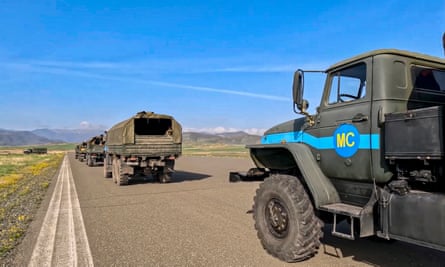
The episode caused the rupture in Armenian-Russian relations and further polarised an already divided Armenian society. Russia’s peacekeepers have this month left Nagorno-Karabakh ahead of schedule. In a sign of an ideological chasm, the speaker of the Armenian parliament this week attacked Russia’s Ukraine policy, leading to claims of Russophobia from Moscow.
National assembly members complain that Azerbaijan seems unconstrained and determined to raise more demands. “My profession, international law, is dead,” said Vladimir Vardanyan, the chair of the legal affairs committee. He warned of a new era of imperialism in which countries such as his own were squeezed.
“Each and every empire has been interested in increasing its land, and since we currently have a situation where the traditional alliances built at Potsdam [and] Yalta are no longer operating, sovereignty becomes ever more vulnerable,” he said. “It’s important we build a consensus about the future of this region because if we do not, we will have a more imperialistic world than in the 19th century.”
In his tiny office in Yerevan, Tigran Grigoryan, an articulate thinktanker, blamed the “fiasco” in Nagorno-Karabakh on the fact that the war in Ukraine had distracted and weakened Russia. He said: “Relations with Azerbaijan turned out to be more important for Russia than fulfilling its obligations to Armenia. President Ilham Aliyev [of Azerbaijan] has seen this power vacuum and the military imbalance between the two countries to make threats and extract ever more unilateral concessions.”
This month Pashinyan ceded four unoccupied border villages in the north-eastern province of Tavush back to Azerbaijani control after three decades. It was billed as the first step in the negotiated process of defining the borders between the two countries along the boundaries that existed at the time of the Soviet Union’s dissolution.
Accused by the opposition of endless capitulation, Pashinyan insisted the alternative would have been war. The deal sparked days of protests by villagers, leading to as many as 80 arrests in the capital.
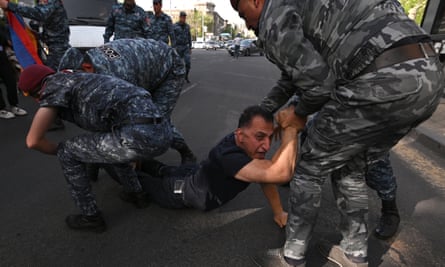
Emotions had already been running high since it was the anniversary of the Armenian genocide, a time when tens of thousands of Armenians, carrying carnations and roses, process to the monument that commemorates a genocide that not all countries, including the UK, recognise.
“Virtually everyone in Armenia has one ancestor or relative who was either killed in the genocide or forced to leave its ancestral home,” Rubinyan said.
The most visible example of the pivot has been since February 2023 the deployment of a 200-strong unarmed EU civilian monitoring mission that has already amassed more than 2,000 patrols from six bases on the Armenian side of the border. With their blue flags, Jeeps and binoculars, they observe Azerbaijani troop movements and send copious daily reports back to Brussels. The staff seem convinced they provide reassurance when tensions and disinformation flourish.
Markus Ritter, the mission’s director, defended its limited objectives. “We can calm things down. We have become a stabilising factor,” he said. “If you compare the situation before the deployment and afterwards, there is a difference.”
But in parts of southern Armenia, Russia blocks his observers from operating. Ritter admitted: “This is a country that is desperately looking for friends and allies.”
Armenia is now buying weapons from India and France, and on 5 April the EU and the US pledged to provide Armenia with €270m and $65m respectively.
The new partnership is designed to start easing Armenia’s heavy dependence on the Russian markets and energy. But it is a very modest package, prompting one Armenian diplomat to complain privately: “I fear we are being led like lambs to the slaughter.”
- Nagorno-Karabakh
Most viewed

IMAGES
VIDEO
COMMENTS
Countless museums and galleries are scattered across Armenia, each of which reveals a new layer of our culture. To catch the visual marvels of Armenia, visit some of the most prominent museums and galleries in Yerevan and the surrounding regions. Check out the list below and make sure to visit a few on your next trip.
Etchmiadzin Cathedral, St. Hripsime, Zvartnots church ruins, and others are protected by UNESCO World Heritage today and are some of the top things to see in Armenia. 6. UNESCO World Heritage Sites in Armenia. As just mentioned, the churches and cathedrals in and around Etchmiadzin are protected by UNESCO.
Armenia is home to countless beautiful monasteries and they are often found in areas of truly outstanding natural beauty. Armenia's capital, Yerevan, is one of the most rapidly developing cities in the whole of Europe as the nation continues to embrace tourism. Let's have a look at the best places to visit in Armenia! 1. Yerevan
4. Yerevan Park. Escape to Yerevan Park - the world of never-ending joy and unstoppable adventure! The region's largest theme park offers 27 indoor and outdoor kid, family, and thrill rides from top European manufacturers, huge double-story playground and Ice Skating Rink during the winter season. The attractions include a 40m high Booster ...
Europe. Few nations have histories as ancient, complex and laced with tragedy as Armenia (ՀԱՅԱՍՏԱՆ). And even fewer have a culture that is as rich and resilient. This is a destination where you will be intrigued by history, awed by monuments, amazed by the landscape and charmed by down-to-earth locals. It's not an easy place to explore ...
Mount Khustup. One of the most beautiful and iconic mountains in Armenia is Mount Khustup in Syunik. It is a dream destination for hikers, rock climbers, campers, and lovers of rich and wild nature. Khustup is 3201 meters high and is covered with alpine meadows and forests and is located near Kapan city.
Armenia has a generous visa policy that allows passport holders from 35+ countries (including the US, the European Union and Australia) to visit visa-free for up to 180 days within a year. If you're not on the visa-free list, you may be eligible to apply for a visa on arrival (available at both air and land borders) or an e-visa.
2. Visit Yerevan. Known as Armenia's "Pink City" for the rose-colored volcanic material used for much of the city's buildings, Yerevan is home to wide tree-lined boulevards, busy town squares, and a thriving cafe culture. Try the city's famous dark coffee; it's rich, sweet, and packed with caffeine. 3.
The Best Places To Visit In Armenia. Now that you know the basics of the country, it's time to check out the best places to visit in Armenia. Yerevan. The capital is a great place to start you trip and spend a day or 2. Contradictory to what you might expect from a Soviet era city, it is quite metropolitan.
Visit Vanadzor in the north and Goris in the south, both gateways to incredible nature. Spend a day on sparkling Lake Sevan , Armenia's jewel, spend a night at the Soviet-era Sevan Writers' House , find solitude in Dilijan National Park , home to the country's best hiking trails.
If you are planning to spend more days in Armenia, there are many other places you can visit. Day 7 Tour Option. Armenia: Private Tour to Haghpat and Sanahin Monasteries; Armenia Itinerary #2: Nature and Activities. To add this map to your Google Maps account, click the 'Star' icon next to the map name.
Day 5 - Lake Sevan. Using Dilijan as a base, use the fifth day of your time in Armenia to head to beautiful Lake Sevan. As one of the largest alpine lakes in the entirety of the Eurasian continent and certainly the largest in the region, Lake Sevan is a gorgeous place to visit that is steeped in history.
Visit their website for the most current visa information. Armenian law requires that Armenian citizens, including dual nationals, enter and depart Armenia on Armenian passports. Even if you naturalized in the United States, the Government of Armenia may still consider you an Armenian citizen. Children born in the United States to two Armenian ...
It's impossible to visit the capital of Armenia, Yerevan, without noticing its magnificent natural landmark, Mount Ararat. This emotive and awe-inspiring mountain is beautiful in any season. Traditionally, Mount Ararat was the symbol of the motherland for all Armenians, and it remains so today. Ararat is known as a Biblical mount, as it was ...
Yerevan is one of my all-time favourite cities and a place I never tire of visiting. This curated guide to Armenia's capital city brings together 30 of my favourite things to do in Yerevan, including must-sees, the best free activities, and quirky and alternative attractions.. On my first visit to the Caucasus, Armenia fell smack bang in the middle of my itinerary.
The leading tour operator of Armenia . Weekend tour. The tour program designed for three days includes a city tour, a visit to the religious center of Armenia - the First Cathedral of Saint Echmiadzin, the pagan temple of Garni, the monaster of Khor Virap, the Geghard Monastery complex carved in rock, as well as a degustation of real Armenian wine in Areni factory.
Best Places to visit in Armenia 🇦🇲#Armenia is well-known for its stunning scenery, food, culture, and history. Since Armenia was the first country to embra...
9. Garni Temple. 1,211. Historic Sites. Temple of Garni The Temple of Garni is a classical Hellenistic temple in Garni, Armenia. It is perhaps the best-known structure and symbol of pre-Christian Armenia.The temple was dedicated to Mythra, a deity popular in the Near East which became the patron goddess of the Roman Empire in the period before ...
Best time to visit Armenia. Autumn is the best time to visit Armenia. Days are long, sunny and mild with beautiful colours in the trees, and everywhere you go there are the fruits of the harvest. Armenia's mountains, valleys, canyons and forests, result in a range of microclimates, with weather conditions varying significantly by altitude.
To visit Armenia is to travel back in history and feel the spirit of more than 41 centuries. Experience first hand the "country sheltered by Biblical "Ararat" home of Noah's Ark; the land where human kind was reborn. Armenia offers a little something for every person. Rich with historical churches, monasteries, monuments, and ...
To apply for E-VISA please visit https://evisa.mfa.am DOWNLOAD VISA APPLICATION FORM (.pdf) List of countries whose nationals are unilaterally exempted from the requirement of obtaining a visa. List of countries, with which Armenia has a visa-free regime according to bilateral and multilateral agreements. Holders of all other national passports and travel documents, including UN Laissez-P
Armenia-Azerbaijan border FCDO advises against all travel to within 5km of the full eastern border between Armenia and Azerbaijan . M16/H26 road between Ijevan and Noyemberyan FCDO advises against ...
The objective of Ms. Živković's visit will be to review UNDP's partnership with the Government of Armenia, familiarize herself on the ground with UNDP key interventions, including the response to refugee crisis, as well as discuss the UNDP development agenda and key priorities with international and national counterparts.
Visit the U.S.! U.S. Citizen Services. Alerts and Messages. Alerts and Messages for U.S. visitors to Armenia. See all Alerts and Messages. Emergency Assistance. U.S. Citizens with emergencies, please call (+374)10494585. ... On the 2nd of May 2024, U.S. Ambassador to Armenia Kvien, on behalf of the Government of the United States of America ...
The quest for suitable allies is a constant in Armenia's history, as testified to by a statue of a 17th-century Armenian diplomat, Israel Ori, on the outskirts of town.